AMI This Week Blog: Adaptive Rock Climbing with Alex Smyth
Adaptive Rock Climbing

A man smiles into the camera.
By Alex Smyth
In an upcoming episode of AMI This Week, we will be airing a segment that I filmed with the Canadian Adaptive Climbing Society. They are a group that works to make rock climbing accessible for everyone and they are an amazing group who want to share their passion for climbing with others.
We originally shot this segment in February, and at the time it was a lot of fun to meet with organizers, volunteers, and the CCB Rocks group. They were all so friendly and excited to do some rock climbing and that was great to see!
However, as I look back at the segment now, it becomes a bit jarring to see the crowds of people enjoying themselves without any idea of what would soon change. So, I am curious to find out if others have the same feeling as I do when watching the segment.
That said, it was a ton of fun to watch Liz and Neisha each conquer new challenges at the gym. Hearing their stories and the impact the organization has had on them was inspiring. Especially when it came to the connections, they formed with the volunteers they worked with!
While they had great success that evening scaling the wall, myself on the other hand, did not. I had been rock climbing many times over the years, but it was never something I consistently did. Part of that was due to the lack of access to a climbing gym, and part was also due to my body type.
I’m a big guy, and when it comes to rock climbing, it can make things much harder. Trying to pull more weight up a wall can be very difficult especially if you do not have the proper technique. I certainly did not, and the results of my attempt to climb the wall is on display in the upcoming segment!
My biggest challenge when on the wall was the fact that while I do work out and lift weights, I was not focusing on the key muscles needed for rock climbing. My forearms and grip strength were not what it needed to be, and what ended up happening while I was climbing was that I could no longer grasp onto the holds. When I approached the top, I tried placing my forearms on the grips to pull myself up instead. Sadly, that did not work as I had hoped.
Despite my attempt to scale the wall, I loved the experience and I am very eager to try it again with the organization and all the amazing people involved. So, when things open back up and we can confidently meet up in social settings like that one again, you can expect to find me on the wall, giving it another chance!
Visiting Camp Maskepetoon
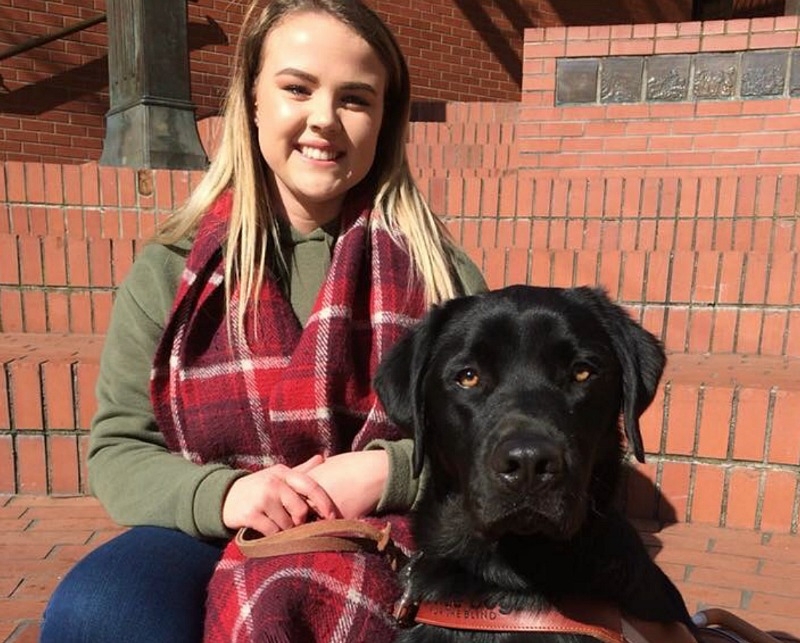
A woman smiles into the camera. A guide dog sits next to her.
By Beth Deer
On August 26th of last year (Patronus’ third birthday), the Edmonton Bureau ventured to Pigeon Lake where we had the pleasure of witnessing Camp Maskepetoon in action. It was such a fun day and one of my favourite shoots I’ve ever been on.
The camp was a mixture of CNIB clients and other children who had registered directly through the camp. Not only did CNIB clients get to hang out with other kids who understand what it's like to be blind or partially sighted, but they also got to hang out with sighted kids as well. I was honestly in awe of all the kids and how accepting everyone was of one another.
My visit to Pigeon Lake was actually the first time I’d ever seen a lake in Canada and I couldn’t get over how big it was. Our cameraman, Pat, started to laugh at me because he’s from Ontario and by the sound of it Pigeon Lake is a tiny puddle.
On another note, I was a very bad pet owner and didn’t realize it was Patronus’ birthday until way later on in the day. This next little story is absolute karma for forgetting P-man’s birthday. We were nearly packed up and ready to leave when we realized we’d locked the keys in the AMI vehicle. We called the other guy who works in our office, Jim Krysko (a.k.a. Jimmy Bean Dip), to see if he would be able to drop the keys off to us. Jim, being the helpful guy he is said of course... then he realized there was actually a key pad on the car so we’d be able to get in without him. How did the non-blind people in my team not notice this? Either way, it makes for a good story.
If you’re interested in finding out how the wonderful Camp Maskepetoon is doing in these strange times, tune in to AMI This Week at 8 p.m. Eastern on July 29th.
ReVision Training with Tyler Merren, Fitness VIPs
A woman and man speak during a Zoom call.
By Laura Bain
Recently, I had the opportunity to interview American Paralympic goalball player, motivational speaker, and fitness instructor Tyler Merren for an AMI This Week segment. Tyler lives in Indiana. Although I miss being out in the field with our Halifax team meeting guests in person, one advantage of doing the show from home is that we are able to interview guests from anywhere in the world so long as they have access to the Internet and a device with a camera on it.
Tyler came to my attention a few months ago when I was invited to join his Facebook group ReVision Training with Tyler Merren, Fitness VIPs. In this group, Tyler posts workout videos that he makes at home. The videos are for all fitness levels and cover various types of workouts from yoga to cardio and strength training. The best part? All of the videos are fully accessible to people who are blind or partially sighted.
Like me, Tyler has Retinitis Pigmentosa, so he knows first-hand what it’s like to put on a workout video and not be able to follow along because you can’t see what’s happening on the screen. I’ve tried a few of the videos and found them easy to follow as Tyler describes each movement, how your body should feel in the exercise, etc.
Unlike me, Tyler had a positive relationship to sport and physical fitness growing up. He came from a family of athletes and was introduced to goalball in high school. He went on to study exercise science in university and to work as a personal trainer in a busy gym environment. I do not come from a family of athletes and did not really know about adaptive sports until I was in my 20s. My childhood and teenage experiences of gym class were painful and traumatizing. In some cases, the teacher would allow me to sit on the stage and watch the other students have class; in other cases I was forced to participate without modification which led to bullying, injuries and always being picked last.
In my 20s and 30s, I have started to reclaim the part of my identity that expresses itself through movement. Turns out I actually love activities like hiking, running, tandem biking, and really any type of exercise where no one is screaming at me to locate a ball I can’t see. I’ve tried goalball and I like it, but I think because of my early experiences I may always have an aversion to team sports.
Here’s what I’m saying: I am fascinated by and in admiration of people like Tyler who confidently assert themselves into fitness environments. I want to learn from them the skills I didn’t learn growing up. I want to walk into a gym and not feel any sense of shame or like I don’t belong because I use a cane. Tyler is on a mission to make physical activity accessible to everyone, and I think that this is so important because we all have a right to move our bodies to the best of our abilities and receive the physical and psychological benefits that come from exercise. If you have a disability and have a complicated or negative relationship to fitness, now might be the perfect time to experiment at home, in your living room, with nobody watching.
You can watch my interview with Tyler Merren on AMI.ca, our AMI YouTube channel, or on the AMI-tv App.
Knights of the Braille

Two men sit on a couch, with video game controllers in their hands.
By Alex Smyth
With AMI This Week back on the air with exciting new segments, I wanted to give a tease for a story that will be airing in the near future. The segment is on a Dungeons and Dragons group called Knights of the Braille. As the name suggests, they are an online community that is comprised of members of the blind and partially sighted community who have a love of the fantasy role-playing game, Dungeons and Dragons, or DnD for short.
I first came across this group about a year ago, and being the nerd that I am, immediately wanted to do a story with them. Little did I know, this would be much easier said than done. Part of the issue is how to share the experience of playing a game that takes place entirely in your imagination, and making the audience feel like a part of the action.
Our first attempt at setting up this story was to be in the fall, and it would include a few local members of the group and myself sitting down in person and playing some DnD. What we would then do is re-create our encounter and experience with the help of our graphics team to show the audience what we are experiencing in our imaginations as players. Unfortunately, this did not turn out because of scheduling conflicts, heavy workloads for our graphics team, and the end of our fall run of episodes.
It was unfortunate that it fell through the first time, but I was determined to not let this story fall by the wayside, so I made sure to keep in contact with Jim, the creator of Knights of the Braille, and to form a plan for when the season returned in the Spring. Then COVID-19 happened.
Originally I was thinking to have Knights of the Braille be the kick-off segment of our return in the spring, but that all quickly went away with the global pandemic forcing us to work from home and halting all production. As we worked behind the scenes to come up with solutions for how we can work from home, we began to put ideas for interview and segments that would work remotely. Since Knights of the Braille play remotely and use web-based services to connect, I thought it was a natural fit given the current circumstances.
So after months of communicating, planning, and overcoming challenges, we finally were able to make it work and bring this story to life. So I hope you all enjoy the story, and keep in mind that sometimes, the stories we do can be a long time in the making!
AMI This Week airs Mondays at 8 p.m. Eastern on AMI-tv.
Beth gives Cody a haircut
A man gets his hair cut
By Beth Deer
Ha, what did you do last Friday? I cut my boyfriend Cody’s hair.
It was very interesting to say the least, the poor guy has been needing a haircut for a while. Cody said he would only get a haircut if my boss let us do it on camera, and I wasn’t surprised when our senior producer, Michelle, gave us the green light.
I don’t want to give too much of the segment away, but I’ll give you the low down on my hair cutting history. Firstly, I convinced my friend and her mum when I was 13 that I "always cut my own hair." I ended up cutting her fringe for her and it looked all right.
Secondly, when I moved to Canada, we went to our friends hometown for its rodeo. We ended up in some guy's garage with our friend and his buddies, one of which didn’t believe I couldn’t see. As he didn’t believe me, I offered him a haircut with some huge scissors that were lying around. It could have been worse but because of how big the scissors were it did end up looking a little wonky.
On a serious note, if there is one thing I did learn from cutting Cody’s hair it’s that it’s quite a tactile venture and depending on how nice you’d like you hair to look ... literally anyone can cut hair! To find out how Cody really feels about his hair cut join us on AMI This Week at 8 p.m. Eastern.
Now, I wonder who else I can get to trust me with a buzzing blade?
Test Your Friends Knowledge with Beth's Quiz
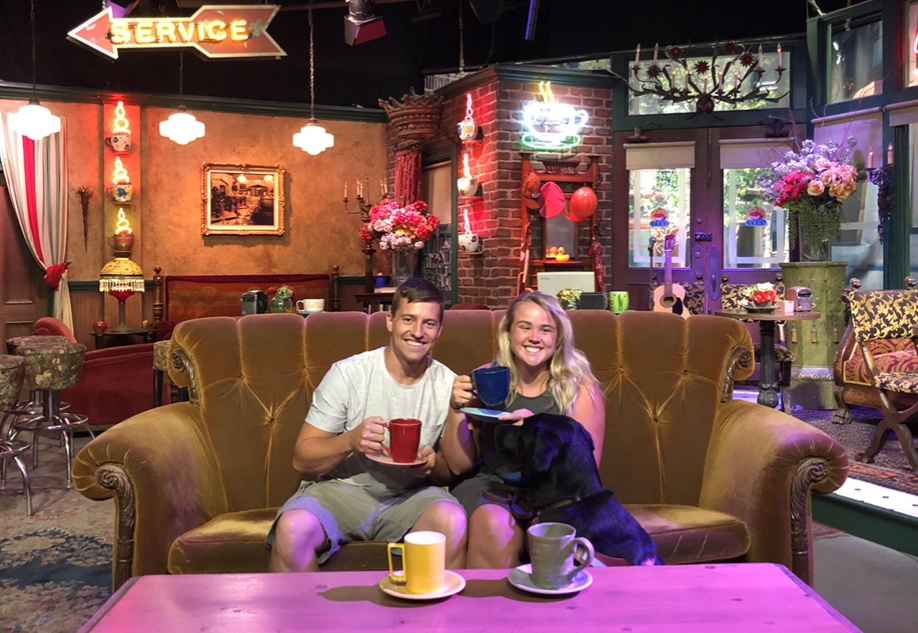
A man and woman sit on the set of Friends.
By Beth Deer
After my previous blog post about my obsession with the TV show Friends, I thought it would be fitting for a pop quiz!
Here are 25 questions ranging from easy to hard… some of them will only be able to be answered by Friends-obsessed fans, like me! The first eight are multiple choice, but after that you’re on your own! You will be able to find the answers to each question at the end of the post.
Feel free to email me with your results, I’d love to know how you did!
Q1 - How many seasons did Friends run for?
A: 6 seasons
B: 8 seasons
C: 10 seasons
Q2 - Who are the six main characters?
A: Rachel, Ross, Joey, Gunther, Monica and Phoebe
B: Rachel, Ross, Joey, Chandler, Monica and Phoebe
C: Rachel, Ross, Ken, Chandler, Monica and Phoebe
Q3 - Which couple dates on and off throughout all of the Friends seasons?
A: Rachel and Ross
B: Joey and Phoebe
C: Monica and Chandler
Q4 - Which actress plays Rachel?
A: Courtney Cox
B: Demi Moore
C: Jeniffer Anniston
Q5 - Out of all of the characters, which two are related?
A: Joey and Rachel
B: Ross and Rachel
C: Ross and Monica
Q6 - Who is Gunther?
A: the guy who is in love with Rachel
B: the cop that Phoebe dates
C: the guy who hums while he pees
Q7 - Which out of the six friends live across the hall from one another?
A: Ross and Pheobe live across the hall from Monica and Rachel.
B: Joey and Chantler live across the hall from Monica and Rachel.
C: Joey and Phoebe live across the hall from Monica and Rachel.
Q8 - How many divorces has Ross had?
A: 1
B: 2
C: 3
Q9 - Who does Phoebe end up marrying?
Q10 - Which friend went on a date with Rachel’s boss?
Q11 - What is Ross’s mum called?
Q12 - Out of the girls, who went to school together?
Q13 - What type of animal is Marcel?
Q14 - Who did Monica hook up with in London?
Q15 - How do the girls communicate when looking for Monica’s wedding dress in the discount store?
Q16 - Which names appears on the address for the TV Guide that comes to Joey and Chandler’s apartment?
Q17 - Which friend directed 10 episodes?
Q18 - What does Rachel call her sphinx cat?
Q19 - Name one of Phoebe’s non-traditional guitar chord names?
Q20 - Who are the creators of Friends?
Q21 - Which friend originally wanted to call their baby Emma?
Q22 - What did Ross buy Carol when he fell in love with her?
Q23 – What’s the name of the software Pete created?
Q24 - What was the name of Ross and Chandler’s college band?
Q25 - Why does Rachel agree to Phoebe setting up Ross with her friend Bonnie?
ANSWERS
Q1 Answer - C
Q2 Answer - B
Q3 Answer - A
Q4 Answer - C
Q5 Answer - C
Q6 Answer - A
Q7 Answer - B
Q8 Answer - B
Q9 Answer - Mike
Q10 Answer - Chandler
Q11 Answer - Judy
Q12 Answer - Rachel and Monica
Q13 Answer - Monkey
Q14 Answer - Chandler
Q15 Answer - by using whistles
Q16 Answer - Miss Chanandler Bong
Q17 Answer - David Schwimmer
Q18 Answer - Mrs Whiskarson
Q19 Answer - bear claw/Turkey leg/old lady/Tiger/Dragon/iceberg
Q20 Answer - Marta Kauffman and David Crane
Q21 Answer - Monica
Q22 Answer - Ridiculously expensive crystal duck
Q23 Answer - Moss 865
Q24 Answer - Way! No way!
Q25 Answer - Rachel thinks Bonnie is bald
Watch AMI This Week, Mondays at 8 p.m. Eastern on AMI-tv. Stream past episodes and seasons on demand on the AMI-tv App.
How to tell if you’re buying accessible home appliances

A man, using a wheelchair, loads dishes into a dishwasher.
By Grant Hardy
There’s nothing worse than realizing that your tried and true dishwasher or washing machine is on its last legs. It might mean shopping around and shelling out for an expensive replacement. It certainly means the hassle of putting some household chores on hold for a while.
But of course, if you’re blind or partially sighted, you also need to determine whether the device you’re getting meets your accessibility needs.
In this post, I’ll give a few strategies for doing just that that have worked for me, both in my own place and when trying to help my family pick out appliances that would work for me.
Decide what you want to do with the device
Most appliances are packed with features, some of which you may not need or want. Though it would be amazing if every appliance was 100% accessible, often you have to pick your battles.
For example, on a microwave you probably want to be able to control the power and duration settings for cooking food. But if the clock and kitchen timer features aren’t accessible, and you know you won’t need them, it’s OK to let those go.
Determine what would happen if you put markers like Braille or stickers on the appliance
Sometimes, you can make an appliance accessible by putting tactile markers on it—but not always. Here are some guidelines to look out for.
Firstly, don’t be intimidated by touch screens since often they’re very easy to mark with stickers or dots. Every touch screen has a different amount of pressure that’s needed to activate a control so be sure you take that into account based on your personal comfort level. If merely brushing the screen with your finger is enough to press a button, you might conclude that’s too tricky since you won’t be able to feel around to locate the sticker you want without pressing buttons. On the other hand, there are people who have great muscle memory. At my family home, we used to have an oven that would activate with the slightest touch, but my brother was confident enough to memorize the exact spot he needed to press on the screen so that this wasn’t an issue.
On the other hand, just because a device has physical buttons and dials doesn’t mean it’s fully accessible. Let’s say you have a washing machine with a dial that’s easy to turn, and makes a nice tactile click every time it’s turned. You might think that this is totally accessible, since you can easily find the cycle you want by lining up a couple of stickers. But what happens if it’s a digital dial and the appliance is turned off or loses power? Sometimes, it stops registering anything when you bump the dial. So when you next turn the device on, your stickers aren’t marking the spots they used to be.
Consistency is key. Make sure you can test the appliance and that it always behaves the same way. If there’s something that has to be done to get the device to turn off and on, and perhaps an audible beep, make sure you an reproduce that every time. If you’re using stickers or tactile dots to mark up a touch screen or dial, make sure you can always count on them to do the same, consistent thing.
You’ll find the right device. It may just take a bit of time and testing.
Watch AMI This Week, Mondays at 8 p.m. Eastern on AMI-tv. Stream past episodes and seasons on demand on the AMI-tv App.
Moving Tips and Tricks

A man and woman stand outside a house under construction.
By Beth Deer
I’m really excited to share with you some tips and tricks on how you can be productive when moving houses. I’d be lying if I said this wasn’t for my benefit as well, because I’m really struggling with my time management and productivity when it comes to moving.
Purge and declutter
As my boyfriend keeps telling me, “What’s the point in packing that if you’re just going to chuck it out when you unpack it?” I hate to admit it but he is right. De-cluttering helps with two things; it makes your new house look clean and it helps you identify what you really need to keep because of it’s important to you. Does it have a purpose? If the answer is no, get rid of it.
Wash everything
When you take down your curtains, wash them. This way you won’t be bringing dust into your new, clean home. I would never usually wash my curtains, but it does seem like the right thing to do, and the best time. When you take your bed sheets off and move any of the towels that go in the bathroom, wash them all! Moving is a long, exhausting process, so this way at the end of the day you can get into a clean bed and have access to clean towels to make yourself feel at home!
Overestimate your supplies
Do this for boxes, packing tape and labels. By overestimating what you’re going to use, you will save yourself precious time and effort! Bear in mind too that you can also get cardboard boxes of all different shapes and sizes for free at many grocery stores. Try visiting a store in the morning, once they’ve done their unloading; often they will happily give away the boxes they don’t need.
Pack up room by room
Don’t stop until the room you’ve started packing is empty. There’s a good reason for this; when you’re unloading at your new home, everything has a room that it should be placed in. Packing up room by room means things won’t be misplaced in the chaos of packing. I’m super guilty of not doing this, I’ll start packing in one room then go into another with my hands full and before I know it all my stuff is in the wrong rooms and it’s all my fault!
Pack an essentials bag
Pack like you are going on a work trip; only take what you need. Underwear, shoes, toiletries, clean clothes, snacks, chargers and everyday items. This will help you pack the rest of your house as you are left with are items you don’t immediately need. Also, do the same for your children and pets.
Label everything
It’s really important that you identify not only what is in the box, but where the box itself should end up. Labelling really comes in handy when you’re having friends and family help you move. This way everyone knows where the boxes need to go.
Decide what’s too important
There will be certain things when you’re moving that are just too important to put in the moving truck. For example, I know when I move I’ll make sure I hold onto our passports, iPads and my teddy that I’ve had since I was a baby. I know you’re thinking, “You still have a teddy and you’re 22?” but he’s too important for someone else to move, and I’d blame them forever if he got lost.
Watch AMI This Week, Mondays at 8 p.m. Eastern on AMI-tv. Stream past episodes and seasons on demand on the AMI-tv App.
Top 10 favourite Friends episodes
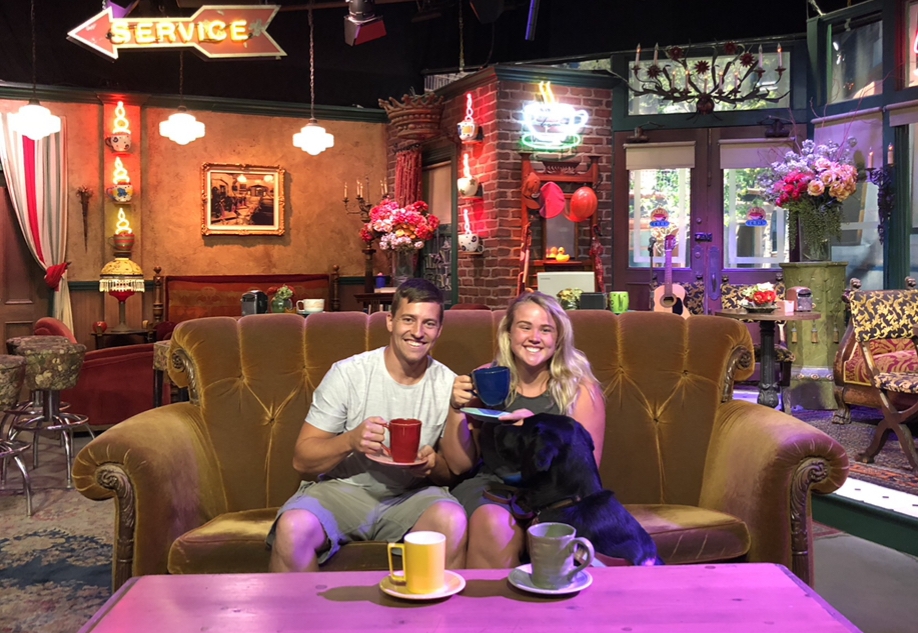
A man and woman sit on the set of Friends.
By Beth Deer
For this week's blog post, I thought I would write about one of my favourite things, the TV show Friends. Our Edmonton Bureau's camera man, Pat Kelly, emailed me saying I should write a blog post ranking my favourite episodes. This was a great idea because as everyone in the Edmonton office knows I quote Friends on a regular basis.
I have been a Friends fan since I was about 8 years old. I think one of my reasons for loving it so much now is the fact that I remember seeing it. Before I lost my sight, I got to see lots of things but Friends is the one show where I can remember what everyone looks like, what the different apartments look like and even most of the guest stars. Below, in no particular order, I will be listing my Top 10 Friends episodes. Go ahead and watch them yourself on Netflix, where it's available in described video!
Season 1, Episode 5: "The One With The East German Laundry Detergent"
This episode is one of my favourites because I remember watching it as a kid and howling with laughter because Ross walks into the washer door and falls over. This is also the beginning of Ross and Rachel in my opinion.
Season 8, Episode 4: "The One with the Videotape"
I would have watched the tape if it was me... Ken Adams.... that’s all I have to say.
Season 2, Episode 14: "The One With The Prom Video"
“He’s her lobster.” This is a very famous Friends line! Fun fact, my boyfriend and I did a Friends quiz at a bar in Lethbridge, Alberta, and won out of 50 teams!!! Patronus was given a little stuffed toy lobster because of this line.
Season 5, Episode 16: "The One With The Cop"
You must have heard of "PIVOT!" This is my mum’s favourite episode.
Season 3, Episode 2: "The One Where No One’s Ready"
“OK buddy boy, here it is. You hide my clothes, I’m wearing everything you own.” Kills me every time!
Season 4, Episode 23 & 24: "The One With Ross’s Wedding, Part 1 & 2"
How could I miss this one. “LONDON BABY” and “looks like someone’s Westminster crabby.” I just love it.
Season 2, Episode 19: "The One Where Eddy Won’t Go"
The break up of Joey and Chandler was an unsettling time for everyone but seeing how they come together and out weird the very weird guy, its just magical.
Season 7, Episode 11: "The One With All The Cheese Cakes"
There has been several times where me and my boyfriend have gone out and bought cheesecake purely because of this episode.
Season 4, Episode 12: "The One With The Embryos"
“Chanandler Bong.” I know a lot of people think Friends is dated but for me, it’s timeless.
Season 9, Episode 19: "The One With Rachel’s Dream"
This episode taught me what I was and wasn’t allowed to take from hotel rooms - genius!
“You have to find the line between stealing and taking what the hotel owes you. For example, hair dryer no no no but shampoos and conditioners yes yes yes.”
Now please everyone go and watch the episodes and laugh with me. Not liking Friends is like saying you don’t like puppies (like Chandler). I can, and will, change your mind!
Watch AMI This Week, Mondays at 8 p.m. Eastern on AMI-tv. Stream past episodes and seasons on demand on the AMI-tv App.
My Top 10 Seinfeld Episodes with Shelby Travers
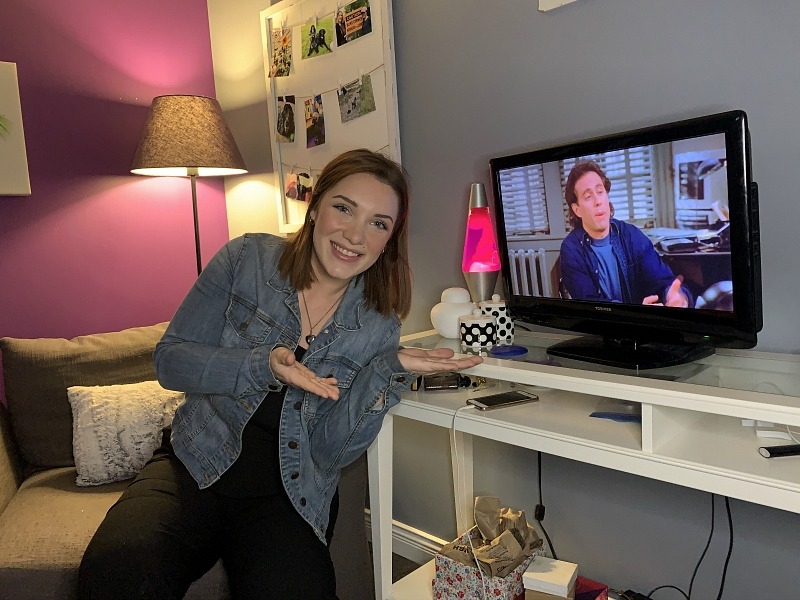
A woman smiles and gestures to the television set. Seinfeld is playing on it.
By Shelby Travers
As usual on Tuesday, I headed over to AMI.ca blog to check out what the other AMI This Week reporters were getting up to. This is when I saw "My Top 10 Favourite Friends Episodes.” It was at this moment I knew what I needed to do. I needed to make a Top 10 Favourite Seinfeld Episodes. Why was I so passionate about this? Because there is and always will be a rivalry between the Seinfeld Folk and the Friends Fans!
I’ve watched Seinfeld as long as I can remember. I have probably seen every episode at least six times – excluding Season 1. Really, we should just pretend season one doesn’t exist.
Before getting into the list I have to say these aren’t ranked in any particular order because that would take probably months. And I’m a Libra, so decisions of any kind are hard enough.
1. “The Puerto Rican Day Parade” - Season 9, Episode 20
2. “The Shower Head” - Season 7, Episode 16
3. “The Junior Mint” - Season 4, Episode 20
4. “The Bottle Deposit” - Season 7, Episodes 21 and 22
5. “The Comeback” - Season 8, Episode 13
6. "The Jimmy” - Season 6, Episode 19
7. “The Pothole” - Season 8, Episode 16
8. “The Wallet” - Season 4, Episode 5
9. “The Fatigues” - Season 8, Episode 6
10. “The Fusilli Jerry” - Season 6, Episode 21
Coming up with 10 episodes out of 180 was insanely difficult and there are so many I’d like to include other than these! For now, I think this is the start of 10 episodes I know I’ll be watching over the weekend!
Watch AMI This Week, Mondays at 8 p.m. Eastern on AMI-tv. Stream past episodes and seasons on demand on the AMI-tv App.
Online Gaming in the Age of COVID
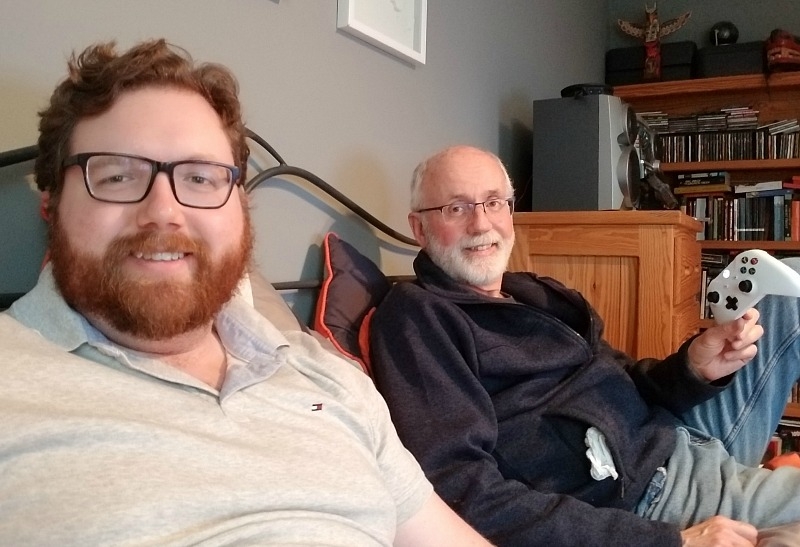
Two men sit on a couch, holding video game controllers
By Alex Smyth
As the weather gets warmer, the days get longer, and the period of social distancing seems to drag on, it can be harder to stay apart from your friends and family. You are not alone in this feeling. Many of us have grown stressed and frustrated by the feeling of isolation and lack of social connection. Chatting through Zoom or Skype is better than nothing, but you want to be able to do something together, beyond staring at each other through a screen.
One method that seems to have taken off and filled this void is online gaming. It’s fun, social, and allows people to do more than just stare and talk to each other. It has also (for the time being) seemed to replace the gap in live sports. With eSport competitions providing the content-starved audiences with something to follow.
I’m a proud gamer and have played games for most of my life. I enjoy the escapism that it brings but also love the social aspect of playing with friends online. During this pandemic, gaming online has helped me stay connected with my social circle and it’s kept us close, while keeping us apart. The pandemic also has an unintended side effect for online gaming. Being forced to stay home and stay inside has meant more time for games!
Right now, I have been bouncing between a few different games to play with my different groups of friends. Twice a week, I get online with a small group based throughout Ontario to play Dungeons and Dragons. A role-playing game typically taking place in the minds of the players, it’s a fun way to flex your creative muscles and problem-solving skills to fight monsters, explore new lands, and gain glory, all with the help of some dice, a pen, and paper.
With the use of some technology, this game is easily played online. Connecting through the game-chat app Discord for our conversations and Roll20, a platform designed for role-playing games, like Dungeons and Dragons (D&D) for our maps and visuals, it’s a pretty seamless experience.
Another game that my friends and I have invested a lot of hours in lately has been Age of Empires II: Definitive Edition. This is an updated version of an iconic computer game. Originally released in 1999, Age of Empires II is a strategy game where you select an historical faction to play as and you build up your civilization while trying to destroy your opponents.
Age of Empires II: Definitive Edition, released in 2019, is a 20th anniversary updated version of the game where my friends and I get to relive our childhoods, replicating the days we used to play the original game. With the group based throughout the GTA, it’s a great way for us to chat, catch up, and dominate some opponents along the way!
The final game that has consumed my time is Call of Duty: Warzone. This is a free, first-person shooter game, where you are trying to be the last soldier standing, killing all the other players. Designed in the wildly popular battle-royal style, each player has one life to try and eliminate the other 149 players in the game. It’s challenging, fun, and the game I play with a friend based in Vancouver.
Another added bonus of this game is the fact that you can connect with other players using different platforms, which is a rarity among online gaming. So for myself, I can play with my Xbox, connect with my friend using a computer, and we could play someone on a PlayStation. It’s a great way to blow off some steam and have a chance to catch up while playing together.
So remember, it can be tough to stay apart from those you care about. No one is say it is easy. But with a little ingenuity and thinking outside of the box, you can maintain that social network and have some fun along the way!
Watch AMI This Week, Mondays at 8 p.m. Eastern on AMI-tv. Stream past episodes and seasons on demand on the AMI-tv App.
Painting My Toenails for the First Time
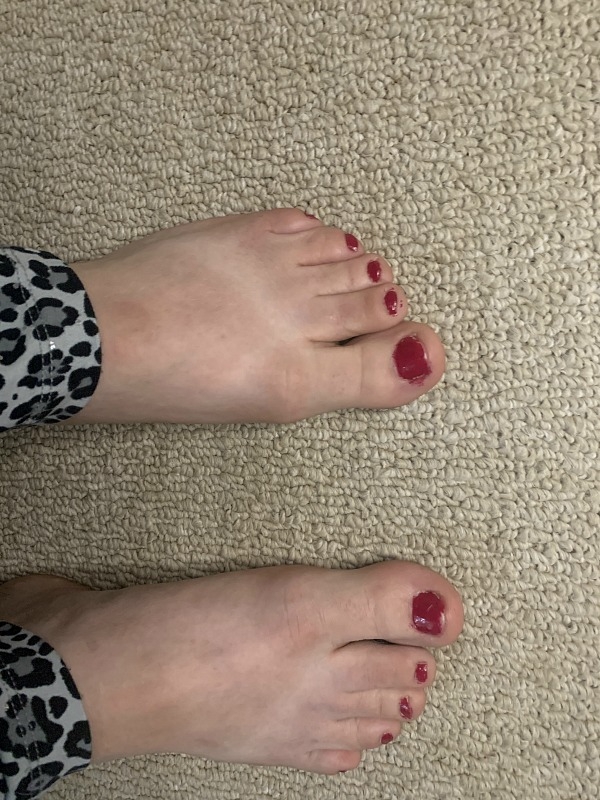
Toes with painted nails.
By Shelby Travers
When I think of self-care, one of the first things that pops into my head is pedicures. Sitting on one of the big comfy massage chairs, dipping my toes into a warm bath of water, and relaxing for even just a half-hour feels like calm. Not only that, it just makes me feel better about myself when I leave the salon.
My feet are something I’ve always been insecure about. It may not make sense because who really has pretty feet–after all, feet are meant for function. However, when they are smooth and freshly-painted that insecurity goes away. But now with this pandemic, what am I to do?
Well, just like makeup took me years of practice and patience to learn how to do, I figured it was time for an at-home pedicure day! I soaked them, scrubbed them, cleaned up the nails, and then came the part I feared most, the nail polish.
As you may have predicted, with a blind girl painting her own toenails, the polish got all over my toes and in some areas even missed the nail. And as is typical when I realize something, I cannot do to the ability I wish I could, I went through the grieving process.
Denial: OK, they’re not that bad.
Anger: What’s the point in even trying? Why can’t I do anything?
Bargaining: Well, maybe if I just take this cotton swab with nail polish remover around the cuticle...oops.
Depression: Nothing is working. Nothing ever works. This isn’t fair.
Acceptance: It is pretty funny if you think about it.
Every moment in life can test how you feel about yourself and your self-worth. In just a moment, by practicing my self-care I flipped it into a moment of feeling less than. This is normal.
Even when just at home and after 12 years of living with my disability, I am still going through the stages of grief. I am still faced with new challenges that make me question who I am and what I feel. The only difference now is I allow myself to feel those feelings and move forward... one sloppily painted foot at a time.
Watch AMI This Week, Mondays at 8 p.m. Eastern on AMI-tv. Stream past episodes and seasons on demand on the AMI-tv App.
Connecting with my parents
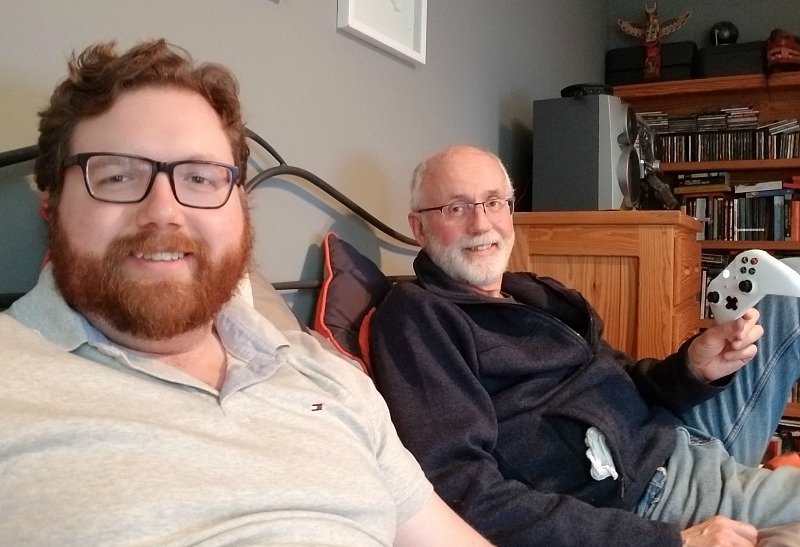
Two men smile into the camera.
By Alex Smyth
Before things started to shut down and social distancing measures put in place by the government, I made the decision to pack up all my essentials (clothes, computer, recording equipment) and not-so-essentials (Xbox, board games) and temporarily moved back in with my parents in our childhood home.
There are a lot of benefits to doing so. With a larger footprint, backyard space, abundance of food, but most importantly, having the social connection with my parents was something I knew would help me get through this time.
I love to play games, and it doesn’t matter whether it’s a card game, board game, or video game. I find enjoyment in them and it provides me with a way to connect with friends and family scattered throughout the country. This was something that started when I was young, and my family often played board games together around the kitchen table. Well this was a tradition that we started to re-institute given the increased down time at home and it has helped us connect on a deeper level.
But we have started to play more than just board games! My dad had tried and played a few video games over the years, from Tetris, to Minesweeper, and even a brief stint playing an old version of Medal of Honor. But he never kept up with the evolving medium. That was part of what surprised me so much when he said he wanted to learn to play Madden with me. What a great chance to try something new and also have some father-son bonding time.
Sharing a love of football, quickly we were trading jabs and jokes as our teams played back and forth. With my dad playing on the easiest difficulty and me on the hardest, it was a surprisingly even match. While the first match may have gone my dad’s way in the end, I came back to tie up our series in the next match.
Both of us consistently choose to play as our favourite teams, Dallas Cowboys for dad, and Chicago Bears for yours truly. While the stats and ratings for the team is a bit uneven (curse you Dallas and your offensive line!), it is still a blast to try and out play and outwit each other at every turn.
With no sports on TV to enjoy, our ongoing battle has become a highlight of the week. To date, my dad has the lead, with a record of 3-2, but rest assured I will be prepared to even things up next time we play!
Watch AMI This Week, Mondays at 8 p.m. Eastern on AMI-tv. Stream past episodes and seasons on demand on the AMI-tv App.
Beauty Q&A

A woman smiles into the camera.
By Shelby Travers
For the past few months, I have been a biweekly guest on the AMI-audio show NOW with Dave Brown. During these appearances, I have been going over different beauty topics from society's standards of beauty over the decades, understanding the science behind Botox, and the art of colour theory. Most recently, I have done a question and answer segment to answer the public question relating to beauty topics. I figured I’d share these questions and answers with you to hopefully help some more people! And if you have your own beauty questions for me, you can reach me on my Twitter @Shelby_Travers.
1. From Lia in Richmond, B.C.
Q: Some hair care has gone out the window in isolation. What could someone do to rehab their hair before they can get in the salon?
A: A weekly hair mask is great to keep your hair in good health and to keep it from looking angry. Replace your conditioner with a mask until you can get into the salon again. Remember, conditioners and masks are only applied to the mid lengths and ends of your hair. I like to wash my hair, put the mask on and then do the rest of my showering. This way you can keep it in for longer! Davines has a great line of hair masks for a variety of different types of hair which can be purchases on their website.
2. From Morgan in Manitoba
Q: I have two questions. All the hand soap and hand sanitizer are taking a toll on my skin; any advice for hand care? And do you have any spring/summer skin care advice?
A: A trick for dry hands is to treat them at night. During the day, we’re constantly washing them and so really, any treatment we do during the day is just going to get washed off. This isn’t the most “comfortable” treatment, but try putting Vaseline or an oil on your hands before bed, then wrap them up in a sock or a soft glove. This will really hydrate. For skin care, it’s tough to give advice without knowing your particular skin type/issues (reach out to me on social media and I’d happily make more specific recommendations!). But a good rule for EVERYONE in all seasons of the year is a full spectrum sunscreen with UVA and UVB protection. I will be doing an upcoming segment on sunblock, so stay tuned!
3. George from Montreal
Q: It's getting to be sandal and flip flop season. It might still be a minute till the foot spas open. What can we do to keep our feet and toenails looking and feeling nice?
A: George, you and I both are struggling in this area! Of course, during this time, there’s only so much we can do so firstly, be gentle on yourself! However, if you’re comfortable doing some pedicure things yourself it’s great to invest in either a foot scrub, or a pumice stone. Additionally, moisturize! Rubbing some argon oil on my feet at night has kept most of the calluses at bay!
Watch AMI This Week, Mondays at 8 p.m. Eastern on AMI-tv. Stream past episodes and seasons on demand on the AMI-tv App.
Meet my isolation buddies
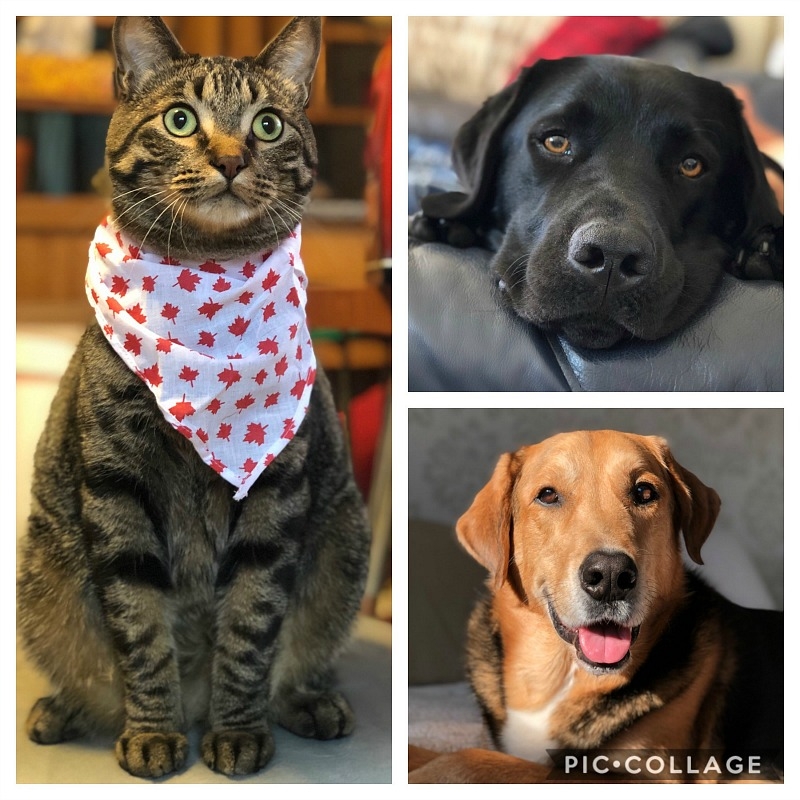
Pictures of a tabby cat, black dog and golden dog.
By Beth Deer
Meet my isolation buddies, a.k.a my animals/fur babies. When I had the idea of writing this blog, I was honestly shocked that I hadn’t thought of it earlier. If you know me well, you’ll know the one thing I usually can’t stop talking about is my animals. Talking about animals is such an endless topic, especially when you’re talking about your own.
Patronus
You should all know who Patronus is by now, especially if you’re an avid ATW watcher or saw Postcards From Vancouver Island. Patronus is my guide dog, he’s a black lab retriever with amber eyes and weighs roughly 80 lbs. He loves to work, but he also loves to cuddle, in fact I would say cuddling is his real passion. He whines constantly until you give him permission to come and cuddle with you. Recently, his obsession for cuddling has become a problem. Working from home means sitting at my kitchen table and working. He doesn’t quite understand working from home; home to him is cuddle time and means he will whine/bark at his parents while they sit at a table and ignore him. Patronus is one of the goofiest dogs you will ever meet. He goes from looking so proper and noble to just running, Forrest Gump style, he can’t stop!
Jake
Jake is Patronus’ bro and partner in craziness. Jake is four different breeds of dog: Great Pyrenees, Rottweiler, golden retriever and black lab. He’s a big boy weighing in at about 105 lbs - a healthy weight. Growing up, my family always had cats but no dogs… even though my dad, sister and myself all really wanted one. This makes Jake my first pup. My boyfriend, Cody, had Jake from a puppy and when I moved to Canada he was four years old. All of these breeds together are the best mix. He’s so protective, his colourings look like a German Shepard, he listens like a Labrador and is the biggest suck known to man. He doesn’t know it, but Jake is definitely the most excited about moving into our new house because we have a double lot, which means a lot of room for running.
George
As I said earlier, growing up I always had cats but Cody has never had cats and is actually allergic to them. And yet what did I think was a great idea? Getting a cat! Turns out getting a cat was a great idea. George is what we like to call a "dog cat." He sits, shakes a paw, gets excited for food, likes to cuddle and misses you when you go away for a few hours. He is essentially a dog in a cat’s body. Cody has gotten used to George and isn’t that allergic anymore, and he will even tell you that he loves having George around. Cody will also tell you, “I made a deal that Beth would always do the cat litter.” This is true, he did and I do the cat litter all the time! George is a tabby cat with a brownish nose and he’s a big boy. To tell you the truth George is a little overweight, but who isn’t right?
Cody
He’s just a human and I don’t have anything too exciting to tell you about him. Cody sits, shakes a hand, gets excited for food, doesn’t like to cuddle and has a party when I go away for a few hours. I hope that you have some cuddly friends in your isolation family!
Watch AMI This Week, Mondays at 8 p.m. Eastern on AMI-tv. Stream past episodes and seasons on demand on the AMI-tv App.
What I Wish I Knew Before Getting a Guide Dog...

A guide dog lies on a chair.
By Shelby Travers
Getting a guide dog was by far one of the best decisions I have made in my life. Frances provided me with independence, safety, security and confidence that I never knew would be possible. However, I feel this is the story we always hear and that guide dog users always tell and it’s not the whole story. It’s naïve to say that sometimes it is tough. Sometimes, having a guide dog doesn’t make it easier.
1. Your Guide Dog Will Fail
It’s a tough thing to think about and an even harder thing to accept but your guide dog will make mistakes and that’s totally normal.
2. You Will Have Moments When You Doubt If You Made the Right Choice
This one is especially true in the first year of working with your guide. Your guide dog school will tell you it takes around eight months to bond with the dog and you may laugh it off, but this takes time. It’s a huge transition for your dog as well as for you. Trust the process and be patient.
3. You Will Get Asked Very Personal Questions
Unlike when I had my cane and could fold it up and “pass” that I wasn’t blind based on my appearance and social misconceptions, once I had the dog it is now something I can’t hide. People see the dog as an opportunity to engage, and for some this will be welcomed. It’s helpful to be able to prepare yourself for this.
4. Measure Your Expectations
This point leads onto the first. In my first few years with Frances, I feel I had unrealistic expectations on what she would do for my life. It’s important to assess your lifestyle, what you want the dog to be able to provide, and really measure if that is realistic.
5. You Will Never Know A Bond Quite Like This
You are trusting another species that you can’t even communicate with with your life and guess what? They’re going to be there for you. This means the most unconditional, authentic, and demanding bond you will ever know in your life.
6. People Will Discriminate Against You
Another hard point to access and to measure but it’s true. I had known discrimination due to disability before using a guide dog. But with the guide dog, you experience it often. It hurts and you feel helpless. You are now not only fighting for your rights, but you are also fighting for the rights of another being that makes you feel whole.
Watch AMI This Week, Mondays at 8 p.m. Eastern on AMI-tv. Stream past episodes and seasons on demand on the AMI-tv App.
Alex Smyth: Spring is in the Air

A man smiles into the camera.
By Alex Smyth
How about a bit of good news? I feel we could all use some. Spring is officially in the air. The days are getting longer, the mercury is rising (slowly!), and flowers are starting to bloom. At least, that is the case from my window, which has become my gateway to the world outside.
As strange as this might sound, in the midst of a global pandemic, I think spring is arriving at the perfect time. As we feel confined in our homes for the foreseeable future, the small semblance of joy we can take is the fact that soon we can burst open our windows and claim our patios and backyards as an extension of our living space.
I have spent my mornings peering out at the birds flocking our feeders, and their colours are another indication the season’s here. From bright yellow, white, red, and beyond, the vibrant display is a welcomed distraction, even for a little while.
There are some other benefits to the warmer weather that may not immediately come to mind. I try maintain a pretty consistent workout schedule and with the warmer air and brighter light, I will hopefully be able to incorporate the outdoor space available into the routine and start doing some backyard cardio. For anyone with outdoor space, even if it’s a small, it can still be used in a creative way. A morning coffee on the porch or an evening drink as the sun sets is an activity that wasn’t available a couple weeks ago, so why not take advantage of it?
Secretly, I am hoping that my next blog post will be able to be written outside in the shade of a tree with a cool drink in my hand, but I may be getting a little ahead of myself.
As I write this the familiar sound of a lawnmower can be heard in the distance. So let the roar serve as a harbinger of the season’s change and with it, our social distancing bumble grow a little wider to include our available outdoor space.
But an important thing to remember, as the weather improves and the desire to spend more time outside grows, we must all remember to do our part when it comes to social distancing. It is not easy, but if we all follow the guidelines we will be able to come out of this quicker and safer. So stay safe, stay healthy, and enjoy the spring weather, while practicing that two-metre separation!
Watch AMI This Week, Mondays at 8 p.m. Eastern on AMI-tv. Stream past episodes and seasons on demand on the AMI-tv App.
Baking with Beth Deer

A tray of baked goods on a table.
By Beth Deer
While spending time at home has been necessary, it has also been boring. With Easter having just passed, I thought it would be fun to share some of my favourite sweet recipes for you to enjoy at your next family gathering. You may be able to use some leftover Easter bunny treats too.
Peanut butter cups
- Melt 1 cup of chocolate with 1/2 cup of peanut butter in a bowl over a pot of simmering water
- Put 1 tablespoon of the mixture into cupcake papers set into a muffin tin
- Let rest in the freezer for 10 minutes
- Melt 1 cup of peanut butter in a bowl over a pot of simmering water
- Remove hardened chocolate from the freezer and spoon melted peanut butter over the set chocolate mix
- Return to the freezer for another 10 minutes
- Add remaining chocolate mixture to the tops of the peanut butter layer.
- Freeze for another hour
My family usually have a pavlova for dessert on Easter Sunday. This year, as I wasn’t able to enjoy a pavlova with them, I decided to make my own. It is a very light texture and is meant to be able to hold its cake-like shape when baking. My pavlova, unfortunately, was not the right consistency when I put it in the oven, so I made a new creation called a “Bethlova.”
Bethlova
Ingredients
4 egg whites
1 1/4 cups of sugar
500 mL of high percent fat cream
1 tsp vanilla extract
1 tsp lemon juice
2 tsp corn starch
6 fresh strawberries
1.5 of a cup frozen raspberries
Method
- Beat together 4 egg whites (I buy the cartons of egg whites) in a bowl
- Once the egg whites are a smooth consistency, slowly add 1 1/4 cups of sugar 1 tablespoon at a time and continue to beat the mixture until thick
- Spreading evenly in the bowl, add the vanilla, corn starch and lemon juice, then fold gently into the mixture
- Preheat the oven to 300 degrees
- Pour mixture into a rectangular baking tray lined with parchment paper
- Bake in the oven for 35 minutes
- While your Bethlova is baking, use fresh cream and electric beaters to make whipped cream. You’re probably thinking, “Why can’t I buy pre-made whipped cream?” You can, but it tastes so much better if you whip it yourself.
- Make sure the whipped cream is in the fridge, then cut up some fresh strawberries into quarters
- Remove your Bethlova from the oven and cut it into two equal pieces, you’ll eventually sandwich them together
- Place one slab of Bethlova on whatever surface you’ll be serving it on
- Add about half of your whipped cream to the first layer, then place the next slab on top
- Once the next layer is on, go ahead and start adding your strawberries in whatever pattern you Iike. Add a few frozen raspberries at the very end as well
- ENJOY! Feel free to change the name too, it would be anything i.e. Rebeckylova, Patlova, Michelova, Jimlova, it all depends on your name
Watch AMI This Week, Mondays at 8 p.m. Eastern on AMI-tv. Stream past episodes and seasons on demand on the AMI-tv App.
Exercising at Home

A woman stands on her head, leaning up against a wall.
By Shelby Travers
Normally, I would say I’m a pretty active person. Whether it be walking to and from work, going to pole classes most days of the week, or going on a run, I like to keep my body moving. Although I will admit that this started out in vain of trying to be thinner, and look “more attractive” it has evolved into making my body and mind feel good.
I always heard from people that you just need to find an exercise that is right for you. To an extent, I believed it but knew that goals almost always included hard work. Then I found pole and I realized what everyone was talking about. Pole was my time to move my body and work up without a sweat without even knowing it. Then I started to look at running differently. No longer was I taking the approach of hitting a time or a distance but measuring my success in different ways. Noticing how simple it was for my body to move, but just like waking up in the morning, I shouldn’t go from 0 to 100.
However, with the current times exercise is one of the many things that I (and everyone else following proper quarantine measures) have had to adapt.
Although I still try to get out for safe walks, or runs, most of my work I am doing at home. It involves a lot of isolated body movements and stretching.
Stretching and flexibility have never (and I mean never) been my strong suit. I don’t remember a time I’ve ever been able to touch my toes. I will take full accountability though because I have never enjoyed stretching. I find it uncomfortable and something I don’t see quick results with. But, what better time than now to work on this? My 2020 pole goal was to work on my flexibility and mobility. As I am currently working on my wheel pose, shoulders and hip flexors are what is getting most of the attention. Don’t get me wrong, it’s not as fun as I would like, but setting a goal is a way I can measure my progress. Along with taking videos and playing music to have a bit more fun with it.
The isolated body movements are what really, I’m having fun with. Body Isolation is a terminology used for the technique in which dancers move one part of their body and keep the rest of the body completely still. In most forms of dance, isolation is crucial because it hones the core of the body, creating seamless dance movement for performances. Needless to say, this is giving me a great core workout and getting me closer to my goal of being a more fluid dancer.
Watch AMI This Week, Mondays at 8 p.m. Eastern on AMI-tv. Stream past episodes and seasons on demand on the AMI-tv App.
I Am a Walker
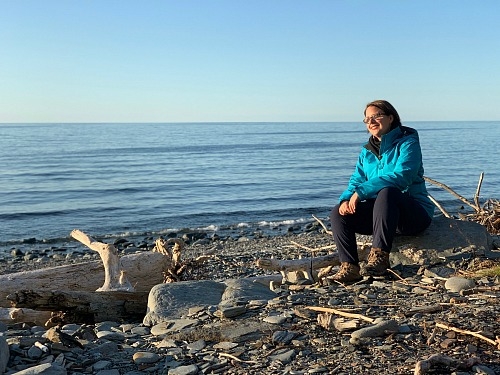
A woman sits on a log on a beach, smiling. She is dressed for cold weather.
By Laura Bain
I love to walk. For the past few years, I’ve been averaging well over 10,000 steps per day. One of my favourite parts of the day is my morning walk to work which takes about 40 minutes and is mostly downhill. The movement and sunlight help set my day in a positive direction. My uphill walk home from work is more difficult to talk myself into but, when I do walk home, I find it creates a clear divide between my workday and my evening and helps me decompress.
Why all this walking? Because I am a failure when it comes to both exercise and meditation. I intend to go to the gym, but often I don’t. Similarly, I intend to sit and meditate, but often I manage to find some distraction. I don’t mind making the bargain with myself “you can skip the gym if you walk home.” Because walking with headphones in is impractical for me as a partially sighted person (I started this practice before bone conducting headphones were a thing), trading the gym for walking means time alone in silence. Initially, and this is sometimes still the case, I’d let my thoughts run freely, often landing and fixating on whatever was annoying me most that day. Over time, I discovered I could practice mindfulness, as well as other forms of meditation during my walks, and often I found this easier than a sitting practice.
I am walking less these days. For one thing, I have nowhere to go. For another, I’m trying to “stay home” as much as possible. Currently, I walk once a day for about 45 minutes around my neighbourhood. If things change and these walks are no longer permitted then I will stop, but as it stands, they are an essential part of my physical and mental well-being during this pandemic. I notice that more people seem to be out walking these days. This makes sense since many people are either laid off or working from home and are experiencing cabin fever.
As someone who uses walking as a tool of wellness, I’d like to offer two gentle exercises you might like to try if you are walking (or rolling) alone more than usual.
Sensory Mindfulness
A mindfulness practice that I often use on my walks is to take inventory with each of my senses. If I’m caught up in thought, I can complete my entire walk without having truly experienced any of it. For this practice, I take a moment and notice what I am experiencing with each of my senses. I try not to attach judgement or thought to what I observe. For example, on a morning walk I might think “what am I smelling?” and notice that I am smelling fresh cut grass, coffee from a nearby shop, and gasoline from passing cars. I move through each of my senses sequentially, and then often move to a larger observance of how I am feeling physically and emotionally. For example, I might notice that I have a pain in my right foot, or that I am feeling well rested.
Gratitude
Gratitude is a wonderful thing to practice during a walk. It is a practice that can transform morning grumpiness or after-work agitation. I sometimes find this practice hard to get started so I start with the obvious which is that I am grateful to be alive and breathing. From there I move to being grateful for what I am perceiving with my senses, the movement that I have in my body, and to more tangible things such as having an apartment that I like, and so forth. Whatever your circumstances, I truly believe you can find things that you are grateful for. This practice is not about denying what may be difficult in your life, rather it is about resting your focus somewhere else for a few minutes.
There are many other meditation and prayer practices that you can take with you on your walks. If nothing else, it’s good to just get outside and breathe some fresh air. Try taking your headphones out and putting your phone away. Smile at strangers (even if you can’t see them), keep social distance, and stay safe everyone!
Watch AMI This Week, Mondays at 8 p.m. Eastern on AMI-tv. Stream past episodes and seasons on demand on the AMI-tv App.
Beth Deer: My Daily Routine

A woman looks into the camera, smiling. A plate of food is on a table in front of her.
By Beth Deer
Keeping structure at a time like this can be really helpful to your mental health. It doesn’t always have to be doing the same thing at the same time everyday; it can be creating different daily goals for yourself and doing your best to reach them. I’m going to give you some examples of things I’ve been trying to do to create a routine for myself and hopefully give you some inspiration for your own quarantine daily routine.
7:45 a.m. - Wake Up
I really struggle in the mornings; something called the five-second rule is what I use to help me get out of bed. You can apply the five-second rule to a lot of things in life. You count to five and do the thing you were procrastinating on.
8 a.m. - Work Out
I hate working out more than I hate waking up. It just so happens that waking up and going straight to working out works best for me. It gets my brain functioning and gives me motivation to start my day.
8:40 a.m. - Make Breakfast
Once I’m done my workout I have breakfast with an Arbonne Fizz Stick (instead of coffee) and a green tea. Some of my breakfast favourites are a protein shake (1 cup vanilla almond milk, half a banana cut up, 1 scoop of chocolate protein powder) or a fruit bowl (cut up melon, strawberries, banana)
9 a.m. - Start Work
I always like to have a list of priorities when I start my workday. Working from home can be distracting and I find this helps to keep me on track.
9:45 a.m. - Make a Tea or Drink Some Water
It’s important to stay hydrated throughout the day. As well, move every hour even if it’s just getting up and walking around, it can help focus and overall health.
10 a.m. - English Radio
I feel like it’s important to keep up to date on the welfare of where I came from, and obviously listen to some good music too.
12:30 p.m. - Have Lunch, Be Healthy, Move Some More
During this time of not getting out and about as much I’m used to, I’ve been trying really hard to eat right and fuel my body with what it needs. What it needs tends to be a light tuna salad or homemade soup.
4:30 p.m. - Finish Work
When the end of the workday comes, I find it best to totally unplug and put my work equipment away.
5 p.m. - Shower
Once I’ve unplugged, it’s time to unwind. I love to do a face mask and have a nice, warm shower.
5:30 p.m. - Make Dinner
My favourite dinner at the moment is poached salmon, spinach, broccoli and asparagus. Wrap the salmon in parchment paper with some lemon juice on top and bake at 400 degrees for 25 minutes.
7 p.m. - Finish Tasks Around the House
This includes dishes, tidying the kitchen, putting laundry away and household tasks.
8 p.m. - Relax
I relax by crafting, listening to a book or watching some TV.
10:30 p.m. - Bed
Sleep time! When bedtime comes around, I always use the Breathe app on my Apple Watch and try to breathe for three to four minutes. This is a great way to begin a restful sleep.
Watch AMI This Week, Mondays at 8 p.m. Eastern on AMI-tv. Stream past episodes and seasons on demand on the AMI-tv App.
Music to Get You Through

A woman sits on the beach, looking over her shoulder at the camera.
By Shelby Travers
Undeniably, it is still a significant transition period for all of us. Whether you are restricted from seeing your loved ones, attempting to work from home, still having to go into work with fears or have just been laid off, we have all been dealt a situation we were unprepared for.
Music has always been something that has influenced my mood, so I wanted to put together a list with some links to music I have been listening to during this time. Hopefully you can find something that you will help inspire you or ease your mind.
Lofi Hip Hop radio - beats to relax/study to
This is a continual live playlist of Lofi Hip Hop instrumentals. “Lofi Hip Hop” refers to a genre of music that mashes up traditional hip-hop and jazz elements to create an atmospheric, instrumental soundscape. I’ve been playing it whether I am dancing, working, or cooking. Essentially, it’s always playing around me.
The Weeknd – After Hours
The Weeknd recently released his fourth studio album titled After Hours. It consists of 14 tracks that are heavily influenced by R&B and synth. The album has varying melodies from upbeat, to eerie atmospheres making it a great listen no matter what you’re in need of.
Fleetwood Mac – Rumours
An album that is sure to get me through anxiety ridden moments is always Rumours by Fleetwood Mac. Quoted as one of the band's “most famous soap operas” by Rolling Stone, it features the folky pop/rock that the band is known for with added tantalizing he-said-she-said lyrics.
Relaxing Jazz Instrumental Music for Study, Work, Relax
The root of my love for music is with jazz. Often thought of as hectic and unpredictable, it can also provide smooth, soulful, and tempo keeping rhythms. This three-and-a-half-hour compilation provides a relaxing atmosphere perfectly complimented by your favourite beverage to make you feel like you’re at your local go-to coffee shop.
If you have any music recommendations, please reach out to me on twitter @Shelby_Travers
Watch AMI This Week, Mondays at 8 p.m. Eastern on AMI-tv. Stream past episodes and seasons on demand on the AMI-tv App.
Beth Deer: Looking Back and Moving Forward

A woman sits on some stairs, smiling into the camera. A guide dog sits next to her.
By Beth Deer
Last week was a time of significant dates for me. Three years since I moved to Canada, two years since I graduated with Patronus, and one year since I first met the Edmonton bureau AMI-tv team and applied for the job that I have now. To think it has been a year since any of this has happened is mind-blowing to me.
Moving to Canada was quite a snap decision for me. I came to visit my boyfriend in October 2016, after only meeting him in August. I was in a job I hated, and we missed each other a lot. I’d been back in England for only a week when Cody and I decided it would be best for me to move to Canada. Moving to Canada meant terminating my guide dog application and my spot on the waiting list I’d been on for two years. After losing my sight I wanted nothing more than a guide dog.
Before moving to Canada, I looked into what I thought were my options for getting a guide dog once I was there. I was adamant that training my own guide dog was the way to go, so I contacted several dog trainers until someone said, “No, don’t do that.” This person pointed me in the direction of Guide Dogs for the Blind in the United States. You may have heard of them: Disney+ filmed their Pick of the Litter series with this organization. They were the best thing that had ever happened to me. I filled out an application and within a month of living in Canada, I’d been accessed ... and within a year I had Patronus!
I moved to Canada March 29th, 2017. Patronus and I graduated from guide dogs on March 24, 2018. I didn’t think anything would be better than going from a guide dog obsessed blind girl, to a guide dog obsessed guide dog owner. But meeting Patronus and the people we trained with was much more meaningful than the change in blind girl-and dog status. In our guide dog class, there were six people and six dogs. The dogs were called Akira, Taj, Yoghurt, Jewel, Hampton and Patronus. I was the youngest by just over 30 years, but I made some of the most unforgettable memories with very like-minded people.
A year later, just before Patronus and my first anniversary, I got a letter inviting me to Service Canada in Calgary. They interviewed me so that I could receive my permanent residency status. After getting my residency, one of the first things I did was go to the CNIB website to see if they had any information about what services are available to blind people. Whilst on the CNIB website, I came across an employment bootcamp that they were holding the very next week. I called the CNIB straight away and got myself a spot in their first Employment Skills Bootcamp.
When Patronus and I arrived at the bootcamp, we kept hearing about a TV channel that was coming to film the experience. This is where I met Rebecca (Edmonton Bureau Producer) and Pat (Edmonton Videographer), who would one day become my co-workers and friends. Rebecca told me about the job opportunity at AMI-tv in Edmonton and encouraged me to apply – I did so the next morning. After applying for the job, I was on my way back to Lethbridge later that day and got a phone call from the HR department. Needless to say, the rest is history!
I find it to be such an interesting coincidence that three significant life events all happened in the same week of March. I hope everyone is being careful and staying healthy!
Watch AMI This Week, Mondays at 8 p.m. Eastern on AMI-tv. Stream past episodes and seasons on demand on the AMI-tv App.
Tiger King - To Binge or Not to Binge, That is the Question
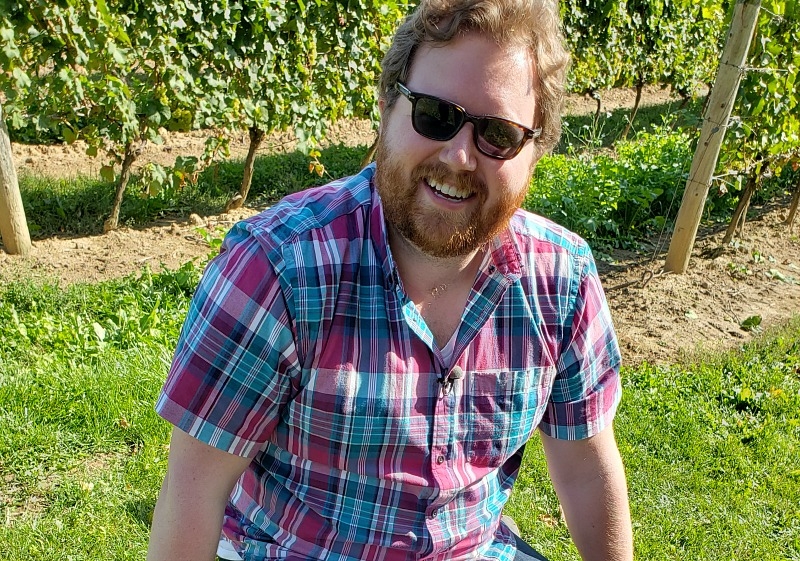
A man smiles into the camera.
By Alex Smyth
By now, you have probably heard at least one person talk (or rave) about the new Netflix documentary series, Tiger King. It is a seven-part project that seemingly came out of nowhere and instantly captivated the country, if not the world.
If you have avoided the show until now, or was unaware of it at all, you may be asking yourself whether you should give it a watch. Before you do, I am here to help make your choice easier. I will break down the pros and cons of the show and explain who the show is for, and who may not enjoy this series. But first, the basics!
What’s it called? Tiger King: Murder, Mayhem, and Madness
Where can I watch it? Netflix (dun dun)
How long is the series? It is a seven-part series and each episode is between 40-50 minutes in length
Without spoiling anything, what’s it about? It is a true-crime documentary that explores the world of private zoos in America, with a focus on three characters who have made a name for themselves in the world of big cats. You learn about how they operate, you hear their stories, and learn about all the truly insane things that takes place in the world of big cats.
Why is it so popular? At first glance, Tiger King seems like an exposé on exotic animal owners and the shady world of private zoos. BUT, as soon as you feel the focus of the show is clear, another crazy element comes into play. Every episode offers a new, unexpected ripple in the story of these larger than life personalities, all vying to be the king (or queen) of big cats.
Should I watch? This is the big question, and the simple answer is, it depends. To clear up if Tiger King is right for you, I will present both the reasons to watch and the reasons to pass on this show and let you decide for yourself.
Reasons to watch: This is the program to watch if you love true crime, crazy characters, and learning about an industry you did not know much about before. Joe Exotic (not his real name) is as charismatic as they come, and he is your main focus, guiding you through this series. He is a gun-loving staunch Republican, that also happens to be openly gay and married to two men, in Oklahoma. That is just one of the vast array of characters you meet!
Tiger King offers so many subplots and threats that it can be hard to keep it all straight. It has suspicious disappearances, murder plots, sex cults, corporate backstabbing, illegal animal trade, political campaigns, and so much more! This is so different from anything else you will watch that it will be all you can think about as you take in the roughly seven-hour run-time.
Reasons to pass: This is a show that focuses on private zoos and the people who run them, so as a result there are numerous instances that show animal abuse or mistreatment, often at the hands of the main characters for the same of money or entertainment. There are also multiple instances of graphic scenes, including in the first episode, when handlers and staff are violently attacked by the animals. There is also an off-screen death in this series, which for many is not something they want to witness.
Another aspect of Tiger King that may be a deterrent for some viewers is the fact that none of main characters of the series are innocent or focused on the interests of animals in their care. They are worried about their own power and fame, abusing the people and animals they control.
If you aren’t interested in following people who are all complicit in the abuse and mistreatment of animals and people to elevate themselves, then this series is one you should definitely not watch.
Final Thoughts? Personally, I found Tiger King to be captivating and I was hooked from start to finish. There were so many other moments in the show that I didn’t mention because every minute there’s something new that surprises or shocks you.
Technically, the storytelling is confusing as it jumps between the present and past, with a narrator that appears at the beginning and then is not seen until the end again. I find that all a reflection of how jumbled and crazy the story is itself with no true start and finish.
While I personally tell all my friends and family to watch Tiger King, I know it is not for everyone. So hopefully, by reading through the pros and cons, you can decide if this show is right for you or not. With the state of social distancing and the need to limit interactions with others, a show like Tiger King, can serve as a welcomed distraction, at least for a few hours.
Alex Smyth's Tangy Summer Salad
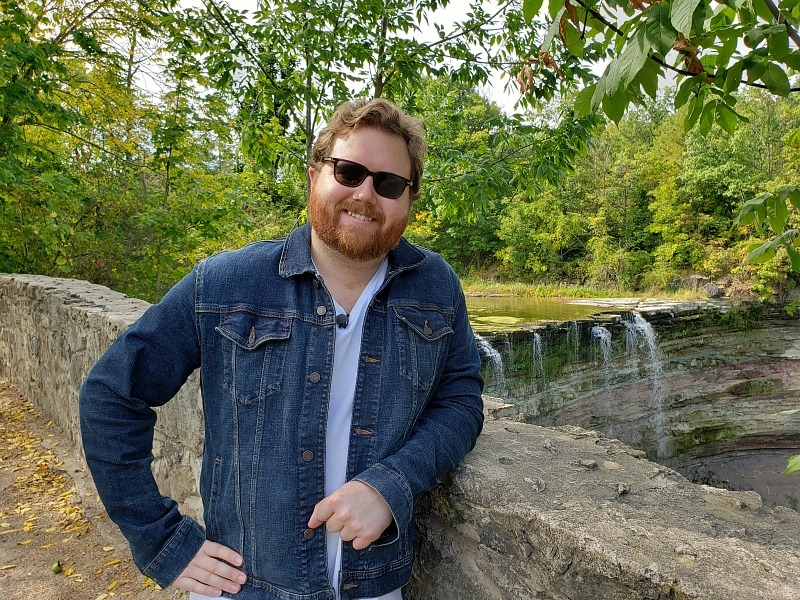
A man smiles into the camera.
By Alex Smyth
The sun has started to shine brighter, the weather outside is getting more pleasant, and it’s time for our meals to reflect the change in season. This recipe is for a Tangy Summer Salad, it’s light, bright, and full of flavour. I always love having this on a warm spring/summer day, and it makes the perfect companion for just about any meal!
Ingredients
- 6 medium tomatoes
- 1 small/medium onion
- 1 large cucumber
- ½ cup white sugar
- ½ cup of white vinegar
- ½ cup of oil
- Salt and pepper to season
Directions
1. Cut tomatoes into 1-inch cubes, making sure to remove the hard white core.
2. Cut the cucumber in half lengthwise twice, so you have four equal strips of cucumber.
3. Holding the four strips together, cut the cucumber into ½-inch pieces and set aside.
4. Placing the onion root side down, slice it in half vertically, and remove the dried outer layer.
5. Thinly slice the two halves of the onion lengthwise, making sure to remove the root once sliced. Set aside with tomatoes and cucumber.
6. In a large bowl, mix most of the sugar, oil, and vinegar together, keeping a small amount to adjust according to personal preference.
7. Add the tomatoes, cucumber, and onion and mix.
8. Season with salt and pepper, and add remaining sugar, vinegar, and oil as needed for taste.
9. Serve and enjoy!
Grant's thoughts on COVID-19
By Grant Hardy
Never in my almost 30 years on this planet have I experienced something as confusing, strange and uncertain as COVID-19. While, in reality, this situation has been developing since late 2019 with a mysterious outbreak of pneumonia in Wuhan, China, in reality I feel like we haven’t begun to appreciate the full repercussions until these last few short weeks.
Less than two weeks ago I took part in a busy open house celebrating our new AMI Vancouver bureau, reported for two action-packed shoots for AMI This Week, and walked around a local mall without a thought. Suddenly, it feels like life has ground to a near standstill as events and travel are canceled, venues close their doors, and we’re asked to do the opposite that our human instinct tells us to do in the face of uncertainty: stay apart rather than gather together.
For me, the change has been sudden and abrupt. Spending days at home is isolating. Grocery delivery services are either swamped or totally unavailable, and I’d like to put the message out there that if at all possible, people should leave these services for seniors, people with disabilities, and others who find shopping challenging. And taking things a day at a time, rather than becoming overwhelmed by wondering about the future, is tricky. At work, I think we’re all trying to adapt and adjust to this new reality and keep things as normal as possible.
However, we will get through this! To think on the positive side, I would like firstly to give thanks for several things. I am thankful to live in a time and place where there are lots of tools for keeping us together even if we physically can’t congregate. I guess I’ve acquired the stereotype of the “tech guy” around AMI—but I love technology because it keeps us connected and improves our lives. This means even though I’m not sure when I’ll be able to get together with my family, they’re still just a conference call away. And even though my favourite local hangout spots are closed, I can still follow my neighbours' updates to know that they’re safe and and reasonably well. It’s not the same as a hug or a chat over coffee, but at least we’re not totally in the dark about how we’re all doing. Technology also ensures the latest critical news alerts are just a click—or tap—away. I’d love to see some of the COVID-19 charts and graphs that are referenced in the news be made accessible, as often I’m guessing at a critical part of a news article because the data is presented in an image. And I understand many press conferences are not appropriately accessible for people who are deaf or hard of hearing. But in general, most of the information I need is at my fingertips.
I am thankful to live in a country with a good social safety net and free health care. I can’t imagine what it would be like not wanting to admit I’m sick, or not seeking medical care, for fear of having to pay out of pocket, or not being able to pay.
Lastly, I am thankful for everyone who is taking COVID-19 seriously. Social distancing is tough and isolating, and not anything anybody wants to do. But it also saves lives and helps flatten the curve—which is the technical way of saying it helps health care professionals do what they need to do so that we can get through this as best as possible. And I applaud that most people seem to be taking the gravity of the situation seriously. Speaking of health care professionals—I am thankful for these doctors, nurses and other staff who are there for us no matter what, even in strange and difficult times like these.
And lastly, I want to give a shoutout to all of you reading this. These are challenging and unprecedented times. It may take a while. But we will get through it, together.
Laura Bain: Memoirs to Cozy Up With
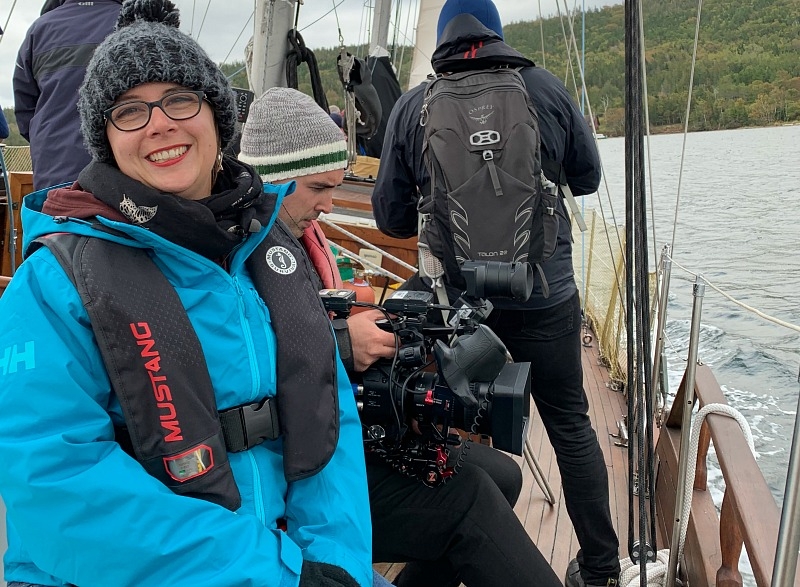
A woman sits on board a boat at sea. She is dressed for winter weather.
By Laura Bain
Reading has always been a favourite pastime of mine and even during busy times, I usually manage to get through at least a book or two a month. The current slowdown which many of us are feeling (shout-out to the many essential workers who are experiencing the very opposite), lends itself perfectly to knocking some titles off my reading list. If you find yourself with more couch time than usual, here are three autobiographies that you can get cozy with. They are all written by authors with disabilities and reflect the diversity of experiences and perspectives contained within our community.
Laughing at My Nightmare by Shane Burcaw is an absolute delight to listen to. So much so that upon completion I immediately downloaded and listened to his second book Strangers Assume My Girlfriend is My Nurse. I purchased the version available through Audible, narrated by Kirby Heyborne. Some of you might be familiar with Shane and his wife Hannah from their YouTube channel, Squirmy and Grubs (if you are not, I highly recommend checking them out). Laughing at My Nightmare is Shane’s account of his life from infancy to early adulthood. The title delivers as promised; the book is laugh out loud funny. Shane, who has Spinal Muscular Atrophy, describes himself physically as an “alien-like pterodactyl creature in a wheelchair,” and suggests to readers that while he explains some of the “boring aspects” of his disability, they light their hair on fire and try to finish the chapter before their scalp melts to keep it more interesting. The book touches on difficult topics such as harm inflicted by medical professionals and encounters with ableism. Shane is a motivational speaker and I found that this book contained helpful life advice such as asking of each problem “in 10 years, will my life be irreparably harmed by this?” Shane’s sense of humour makes this book an easy, light-feeling read which may make it a perfect choice if you are feeling a bit heavy these days.
Jen Powley is well known in the Halifax disability community. I was pleasantly surprised to find her locally published autobiography Just Jen: Thriving Through Multiple Sclerosis available through Audible. Just Jen is beautifully written, an especially impressive feature considering that Jen dictated the entire book to an assistant who then read each passage back to her. Chapter 1 begins, “when Myles first slept with me, I had already begun using a manual wheelchair.” This is the type of intimate honesty you can expect throughout the book as Jen recounts the time from her Multiple Sclerosis diagnosis at age 15 to her present-day life as a disability rights activist (among many other things). As a reader, I had the feeling Jen didn’t hold anything back when writing this memoir. Many disability rights activists, including Jen, present publicly as a picture of perpetual strength. I did take away an impression of her strength from this book, but also a sense of her struggles, fatigue, and fear as Jen continually adapts to her degenerative condition. Jen is darkly witty throughout the book, but you are more likely to be moved to tears than laughter, especially during the touching passages about her relationship with her partner, Tom.
Cockeyed: A Memoir of Blindness by Ryan Knighton had been on my reading list for several years and admittedly I’d started and put it down several times. I’m not sure whether this is reflective of how much I enjoyed the book, or simply that it wasn’t available through Audible so I had to seek it out through CELA – a wonderful service but a platform I am less familiar with. I believe the version I listened to was narrated by a CNIB volunteer reader. Again, a wonderful service, but I felt the older British narrator wasn’t a perfect match for the tone of this book. Rather than being laugh out loud funny, Cockeyed is smart and sharply witty. I have Retinitis Pigmentosa, the same condition as Ryan. I was diagnosed as a toddler, and Ryan was diagnosed at 19. It was interesting for me to compare the similarities and differences in our experiences with the same condition. Because Ryan grew up thinking of himself as sighted, he had to grieve an identity of himself as a non-disabled person, something I’ve never had to do. Ryan did not have the same early experiences I had with other disabled peers and so describes himself as having a “paralyzing fear of other blind people.” Not all readers will appreciate Ryan’s references to Greek mythology and philosophy, but most blind and partially sighted readers will relate to the endless comedies of errors he experiences. I found myself physically cringing as he tries to pass as sighted in very challenging situations such as teaching English in a foreign country or working as an assistant in a busy office. Although this was a book I could put down, I enjoyed it and think other readers, especially those connected to blindness, will too.
When you think you might have it, but can’t confirm you have it

A woman wearing a medical mask over her nose and mouth flashes the peace sign into the camera.
By Shelby Travers
Let me first start off by saying, everything that follows is my personal experience. I can’t speak to anyone else's, nor confirm anything. In fact, that’s kind of why I’m writing this.
Day 1: I woke up feeling drained. My throat was sore, and I had a slight cough. Given the news, I tried not to overthink it. After all, I’ve been feeling very tired lately, and I commonly get sick before my period. I went to work and didn’t feel better. As the day progressed, I felt worse. So, I went home, laid in bed and took my temperature; it was 99.8 degrees.
At this point, I’m fearful. I’m in Ottawa in a tiny apartment with a guide dog to care for. My parents are far, my brothers are far. I knew I needed to isolate, but I never knew I’d feel so vulnerable and alone.
I decide to talk to my parents, and I try to relieve their stress. “I will wait until the morning to see how I am. Maybe it’s just a 24-hour flu,” I say to assure my family and colleagues.
Day 2: I barely slept. My throat is no longer sore, but my body is aching. My cough is consistent. My lungs are tight. I feel like I have a weight on my chest with every inhale and a squeeze on every exhale. My temperature is now 100.1. I research protocol. Despite the symptoms, I don’t meet the criteria for testing. I haven’t travelled in the past two weeks and I have no idea if I’ve been around someone who has COVID-19. I cry in my bed. I call my dad. I then call Public Health Ottawa.
After the expected wait of an hour on hold, I speak to a nurse. I give all my information and symptoms. She relays to me that since I have not recently travelled, or had no confirmed contact with a case, I was not eligible for testing at the assessment center. I explain my situation as someone with a disability, and how I have no family around. I can’t get tested. It’s the unfortunate truth for so many. It’s why we will truly never know the numbers of COVID-19.
Day 3: My temperature is back down to 99.8 and the rest of the symptoms remain the same. A dreaded, dry, consistent cough. A body that just feels broken. A migraine like headache that just won’t ease up. And then the fatigue.
My dad decides he will drive to Ottawa the following day to come get me. After all, I can’t get on a train or a plane in my condition. I feel a sense of ease.
Day 4: I wake up, and I’m starting to feel more normal. My temperature reports as normal. My body and mind feel slightly more energized and instead of coughing every five seconds, I now cough every 20 second (OK, I’m slightly exaggerating).
I spend the morning packing for spending the foreseeable future at my dad’s. I now realize that I must have been in a daze because my pants to shirts ratio is very off.
When he arrives, he hugs me and says “You’re damp. What were you doing?” Well, I guess the cold sweats have come back. Hello, fever. My old friend.
I spent the drive wearing a mask, resting, but even though I felt sick. I felt safe. I was now with loved ones.
Days 5 & 6: I feel like myself again. The cough is there, but mostly when I’m laying down or moving. So much better than it has been. I am still tired but that’s mostly due to the lack of sleep. Once again, the coughing when I’m laying down isn’t great.
My voice is cracky and at times I lose it, but I know I am miles ahead of what I was feeling. My grandma came over and it hurt me that I couldn’t spend time with her. It’s not easy to stay away from the ones you love. But, it’s so important. Even though I am feeling better, I still know the risks aren’t worth it.
Day 7: That’s today, March 20. I feel like myself, I sound like myself. My cough is infrequent. My headache is gone. My chest tightness feels almost gone.
I reflect on how I felt on Day 1 to 3. It was awful. I was so scared, and I am so grateful I have family that is able to at least come get me and bring me to safety. Not everyone is so lucky. I can’t say whether or not I had/have COVID-19. But that’s the situation we are globally in right now and this is why I am sharing this.
COVID-19 is incredibly contagious, and we don’t know who has it. Frankly, we do not have the resources to determine who must quarantine and who doesn’t. Therefore, we societally have to all make the conscious decision to keep our community safe.
I am not sharing my experience for anyone to self-diagnose; nor is that what I am doing. But rather, I hope that by me sharing my experience—which is so much like so many others—it can shed some perspective to those that don’t take this virus or situation seriously.
If you are struggling mentally, please visit The Lifeline Canada Foundation for a list of crisis helplines.
How and why I practice self-care
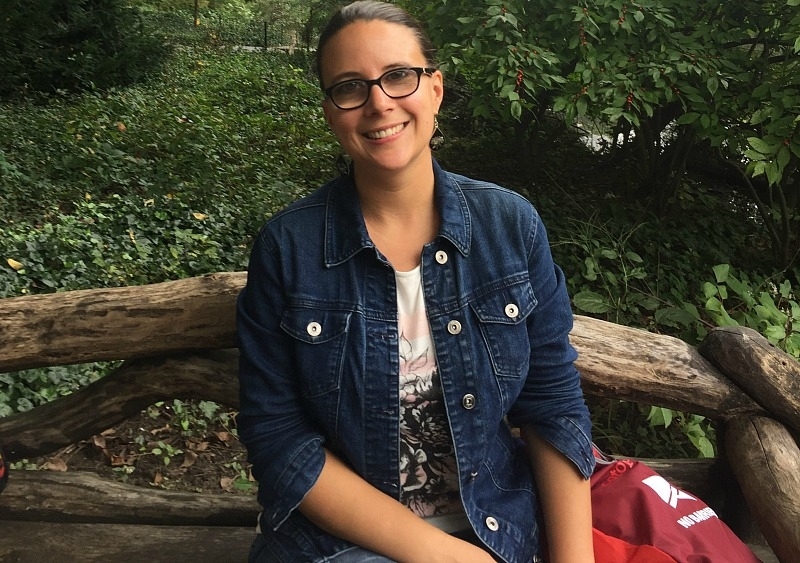
A woman smiles into the camera.
By Laura Bain
Self-care is a concept that we hear a lot about lately, but what is it and how do we practice it? To me, self-care is an antidote to all the things that chip away at our physical, mental and spiritual well-being. This seems like a particularly relevant topic right now. I’m writing this while working from home during the COVID-19 pandemic. There is a collective sense of anxiety unprecedented by anything many of us have felt before. On a more personal level, I have been dealing with a decline in my eyesight over the last few months that has created challenges as I adjust to new ways of accomplishing my daily living and work tasks.
Recently, I’ve heard some people talk about metaphorical spoons – that we only have so many spoons each day to scoop up everything that life throws at us and that, depending on the day, one may reach a breaking point and “have no more spoons.” As disabled people, we tend to encounter many more hassles in the run of a day whether it be organizing transportation, coordinating care workers, figuring out how we are going to get errands done, or educating well-meaning strangers. That’s a lot to scoop up! So how do we get our spoons back?
I don’t know whether it is because I am naturally an introvert, or whether it is because of the additional hassles I experience moving through the world as a disabled person, but for me self-care starts with familiarity, such as being in a safe familiar environment like my apartment (not a problem right now). Some “in apartment” activities that restore my energy include yoga or simple stretching, playing guitar, practicing mindfulness mediation and listening to audiobooks.
One of the most helpful things I have done for my mental health is to take ownership of the media I consume. I believe that what we hear and watch affects us more than we realize. So rather than always listening to the news in the background, as I used to do, I start and end my day with uplifting and inspiring audio material. Some of my favourite podcasts include Good Life Project, Oprah’s Super Soul Conversations, The RobCast, The Rich Roll Podcast and Ten Percent Happier with Dan Harris.
I am also a big believer in what my grandmother would have called “taking a constitutional.” I don’t feel right if I don’t get outside at least once a day for a walk. Back to an earlier point, if I’m stressed, I like to walk a familiar route. This decreases the hassles associated with navigating an unfamiliar environment. I don’t listen to any audio while I walk other than the natural sounds around me. Having time with my thoughts allows me to process and resolve any nagging anxieties.
Even we introverts need social connection and at least a few times a week I connect with friends and family either in person or over the phone. Some people feed us energy whereas others are more draining. I try to evaluate my spoon level and reach out accordingly.
Some other ways I take care of myself include eating healthy, trying to sweat at least once a day, and occasionally dancing like no one is watching (because hopefully they aren’t) around my kitchen to clichéd cheesy music.
These are the things that help me to replenish and feel well. Whatever your personality or abilities I encourage you to find the things that work for you. It is not selfish to practice self-care. By being the best version of yourself you will be better able to take on the stress of the world and support those around you.
Laura Bain previews Postcards From Halifax
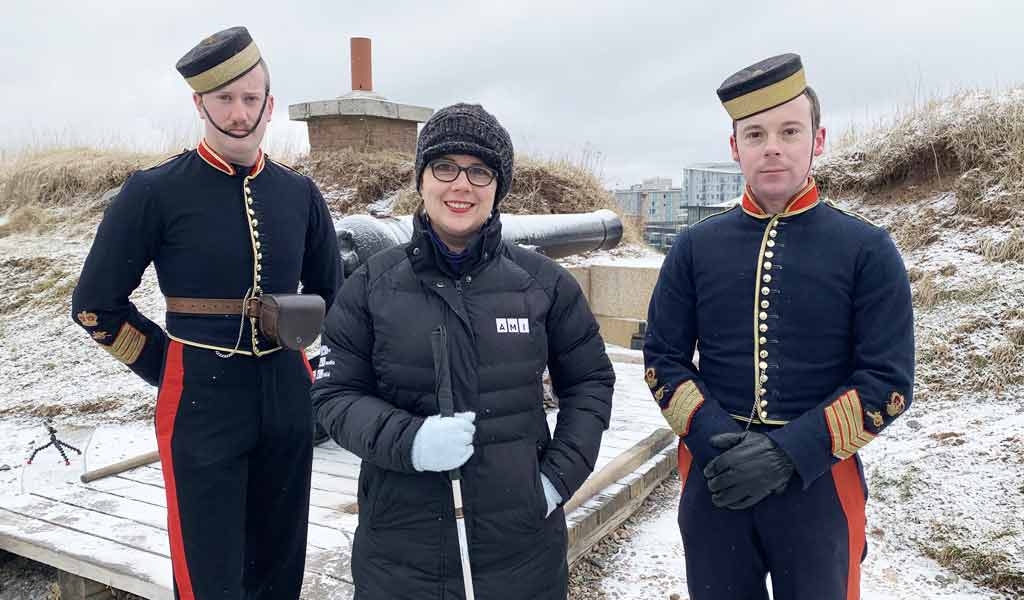
A woman smiles into the camera. She is holding a white cane. Men in historical military garb stand next to her.
By Laura Bain
Postcards From Halifax debuts Friday, April 3, at 8 p.m. Eastern on AMI-tv. This is the most recent episode in the Postcards From series and was filmed over the past few months by our Halifax team in, you guessed it, my hometown of Halifax, Nova Scotia. In it, we highlight some of the best places you can visit during a trip to Halifax.
It feels odd to think of taking a trip anywhere right now. International borders are closed for non-essential travel and there are even restrictions when crossing between provinces. Many of us are feeling disappointed over cancelled travel plans although we know the best thing we can do right now is to stay home.
Watching the final cut of Postcards From Halifax while at home on my work laptop, I marvel at the changes we have experienced in just the few short weeks since wrapping filming. Almost all of the places featured in the special are now, temporarily we hope, closed. My emotions are mixed. Partly, I feel a sense of loss and sadness. Many of the places featured in the special such as the Halifax Central Library, The Seaport Farmers' Market, and the Emera Oval are, if not weekly stops for me, places I’ve visited countless times and assumed would always be available. I had certainly planned to get at least one more skate on The Oval in before the spring thaw!
I also feel a sense of home and connection in seeing so many of the places I love. It is wonderful to watch families and friends out together enjoying the fresh air, or shoppers casually perusing the food and craft stalls at the market. I had the chance to meet so many wonderful people during the filming such as winter surfer Jan LaPierre, musician Joel Plaskett, and Halifax Town Crier Will Brewer. Being cooped up in my apartment these last few weeks, it is nice to see their faces and be reminded of our connection and an easier time.
It is very possible that you won’t be able to take a trip to Halifax in the next few months, or anywhere for that matter. Maybe your travel plans have been cancelled and you are feeling sad. I have an international trip planned for the fall which is very much up in the air right now. This coming Friday, let me do the best I can and take you on a tour of Halifax from your living room. I promise there will be history, music, food, and places on and off the beaten track. We will visit some of the oldest places in the city, and some of the most modern. We will travel to Peggy’s Cove, one of the most scenic spots in Canada, and witness the less scenic image of me eating a giant messy donut.
Pack your bags (by which I mean get in your jammies and make snacks) and join me on April 3rd for a fun-filled staycation to Halifax! No gloves, masks, or disinfectant wipes required!
Stream Postcards From Halifax.
Staying sane in these insane times
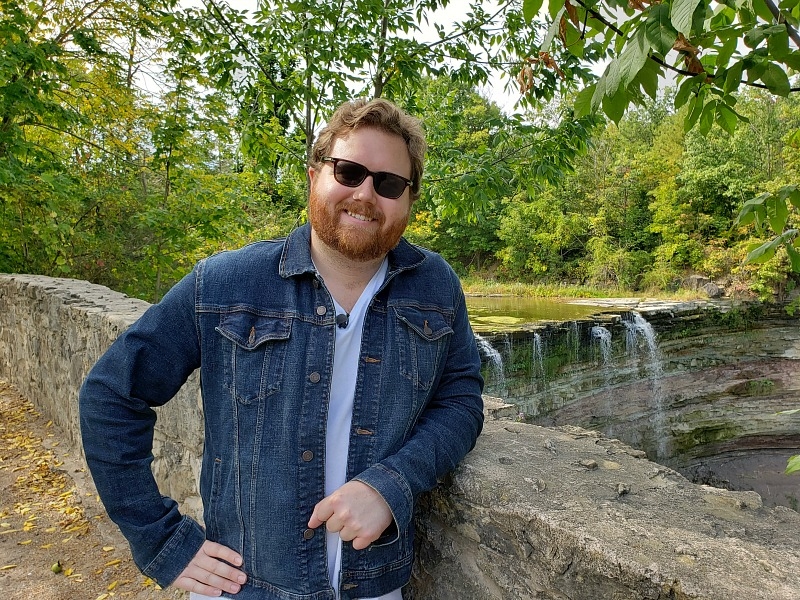
A man smiles into the camera.
By Alex Smyth
Well, this has been a crazy few weeks, hasn’t it? It was only a couple months ago that we were hopeful of a bright 2020 and all the possibilities the new year had in store for us. Now, we are confined to our homes and told to limit our exposure with the rest of the world.
Every day new questions arise, how many new cases? How long will this go on? Do I have it? What about my elderly relatives? These are normal questions to ask, I know because I have asked myself every single one of these while sitting at home.
As you have heard countless leaders say, “these are unprecedented times.” So in these unprecedented times, how do we keep ourselves active, both mentally and physically while following the guidelines of our government and healthcare professionals? How do we keep ourselves from viewing our homes as prisons? And for those who are isolated, how do we satisfy our social needs?
There are a number of choices when it comes to entertainment available, from streaming services, to video games, books, etc., but after Day 5 they don’t have the same appeal as they initially did. They can become boring, or even worse, frustrating.
So what do you do to combat that frustration? Here are few ways that I have learned to deal with this unique situation:
Create a Routine
Structuring your day as much as you can helps to build a routine and prevents your day (and your place) from becoming blended and messy. By keeping a routine and structure, you can help separate the various tasks of the day and set clear objectives to break up your time. This can help provide you with a focus and direct you on what to do. For me, starting my day with work, I have been able to keep consistent flow to the day. My routine goes as follows:
8:30 a.m. – Wake up
9:00 a.m. – Start work
12:00 p.m. – Lunch Break
1:00 p.m. – Back to work
5:00 p.m. – Work out
5:30 p.m. – Shower/Prep Dinner
6:00 p.m. – Eat/Relax in the evening
11:30 p.m. – Head to Bed
By keeping this structure relatively intact, I have been able to get through the days easier, and maintain a sense of normalcy as if I was still working in the office every day.
Separate your Space
This builds off of creating a routine and has the same objective. By keeping spaces separated, i.e.: eating area and entertainment area, it allows you to think about the activity you are doing and lets you focus on the task at hand. For me, I have a dedicated space for work, and work only. This allows me to mentally dedicate myself to working while I am sitting at my desk. Same thing applies to when I eat, relax, and work out. Which brings us to our next tip.
Work that Body
For myself, when I am at home, I like to crash on the couch, watch TV and do as little as physically possible. But in a situation like the one we are currently in, it’s important to break that habit. I have set aside time every day at the same time to go and work out. Now, all this means is going to my bedroom and utilizing a combination of weight free exercises like push-ups and the single 20-lb. dumbbell I have on hand. But by using the limited resources I have, I am still able to stay active and physically exercise my body. It also allows me to focus on the act of exercising and clear my mind. Now I recognize that not everyone is able to work out in the same way, but if you are able to do something within your abilities, it will help to shift focus, even for a little bit.
Embrace Social Face Time
In the new world of social distancing, it doesn’t mean we can’t have some face time with our friends and family. Utilizing tools like Skype or FaceTime (see what I did there?), it is important to have video calls and conversations with your social circle. Even if you have vision loss like me, or no vision at all, because the types of reactions and interactions you have when there is a visual element involved is much different than when it is a traditional phone call. This tip is especially important when dealing with isolation, as social interaction is vital for your mental health and ensuring that this period is as comfortable as it can be.
Learn/Improve a Skill
With a sudden increase in downtime and nowhere to go, why not take advantage of the countless videos, tutorials, or blogs online that offer lessons or instructions on anything and everything you could possibly think of. From learning new cooking recipes (like some available on www.ami.ca) to learning how to speak a new language, there is something for everyone to choose from, both free and paid. By investing time into learning something new, you provide an outlet for your creative energy and you try something you haven’t done before. For me, I enjoy writing and playing guitar, so having some downtime, I look forward to learning a new song or two and exercising my mind.
These are a few of the things that I have incorporated into my daily life during this crazy time to help me stay sane and stay inside. Getting though this pandemic takes everyone working together, directly through our medical professionals and front-line workers, and indirectly, through us the general population, listening to the advice and guidance of these experts. The sooner we do, the sooner we can start to get back how things were at the start of 2020, bright and full of hope!
Grant Hardy celebrates Surrey's accessibility
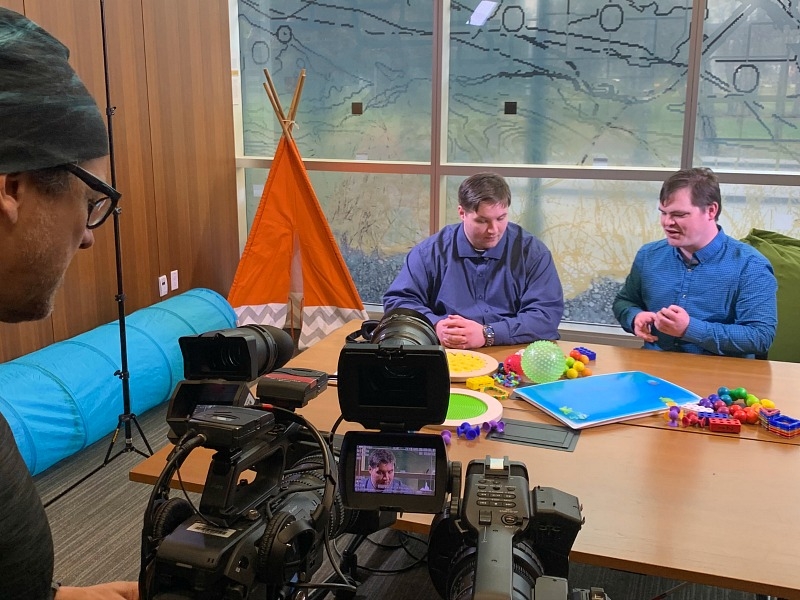
Two men sit at a table, talking. A television camera films the conversation.
By Grant Hardy
I was born and raised in Surrey, B.C., so I'm especially proud knowing Surrey is a leader in accessibility. In fact, dare I say it, Vancouver could learn a thing or two from the city of Surrey.
While I now live in Vancouver, I still fondly think back to my time living in Surrey and some of the positive experiences I had there. For example, when I wanted an audible light at a busy intersection near my mom's home, I expected us to have to jump through a lot of hoops to get it. Instead, after submitting a simple email request asking for the light, the city sent an acknowledgement of my request stating that the light would be installed. Sure enough, a little while later—there it was. Now that's what I call accessibility.
But enough about me. This summer on AMI This Week, you'll see a story we shot specifically looking at some new initiatives the city of Surrey is beginning for people on the Autism Spectrum. The city is rolling out sensory-friendly spaces to community centres and events across Surrey, and I got to see what they look like. They're places people can go who need to escape the overwhelming noise and other stimuli you're likely to find at community events. In these rooms, there are things like bean bag chairs, tipis, noise canceling headphones, and fidget spinners. These help folks unwind and relax however they need to. There are even sensory-friendly kits you can carry around with noise canceling headphones and some toys, so a person on the spectrum always has something comforting available.
According to Tara Roberts, Manager of Support Services and Accessibility with the City of Surrey, these two initiatives are literally the difference between families attending events or feeling unable to. For instance, Canada Day is full of noisy fireworks and other overwhelming stimuli, but with a pair of noise canceling headphones and a few comforting toys, more people are able to enjoy these events with their families—sometimes for the first time.
I'm impressed the city hires people with disabilities as part of the consultation process. Sylvain, who gave me the grand tour, is an extremely genuine person who raved about the opportunity to work for such an inclusive employer. He says it's his favourite job by far, and there's no doubt he's been able to help make a difference in the community.
We also headed to a busy Surrey Fire Hall to learn about some of the sensory-friendly initiatives that are being rolled out with first responders. Fire trucks will be equipped with sensory friendly kits containing the noise canceling headphones and other toys, so in the midst of an extremely overwhelming emergency situation, those who need a calming distraction can have one. But emergency responders are also being given new training on communicating with people on the autism spectrum, like communication boards where a person with a disability could point to a body part that's hurting, or an emotion they're feeling. It's a good step towards realizing that someone whom a first responder may have simply assumed was unpredictable, might be a person with a disability in need of extra assistance.
As is the case with most accessibility initiatives, I believe the benefits will be felt by everyone. Having more inclusive events that a diverse group of people can attend benefits everyone—and you just might get to meet someone as down-to-earth and kind as Sylvain, and maybe make a new connection or a friend. And by thinking about improving the interaction people on the autism spectrum have with our emergency responders, we know our communities are going to be healthier and safer.
These days, it sure doesn't hurt to hear a heart-warming story. And I think what the city of Surrey is doing definitely fits that bill.
Covid-19 advice from Beth Deer
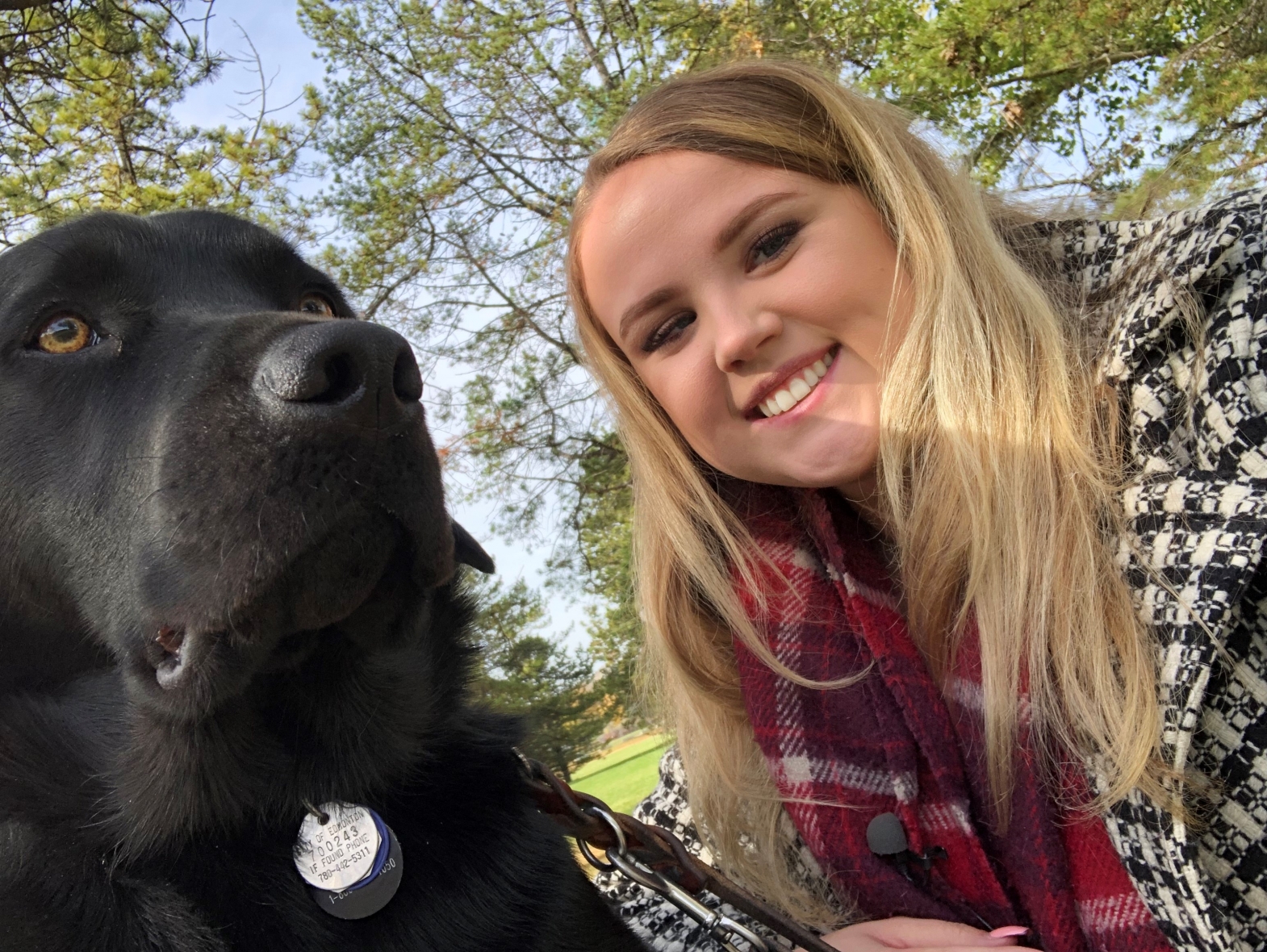
A woman smiles into the camera. Her guide dog sits next to her.
By Beth Deer
During this time of social distancing, working from home and keeping to ourselves, I thought I would give you my take on Covid-19 and some facts on how you can stay safe.
Ever since I was a child, I have had an intense anxiety and fear of getting ill. Despite my fear, I’ve never entertained the idea of a global pandemic. Now it’s happening and I would be lying if I said my fear of getting ill isn’t controlling the way I’m behaving.
Living in another country and being away from your family at a time like this is very unnerving. However, there is plenty I can do to protect myself and the people I love.
I know everyone is feeling nervous about trips to the grocery store but one thing no one seems to be talking about is what happens when you get home. You have bought all of this food that everyone in the store has been touching. Remember to wash your fresh items, people! FYI, you should probably do that even when there’s no Covid-19.
If you are trying to be extra careful, like myself, you’ll want to stop ordering food. You have no idea who prepared your food, how it was prepped and how many people have touched it before it gets to you. If you want to support local restaurants and businesses you can buy gift cards to use after this time has passed. Preferably purchase them online, if possible.
A little tip when using hand sanitizer: it should take 20 seconds to fully dry if you are using the proper amount to kill the most bacteria.
As you probably already know, hand sanitizer is sold out everywhere but that's OK because hand washing is the most effective way to kill bacteria. Here is a refresher on how to wash your hands properly:
1. Wet your hands.
2. Add soap, rub hands together to lather.
3. Make sure to get your palms, in between fingers, finger tips, thumbs and wrists.
4. Continue this for 20 seconds.
5. Rinse your hands under running water.
At this time if you’re feeling fine and think all of these precautions are being blown out of proportion, please remember you’re not just protecting yourself. You’re protecting the vulnerable. I have several people in my family that are high risk for contracting the virus so I ask you to please do your part to stop the spread. I know some people still don’t want to wash their hands, but don’t be that person. If you’re not doing it for you, do it for somebody else.
One last tip, if you’re like me and riddled with anxiety but still want to know the facts. Stay off of social media. It’s honestly mind blowing how much of an influence social media and your friends can have on a feeling that you can’t even control. Watch the evening news once a day and don’t overwhelm yourself with stories from around the world regarding the disease. Your best source is to check your provincial government’s website as they will have all of the up to date information for your area.
Stay clean everyone!
Beth and Patronus visit Canine Coastal Hydrotherapy
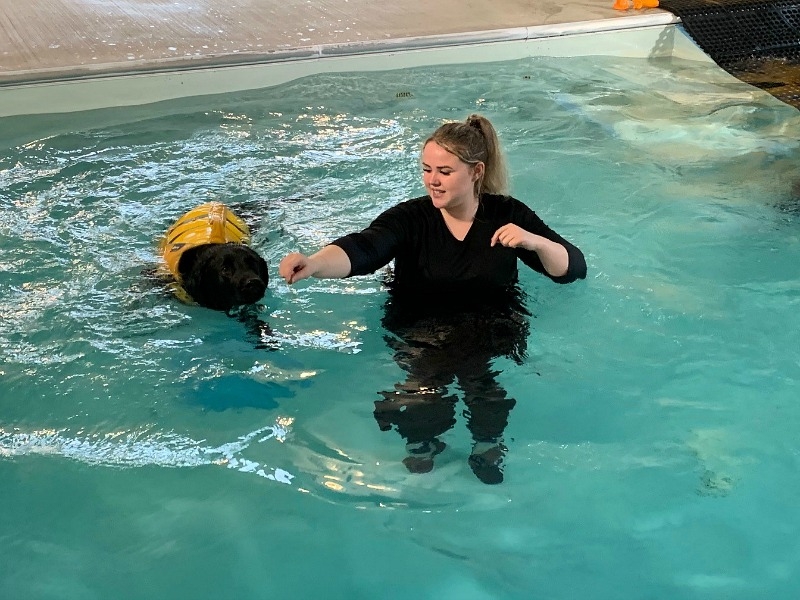
A woman and her guide dog swim in a pool.
By Beth Deer
Whilst on Vancouver Island we took a trip, or should I say dip to Canine Coastal Hydrotherapy and Fitness Centre. Since being a guide dog owner, I’ve always wanted to give back to Patronus. I feel like I am never going to be able to thank him for what he’s done for me but this venture was all about him. I wanted him to be able to stop thinking like a guide dog for five minutes and just be a pup.
We arrived early on a Sunday morning to be greeted by owner Carolyn and her partner. Our team was shown to the pool so we could set up and Patronus could have a sniff around. The pool was 16 feet by 34 feet and built purely for doggy use. There was a flat hard rubber ramp that lead from one corner of the pool into the water, below this there was stairs - which were meant for humans.
Carolyn started off by getting Patronus to play with a toy at the beginning of the ramp. She had so many toys and used a squeaky pig to get Patronus comfortable around the ramp and the water. She told me several times, “He’s not going to have any problem,” as he nearly jumped in the water when he knocked the toy over the edge. Next she put a yellow doggy life vest on him, darn did he look cute! Carolyn asked me to get in the water first which was probably a good thing as it was helpful to get my bearings.
Before I knew it, Patronus was in the pool with me. The ramp was the perfect height for him to stand. Once he was comfortable standing in the water Carolyn had him do lots of little activities. Weaving in and out of poles, swimming next to her and grabbing his toy under water.
My personal favourite was when I threw the toy for him, he swam to it and bought it back to me. You might think a dog playing fetch is pretty simple but most guide dogs have the retrieving part bred out of them. This was the first time I had ever witnessed Patronus fetch anything and I was so happy. I felt like he had left work behind and was just having a good time.
Unfortunately, our session came to an abrupt end when Patronus decided to get out of the pool. It’s very normal for dogs to consume a lot of water when they are swimming. Patronus definitely did that and had to go to the bathroom about seven times in the hours after his swim. Carolyn kindly took Patronus to the drying station, where she sprayed him down and dried him with the doggy blow dryer.
Luckily for me, Carolyn had something else to show us before we left. I got back in pool and she called in her three collies. All three of them charged into the pool. Three boogie boards landed in the water then Carolyn jumped in and asked me to steady one of the boards. Next thing I knew, one of the dogs was on the board jumping from the board I was holding to the one Carolyn had in her arms. After this the other two joined the fun. They weaved through the poles that had been lined up in the water and each did a spin on their own boogie board. Safe to say I will not be giving up on Patronus’ swim career any time soon. A dog can have two jobs right?
Watch Beth and Patronus taking a dip!
Skiing after a concussion
A woman and man look into the camera, smiling. They are both dressed for skiing.
By Shelby Travers
As the ski season has come to a close, I wanted to take some time for reflection. What better time than when you’re sick and in isolation, right?
I have skied almost every year since I was four years old. Even prior to that, my mom had me in a backpack as she skied. Since both my parents were active ski patrollers, you could say that the bug was destined to be in me. However, this season was a bit different. Mentally going into it, I had fears. Luckily, these fears weren’t something I was unfamiliar with. I will always remember my first-time skiing after my vision loss at Cypress Mountain. However, this year was my first-time getting back out after an injury.
I don’t think people respect how much strength it takes to keep being yourself after sight loss. Heck, even I don’t. But it’s a lot of bravery to say, “this is scary, but I am still going to do it.” It’s been 12 years with my blindness and brain injury, so sometimes I even forget about it. Until those moments when BAM, I hit something, and my reality is put into place. When I was skiing and hit someone, it was one of those moments. Only this time, it left my already brain injured self to now have a third concussion (not a good situation).
I knew I couldn’t let it hold me back though. Skiing is what I love to do. I had a plan. My plan was to be gentle on myself; and I did that.
I allowed myself to go slower. I allowed myself to communicate to my guide I was fearful. Through this process, I allowed myself to lose my fears.
It took time, and I am still cautious. But I am proud to say that once again my guide Luc and I finished a great season skiing safely, and happily. We even took home the trophy for the second year in a row and skied at a new mountain all together.
If you are someone with a disability interested in getting into skiing, I highly recommend you check out Canadian Adaptive Snowsports.
Beth Deer visits Churchill's British imports
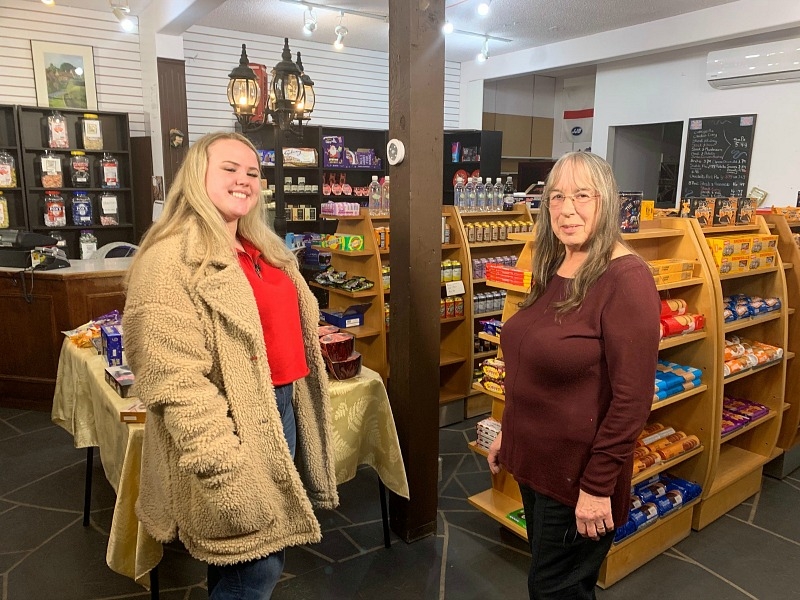
Two women smile into the camera.
By Beth Deer
What do I miss most about home (England) that’s not my family? Food. I don’t know why because it’s not like we don’t have chocolate or biscuits in Canada, but for some strange reason, it’s just not the same.
For a few nights, we stayed in Parksville on Vancouver Island, which just so happened to be home to Churchill's British Imports. Churchill's British Imports is owned by a lovely lady name Christina.
Christina has only recently taken ownership of the shop after she bought it from a legally blind Englishman named Tony. Apparently, Tony was from the north of England but Christina lived in a town very close to where I grew up.
I visited Christina to learn about the history of the shop but also to buy myself some English goodies. Oh man, I went cray to the Z with my purchasing. Lots of English biscuits, chocolate and more. Even while I’m writing this I have the bag of treats behind me and all I want to do is dig in.
Bye!
P.S. When I go back I’m going to be very upset if Christina doesn’t have my fave English treat: Revels.
Watch Beth's adventures on Postcards From Vancouver Island.
Beth Deer's Eagle Wing Tours adventure
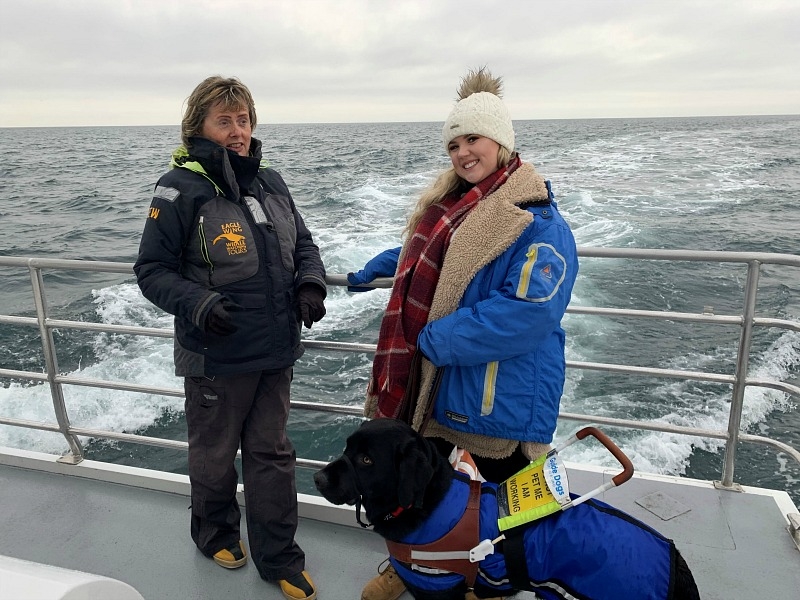
Two women and a guide dog stand on a boat. They are dressed for winter weather.
By Beth Deer
Our team got up early one Monday morning to leave where we’d been staying in Parksville to go whale watching in Victoria. It was about two hours from our hotel to the harbour where we would be boarding the boat to go and find some whales.
Upon our arrival to the harbour we headed to the Eagle Wing Tours office to meet with a lovely lady named Val. Val would be our guide for the day and a what a wonderful guide she was! As we got to the boat It started to drizzle. I was wearing a wooly coat and Patronus had his rain jacket and harness on. It’s a good thing they had coats on board because I didn’t wear the most suitable attire.
After boarding the boat we met with the crew who would be on board the day’s tour. Everyone was so friendly and passionate about what they do. The crew explained to everyone on board where we would be headed and what we would likely be seeing.
Once the crew had spoken to the guests on board we set sail. Val and I stood at the back of the boat as most of the passengers on board had gone to the front. Before long, the captain's voice came over the speaker announcing that he had seen something in the distance. Sure enough, he had seen two humpback whales. Val begun telling me a many interesting facts about humpback whales that I never knew. Here are a few examples:
- They can weigh as much as 40 tons
- Humpbacks don’t have any teeth
- Each whale has a different design on its belly
I would have thought the chances of us seeing many whales in mid-November were not in our favour, but the Eagle Wing crew had been having a lot of luck around this time and being the pros that they are, are amazing at finding them.
Not only did they find the whales, but they found them doing happy slaps with their tails, which apparently is not an everyday occurrence. The sound of the tails and the excitement of all on board was quite the experience.
We lingered around the whales for about two hours until the captain decided it was time to move on to other sea life. We ended up at a little island with one house and a lighthouse. Apparently, only one person lives there and they keep note of all of the wildlife that surrounds the area. On the rocks covering the perimeter of the island were a number of different sea lions. Val told me about some of the different breeds of sea lions and how they are different. The two main breeds we saw were California and stellar sea lions. California’s are drastically smaller then stellar’s and there’s quite a colour difference.
Val was a wonderful guide, and great to chat to both on and off camera. The second those whales came around she had so much passion for educating me and also making my experience especially as a blind person the best it could possibly be. Where she could, she would explain what their different movements meant and what it was looking like. A very big thank you to Val and Eagle Wing Tours for having Patronus and myself. We had a whale of a time!
Watch Beth and Patronus on their whale-watching adventure.
Grant Hardy previews Chasing the Spotlight: Candice Elzinga

A woman sits behind a table. Television cameras are aimed at her.
By Grant Hardy
As the February airdate for our documentary, Chasing the Spotlight, approaches, I’m taking the opportunity to share some interview highlights and behind-the-scenes info about the many interesting characters I spoke to while shooting our documentary.
Last fall, I spoke with Candice Elzinga. She’s a casting director for many high-profile productions, including Amazon Prime's TV show The Man in the High Castle, and the AppleTV+ original series See. We talked about inclusion and accessibility in the acting industry, as well as about her experience working on See.
Created by Steven Knight, See is a television series set several hundred years in the future, when a virus has decimated humanity, and those who survive have lost their sight. The production team wanted to be as authentic as possible, and cast as many people who are blind as they could in See.
Candice described her experience working with actors and consultants who are blind very positively. She said only small accommodations were needed, like ensuring scripts were provided in accessible formats rather than locked-down PDF files, differentiating characters’ lines from stage directions, and providing some basic orientation to and around the audition room. Candice acknowledged the theatre and performing arts industry is extremely competitive, and people with disabilities are underrepresented. But she believes we’re on the precipitous of change, and wants to see an industry where people audition for, and receive, the same roles, whether they are blind, sighted, wheelchair users, or have a variety of other perspectives. As such, Candice encourages everyone from the community to follow their dreams—if a role pops up that someone is passionate about, Candice encourages them to go ahead and apply for it. Sometimes, it simply takes timing and preparedness meeting opportunity—which is why actors have to be careful not to get discouraged by a rejection, or define themselves by the roles they’re cast in. They also need to keep their skills sharp, possibly investing in training to be the best storytellers they can, and to appear confident and well-prepared when entering the audition room. Candice wants to help expand the available training for aspiring actors with disabilities.
In a way, we asked a lot of Candice since we posed questions about the industry as a whole. In reality, we think of acting as very public, but in fact casting is more like a job interview which means privacy is important. But she could still speak in general terms, and I was impressed by her obvious passion towards accessibility, inclusion, and ensuring the right person gets the right role regardless of their ability. Often times, if you have a disability, you need more than hard work and determination. You need someone who believes in you—who understands you’re just as capable as anyone else. You need someone who is willing to provide a little extra time providing training and orientation. I have no doubt Candice is one of those people, and it’s great to know she’s in the industry.
Chasing the Spotlight premieres Friday, February 21, at 8 p.m. Eastern on AMI-tv.
Grant Hardy previews Chasing the Spotlight: Ryan LaChance

A male wheelchair user is filmed by a television crew
By Grant Hardy
On February 21, our newest documentary, Chasing the Spotlight, premieres on AMI-tv. It explores many themes related to artists and performers with disabilities, including the barriers they face accessing an audience—both physical and attitudinal—their need, desire and passion to perform, and the importance for their voices to be heard.
One of the most enjoyable parts in creating a documentary like this is meeting and interacting with the diverse range of people that make up our cast of characters. In the lead-up to our doc, I’ll be highlighting a few of our key characters, starting with professional stand-up comedian Ryan LaChance, who uses a power wheelchair due to quad spastic cerebral palsy.
One thing was clear when I first met Ryan: he’s a natural at making people laugh. In school, it took power away from bullies, since there was nothing for them to pick on when Ryan was already joking about himself. As an adult, it’s a key area of his life that Ryan can control, since when he’s in front of an audience, there’s nothing but him and the microphone and the crowd: his disability fades into the background. It’s no wonder comedy went from a hobby he thought he’d give a shot at open mics, to a profession Ryan uses to pay his bills. And it inspires other audience members, whether they’re simply having a bad day or they have a similar disability and want to follow in Ryan’s footsteps.
But it’s much more than a paycheque. Ryan says comedy is now practically all he thinks about—it’s the best part of his life. That makes the barriers he faces all the more devastating. Some of them are attitudinal, like a harder journey proving himself than most comics faced. Others are physical, like getting up on stage. Ryan required fundraising to secure wheelchair ramps to access stages in multiple inaccessible venues. His latest barrier is a devastating ulcer on the outside of his ankle which, due to his CP, will take many months to heal. This means Ryan’s opportunity to perform stand-up comedy is very limited, and his life’s passion is on hold.
One thing’s for certain, though. Ryan is strong stuff, and I have no doubt he’ll bounce back as soon as possible. It was great meeting Ryan, and I appreciate what he does to make the world a better place. Because if you ever have doubt that laughter is the best medicine, just step into a comedy club on a night when your spirits are low. Comedy will help you feel better. At least, that’s always been my experience.
Chasing the Spotlight premieres Friday, February 21, at 8 p.m. Eastern on AMI-tv.
Beth Deer shares her holiday experience
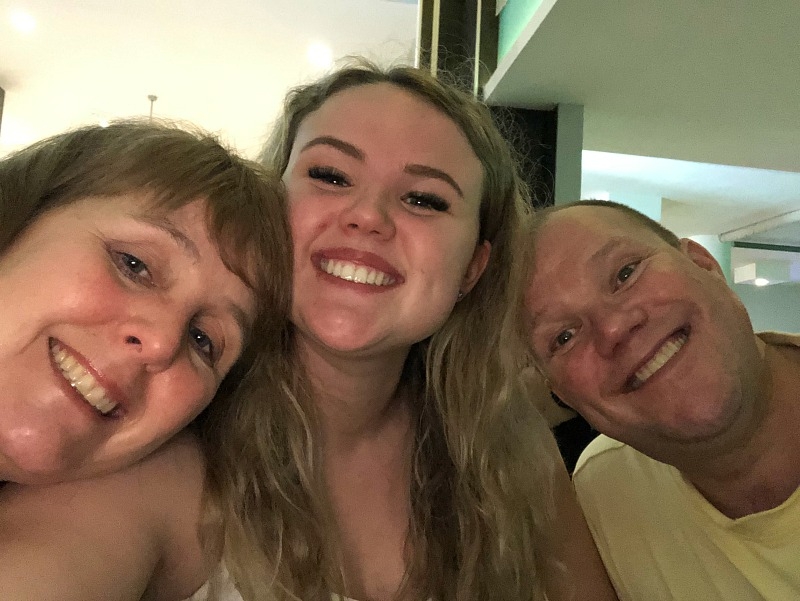
Three women smile into the camera.
By Beth Deer
Living 4,251 miles and seven hours behind my family means I don’t get to talk to or spend as much time with them as I’d like. What better way to get family time in than going to an all-inclusive resort in Jamaica together?
My boyfriend, Cody, and I flew from Edmonton while my parents and sister flew in from London. Cody and I flew out of Edmonton at 1:20 a.m. on December 6 and were scheduled to arrive at our hotel in Jamaica around 1 p.m. that afternoon. After connecting in Toronto, we were so ready for some sun, but the joke was on us as we sat on the tarmac for just over two hours while we waited for our plane to be de-iced. Flying with Cody is a lonely experience; the second he sits down he falls asleep. While sitting on the tarmac I listened to my book and the flight attendants as they told us every five minutes that it would only be another five minutes. My parents were scheduled to arrive three hours after us, I didn’t mind the delay as this meant we would get there around the same time.
Before we knew it, we were in Jamaica. There is nothing more satisfying than stepping off of the plane, walking through an air-conditioned building then being hit by the heat as you leave. I love it! Cody called us a taxi and we were on our way to our hotel; luckily, we were only a five-minute drive because the taxi’s air conditioning was very questionable. First world problems, why do I always have to complain?
On our arrival to the resort we were greeted by mimosas and some very friendly staff. Not long after we arrived so did my family. We exchanged hugs and plane germs while we all checked in. By this point it was around 5 p.m., being that we had all traveled for over 10 hours we decided to skip the pool and go to our rooms then grab some food. We met in the lobby for some drinks before checking out the buffet, which was amazing! My sister and I ate our body weight that evening mussels. It was a five-hour time difference for my family, so they had an early night whilst Cody and I stayed up to watch that evenings show.
Every morning would start pretty much the same: we’d all take our towels to the same sun beds and then go and grab some breakfast. I’m not usually a breakfast person but it’s hard to keep my, “I’m not usually a breakfast person” stance when there is everything you could possibly imagine for breakfast. My dad and I would usually have a ridiculously spicy but wonderful tomato juice with a bacon sandwich. I lied, there is everything except bacon sandwiches for breakfast, but we made our own. I am always amazed by the toasters in these places, I understand the idea behind them is to be able to do more toast at once but it’s impossible without burning yourself or getting in someone else’s way. You lay your bread on a moving rack and it disappears for about 20 seconds then reappears on a tray maybe 30 cm beneath the initial bread entrance. Depending on how toasty you like your toast you might have to put it through once more. It’s just confusing.
Our days consisted of lots of swimming and drinking. Usually around three in the afternoon our family would congregate in the pool, then talk and drink until it was time to get ready for dinner.
Most evenings we would try out a different restaurant that they had on the resort and all of the food was amazing. My family are massive foodies so this was a huge plus for everyone.
We went off of the resort twice, once to Margaritaville in Montego Bay and the second to another restaurant called Pier One. It was strange going to Margaritaville as I went there when I was nine and actually able to see, I remembered the restaurant very vividly. It’s hard to forget as it was right on the edge of the sea and had water slides going into the ocean, then objects for people to play on out in the water. I always appreciate watching TV shows that I’ve seen before and spending time where I know what the scenery looks like but even so it was interesting seeing through my nine-year-old brain again.
All in all, our trip was a success and I had a lovely time with my family. It’s hard being away from them but I love how we spend our time now, always doing different things.
When she's not in the sun on vacation, catch Beth Deer on AMI This Week, Mondays at 8 p.m. Eastern on AMI-tv. Watch full episodes and seasons of AMI This Week on demand at AMI.ca or on the AMI-tv App.
Postcards from Vancouver Island preview
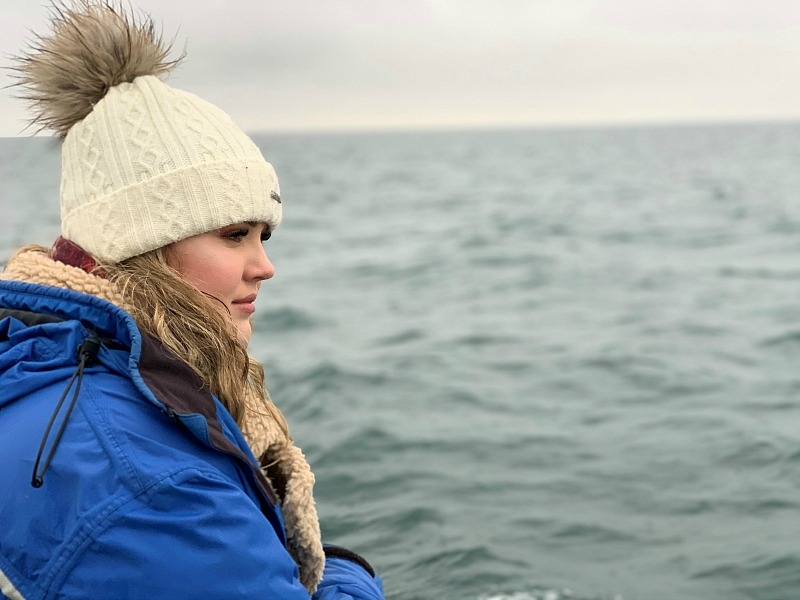
A woman stands on the deck of a ship, looking off at the water.
By Beth Deer
When I started at AMI, something I kept hearing about was "post guards." To begin with, I didn’t ask too many questions. I just thought it was a Canadian thing and I’d find out what it was at one point or another. Turns out "post guards" isn’t a Canadian thing and people were actually saying "Postcards." It all made sense. Postcards from Quebec, Postcards from the Yukon, Postcards from the Okanagan. These were all places you could possibly send postcards from. From this point onwards I was very excited about the thought of potentially hosting my own "Postcards."
Sure enough, Postcards from Vancouver Island was born. Hours of research go into documentaries like these. Research is not my strong point, but somehow I became much better at it when I was having to research such a beautiful place I knew I would visit. Now how many of you get to look up beautiful places in Canada and then actually get to visit them? Needless to say, I feel very lucky.
Before we knew it, we were meeting at the airport to fly to Nanaimo, B.C. Patronus was a lucky boy and got his own seat. Thank goodness, because there is no way I could’ve sat for more than an hour with 78 lbs squeezed between my feet.
Our homebase while on the island was a little town called Parksville. We arrived the first night, all pretty tired, but ready to eat. The food at our hotel was amazing. So amazing, in fact, I think I could tell you what I had to eat every night we ate there. Other amazing things about this hotel was it always smelled so nice because we had a Nespresso coffee maker in our rooms and one side of the hotel was right on the sea. Parksville is more of a retirement community, and less of tourism destination, so it was all surprisingly affordable.
Throughout our stay on the Island we visited a few different areas: Parksville, Qualicum Beach, Errington, Coombs, Victoria, Ucluelet and Tofino. Now I’m in dangerous territory because I want to say what we did but I don’t want to give it away…
Here’s a little sneak peak until the documentary premieres on AMI-tv: Patronus went for his first swim with me as his owner, I went back in history and learned about Victoria’s castle, I tried milk straight from a cow and I may have hugged a tree. I can’t say anymore—you’ll just have to watch Postcards from Vancouver Island when it debuts in 2020.
Grant Hardy previews Chasing the Spotlight: Dennis Joseph
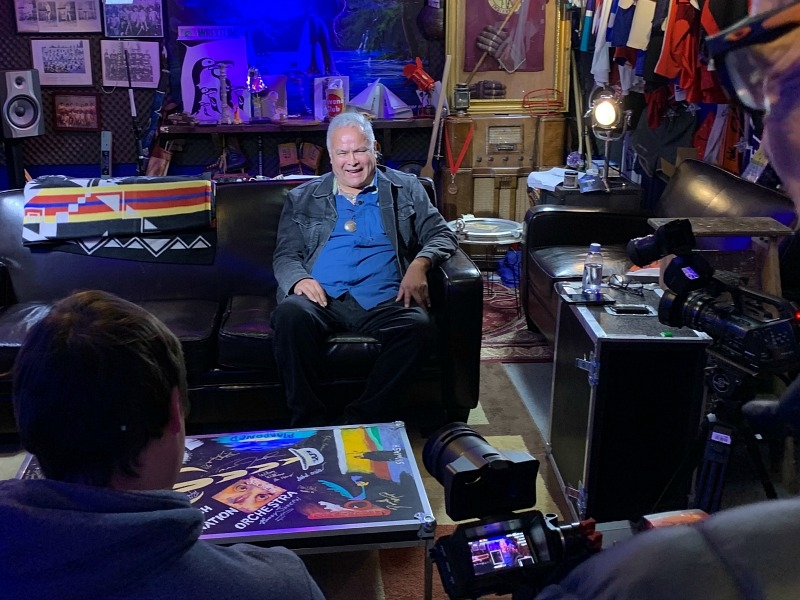
A man is filmed by a television crew. He is surrounded by instruments and lacrosse memorabilia.
By Grant Hardy
On February 21, check out Chasing the Spotlight to learn about some talented artists and performers with disabilities, and the barriers they face in accessing the spotlight. Until then, join us as we preview some of the key cast of characters you’ll meet.
Dennis Joseph is an engaging musician. Serving the Squamish Nation, he’s a respected elder who’s heavily involved in the community and plays the harmonica and vocals. We chatted in his man cave—a basement room full of musical and lacrosse memorabilia—about his life and his musical journey. The souvenirs in his man cave reflect much of Dennis’ enthusiasm for his music and community, as well as his interesting past. This includes playing at venues for the 2008 Summer Olympics and 2010 Winter Olympics with his band, Bitterly Divine, as well as for earthquake victims in China. Dennis described the happy memory of playing to excitable crowds who loved their music and mobbed the stage, trying to grab their clothes while they rocked out, making him feel like a Beatle or a Rolling Stone.
In 2017, Dennis’ life changed forever when he had a stroke, which was misdiagnosed as vertigo for two days. Music was a huge part of Dennis’ recovery. Though he initially couldn’t verbalize the traditional indigenous, rock, and blues songs he tried singing, he believes it helped keep his spirits bright and his brain thinking musically and creatively. By the fifth day in hospital, Dennis had his nephew bring his suitcase of harmonicas up to the hospital floor, where they arranged a mini concert in the cafeteria. Many of the patients attended, and the concert was a huge success.
These days, Dennis is treated as a respected elder, where he has the opportunity to share his music and teachings with the community. His latest project is an in-studio song which will be available digitally soon called "The Arrival." It’s a reminder to remember where you come from, do your homework and learn the history of the land you’re standing on. Listeners may relate the song to political happenings around them.
Dennis points out a few key barriers that can prevent him and other indigenous artists from accessing the spotlight. One is what I would term cultural appropriation, where members of the Indigenous community sometimes don’t have the opportunity to represent themselves, as they are played or portrayed by non-indigenous people. Another is simply the politics of being recognized as an artist in western Canada. A third is access to venues in a city like Vancouver, where space is finite. And institutionalized issues prevent First Nations’ artists from getting equitable access to funding.
Ultimately, it’s easy to see why Dennis is a respected member of the community. My interview with him lasted over an hour, but it didn’t feel nearly that long. He has tons of interesting stories to share, from the spiritual to the practical. You’ll enjoy meeting him on Chasing the Spotlight.
Chasing the Spotlight premieres Friday, February 21, at 8 p.m. Eastern on AMI-tv.
Grant meets wrestling instructor John Tee
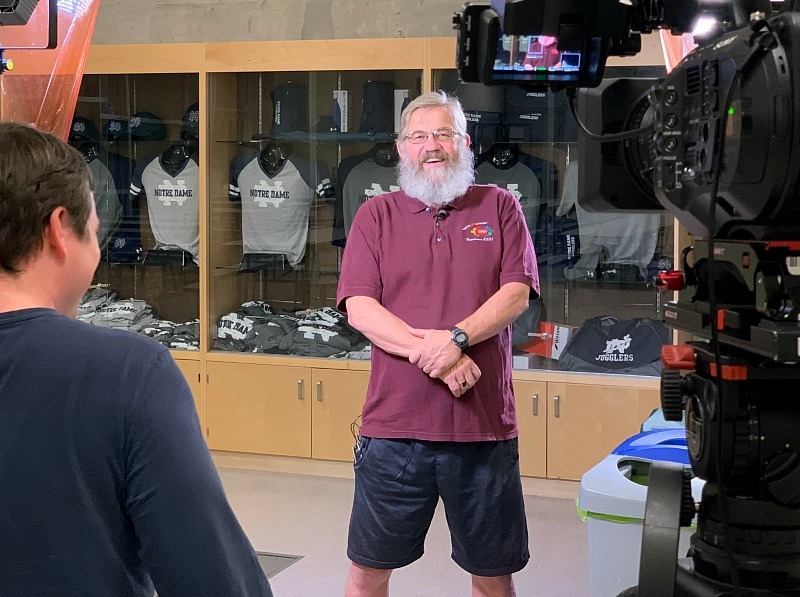
A man smiles into the camera. A case full of trophies is behind him.
By Grant Hardy
Late this fall, I met up with sports superfan, and old camp buddy, John Tee for some wrestling! It for an upcoming piece, and I’m really happy with how it turned out.
John, who is partially sighted, coaches mainstream high school kids at his old high school: Vancouver’s Notre Dame Regional Secondary School. He also coaches elementary school kids, and even has plans to get blind kids involved through a partnership with BC Blind Sports.
We showed up for some interviews with John, a couple of the teens he coaches, and one of the other coaches on the team. I’ve always respected John for being physically active and determined, but also modest and nonjudgmental. This makes him an ideal instructor for the Notre Dame Wrestling Program as coaching can be tailored to each teens’ goals, whether to be the next wrestling superstar, to become more fit for everyday life, or simply to gain confidence. I learned that at practice, John tends to work one-on-one with students while other coaches observe the group as a whole. John’s kinesthetic talent means that he’s very good at correcting the students’ techniques to make sure they’re doing the moves correctly and safely.
Through his team, I believe John is a great ambassador for the blind and partially sighted community. His positive attitude and the fact that he is able to do all the moves encourages the high school students to work harder themselves. It also increases their comfort around people with disabilities, as well as their knowledge and understanding about what people with disabilities can do. I believe this exposure is critical for young people, and am glad it’s part of the Notre Dame wrestling program.
All this aside, I got a wrestling lesson of my own. I can’t say I expect to become the next WWE champion anytime soon, though I did learn the half nelson—a maneuver for flipping your opponent onto their back and pinning them down. It was fun and an interesting lesson. Wrestling is definitely about more than just physical strength. It takes coordination and awareness about your partner as well as your own body.
In the end, I love AMI This Week stories that are fun, involve empowering portrayals of people with disabilities, and showcase grassroots activities happening in the community. This story checks off all of those boxes.
Watch the segment.
AMI This Week airs Mondays at 8 p.m. Eastern on AMI-tv. Watch full episodes and seasons of AMI This Week on demand at AMI.ca or on the AMI-tv App.
Frank’s Bakery
By Shelby Travers
When you walk up to 283 Greenbank Road, you don’t expect much. It’s a simple shop located in a strip mall on the West end of Ottawa. However, once you take a step through the door, your senses begin to do a dance and you know you’re somewhere special; you’re at Frank’s Bakery.
The smell of yeast, butter, and sugar makes all your taste buds come to life. The salivation begins once you notice the wall to your left where piles of various types of tarts from pecan, to chocolate sit ready to be consumed. Tarts aren’t the only delicious thing your tummy will grumble for though. Some of the best sandwiches, soups, and other sweet and buttery treats come from Frank’s Bakery, but, edibles aren’t the only thing that make this bakery special.
Watch the segment.
Cameras roll on Beth Deer's home renovation
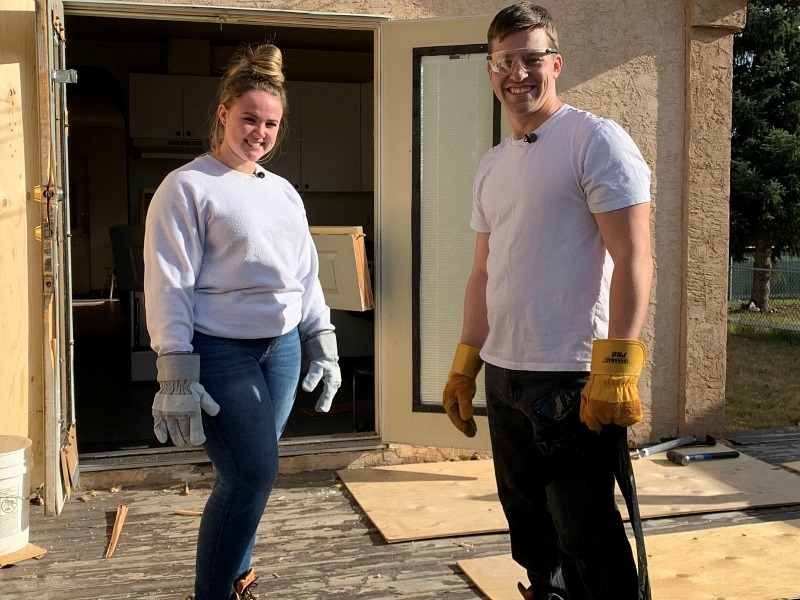
A man and woman smile into the camera.
By Beth Deer
The Edmonton bureau has recently started filming a special unlike any other they have done before. My boyfriend, Cody, and I bought a house and we are filming the renovation for an AMI special. I feel like such a grown-up.
I’m more than excited to become a home owner but the house we bought isn’t like most houses. It’s unloved beyond belief.
Once upon a time someone obviously really cared about the property and the land it was on, it’s just sad that the person who inherited it let it become a squatters paradise. There were multiple broken windows, garbage everywhere and lots of needles. Regardless of its downfalls/dark history, Cody and I are here to save the day and bring it back to life! Stinky couches, gross mattresses and moldy food ... everything came to 1060 kg at the dump.
The next day was our first demo day and it was satisfying. The smell in the house is terrible; it smells like someone barricaded themselves in and smoked cigarettes for 100 years. Getting rid of the some drywall and insulation is what that house called for. There is a lot more that needs to be done but we are on the right track.
Beth previews her guide dog command segment
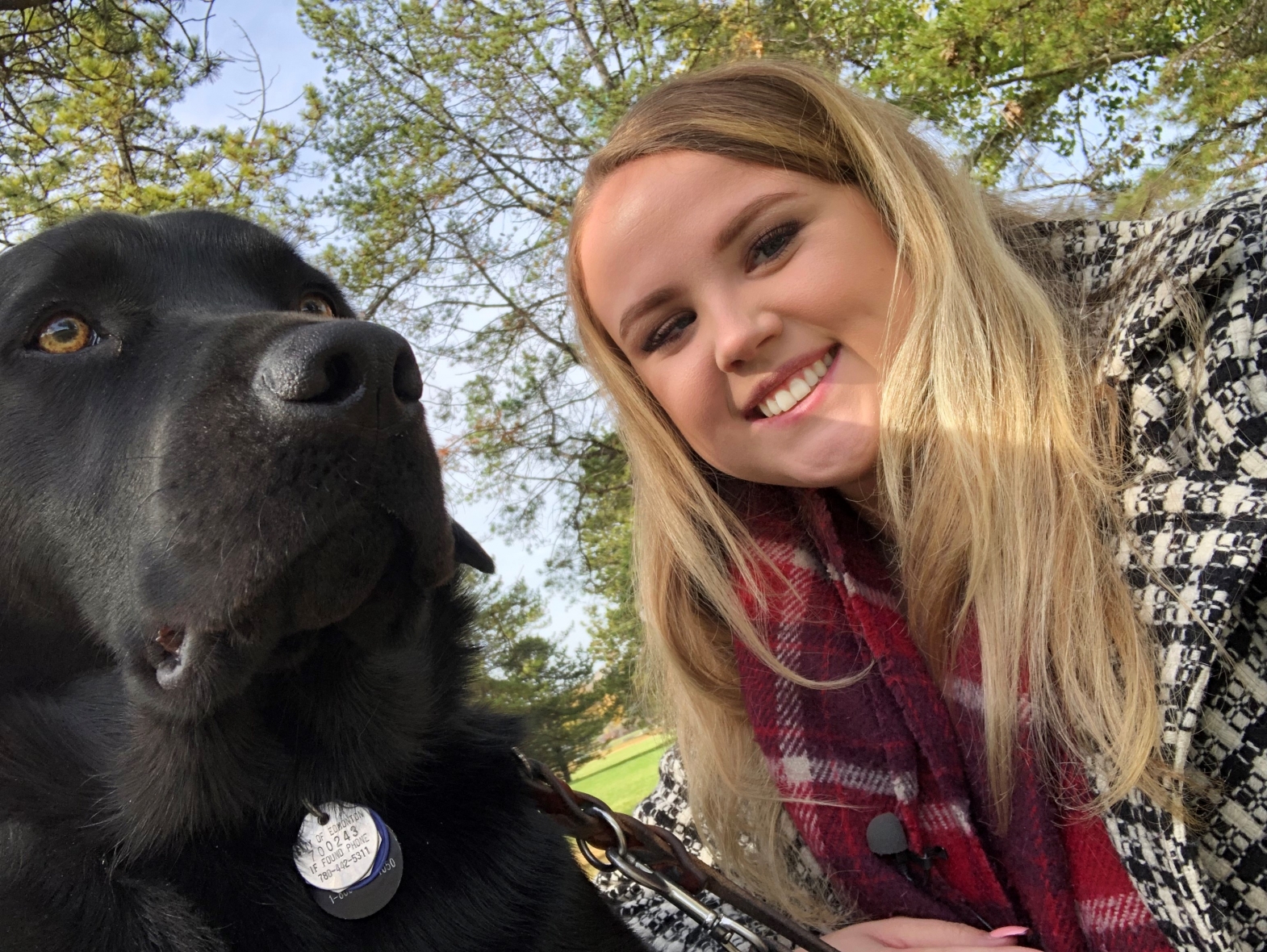
A woman and her guide dog.
By Beth Deer
Guide commands—I felt like it was necessary to write a script telling people how guide dogs work. Everyone knows that a guide dog helps blind people avoid obstacles, but no one knows the commands or the other amazing things they do.
Patronus was very excited about this shoot. He was allowed to lie on a picnic table in the park so he could be at the right height for the camera. As well as being a wonderful guide dog, his specialty is lying down. I also forced him to have a photo shoot which he is always thrilled about, it ended up being such a lovely day and I’m really excited for people to learn more about what guide dogs do.
Watch the segment.
AMI This Week airs Mondays at 8 p.m. Eastern on AMI-tv. Watch full episodes and seasons of AMI This Week on demand at AMI.ca or on the AMI-tv App.
Beth visits ReYu Paralysis Recovery Centre

A woman and child stand on a mat
By Beth Deer
This one is a tear jerker.
The Edmonton bureau had the pleasure of visiting the Reyu Paralysis Recovery Centre. This non-for-profit organization exists to promote recovery for people with spinal cord injuries and associated disorders. We met a lovely mother and son duo named Desiree and Rhys. Rhys is nearly three and has been visiting Reyu for a few months now. His trainer, Nancy, works really hard with him and sometimes uses something called a Therasuit.
The therasuit is a little suit that Nancy puts around Rhys’ legs and core which has bungee cords that are attached to act as muscles. Rhys is such a vivacious little guy and its very clear to me that he’s taken some amazing steps since starting at Reyu. I’m no therapist so the science behind what Reyu does goes straight over my head, but the love and compassion they have for their clients who they consider family doesn’t. What an inspirational organization!
Look for the segment in an upcoming episode of AMI This Week.
AMI This Week airs Mondays at 8 p.m. Eastern on AMI-tv. Watch full episodes and seasons of AMI This Week on demand at AMI.ca or on the AMI-tv App.
Vancouver Art Gallery Described Tour

A group of people stand around a bird statue
By Grant Hardy
On the last Saturday of each month, the Vancouver Art Gallery offers accessible, described art tours where blind and partially sighted patrons experience artwork through the description of a professional art educator. That’s exactly where I headed earlier this fall for a tour of two exhibits: Robert RAUSCHENBERG, 1965-1980, and Vikki Alexander: Extreme Beauty. The former exhibit was a collection of Rauschenberg’s works primarily dealing with 60s and 70s America, using layered, mixed media. The latter was a collage of mixed media on beauty and pop culture, that you literally walk into the centre of.
I’ve visited my fair share of galleries, museums, and other spaces for learning—and the great thing about them is that the guides want so much for you to learn something, enjoy your visit, and feel as if you benefited by visiting their space. But sometimes it’s hard to make the learning experience accessible to everybody.
I was very impressed at the lengths the Vancouver Art Gallery went to in order to accomplish just that. They partnered with VocalEye, and organization that describes live theatre, arts and culture, to train their art educators on providing the best description possible. The art educator who did our tour was enthusiastic, knowledgeable, and did a great job describing the artwork and addressing the audiences’ questions and critiques, both positive and critical. It was done thoughtfully and respectfully, and I think regardless of a person’s familiarity with the visual arts, you’re bound to get something out of these tours.
I’ve been blind since birth and am not very well-acquainted with visual arts. In fact, art classes and tours throughout schools were usually sources of frustration, as I often felt left out of the experience. That said, I thoroughly enjoyed this tour at the Vancouver Art Gallery and think it’s great that they’re doing these described tours. I would definitely go back, and would encourage anyone from the community in metro Vancouver to do the same. Meanwhile, from the comfort of your home, you can tune into AMI This Week to find out what our tour was like, learn more about the art and the techniques used to make it real, and meet some of the participants—and our tour guide—who made it such a blast.
Watch the segment.
AMI This Week airs Mondays at 8 p.m. Eastern on AMI-tv. Watch full episodes and seasons of AMI This Week on demand at AMI.ca or on the AMI-tv App.
Grant Hardy gives Blind Curling a whirl

A man sits on a curling sheet.
By Grant Hardy
It’s often called chess on ice—curling, that mysterious Scottish sport where players slide heavy, granite stones across a sheet of ice towards a circular target drawn on the ice called the house. Two teams of four players take turns serving these stones, with a director—called the skip—who requests a certain type of shot. Like the name implies, curling involves serving rocks using a curved motion, either slightly outwards or inwards, and sweepers use brooms to reduce friction on the ice and help the stone travel in a straighter line. You’re allowed to knock your opponents’ stones to send them off course, and the winning team is the one with the most stones closest to the centre of the house.
This fall for AMI This Week, I attended a meetup of the Vancouver Blind Curling League to learn more about the team, serve some stones of my own, and find out what makes curling special. I chatted with some of the players and worked with one of the coaches who adapts the game—and I discovered a few things.
First, curling is a very accessible sport with only minor adaptations needed. Depending on your level of vision, this could mean a guiding light placed near the target, or verbal guidance about how to line up your shot. In fact, it’s perfectly possible to compete in mainstream curling with the right accommodations.
Second, curling is a fun and social sport. Multiple teams can play on a single sheet of ice, so there are lots of people around. It’s said that curling tradition is for the winning team to buy the other team drinks at the end of a game. Either way, you can be sure there are lots of laughs and socializing throughout the game and afterwards. In fact, like many accessible sports, the league has a huge impact on many of the players’ lives.
And third, I’ve found my new favourite kind of footwear. They’re called grippers, which are rubber pieces that attach to the bottoms of your shoes. They make a night-and-day difference about how stable I felt on the ice, and I’m going to pick some up to wear on icy days this winter!
Despite my stability on the ice, there were one or two hiccups with my curling prowess, namely almost knocking over the AMI camera, and serving a stone so far off course that it landed on an adjacent sheet. But it was still a ton of fun, and with a little extra practice, and a dash of luck, I’m sure I could improve!
Check out Grant's blind curling segment.
AMI This Week airs Mondays at 8 p.m. Eastern on AMI-tv. Watch full episodes and seasons of AMI This Week on demand at AMI.ca or on the AMI-tv App.
Mina Nishigori and Burn365
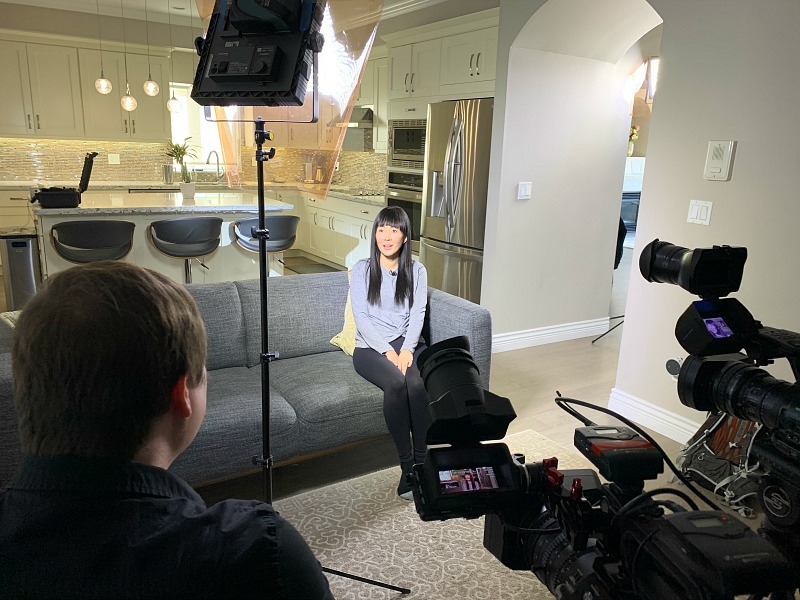
A woman sits on a couch, being filmed by TV cameras.
By Grant Hardy
One of my favourite types of stories on AMI This Week involves empowering portrayals of people with disabilities. I love hearing about people who are doing unique and interesting things, regardless of ability. And our profile on Mina Nishigori definitely fits that bill.
Local entrepreneur and mother Mina Nishigori graciously invited us into her home and her Richmond-based fitness studio for a glimpse into her life. She was born with sight, but has a genetic eye condition that resulted in the loss of her vision beginning in her twenties and exacerbated by the birth of her two daughters. In search for a fitness instructor that would accommodate Mina’s needs, Mina ultimately found a woman who would become both a supportive instructor and a business partner—bolstered by Mina and her husband’s entrepreneurial expertise with their family businesses.
The studio is great—offering fitness instruction for people with all types of disabilities as well as their partners and other interested people. I was impressed when the instructor we observed gave students activities they could work on at home, providing the opportunity for independent exercise outside of class.
I was touched and blown away with how open Mina and her family were with myself and our crew, and I hope their dedication and how much they’ve achieved comes through when you watch the story on AMI This Week.
Watch the segment.
AMI This Week airs Mondays at 8 p.m. Eastern on AMI-tv. Watch full episodes and seasons of AMI This Week on demand at AMI.ca or on the AMI-tv App.
Beth Deer meets Ben Perrin, Bitcoin Educator
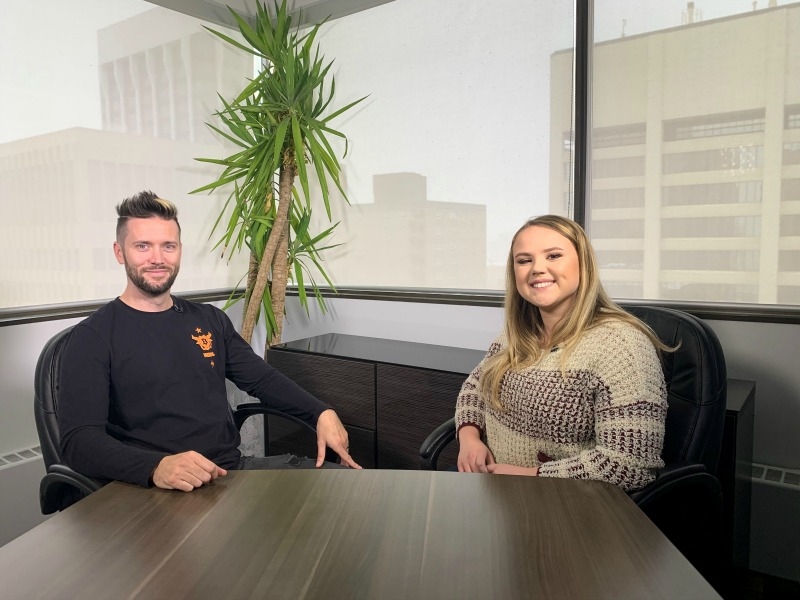
A man and a woman sit at a desk.
By Beth Deer
Our team left at nine in the morning for our shoot in Calgary. We realized when we reached the snowy roads halfway into our drive we had been living the good life in Edmonton, where there was no snow and it was above one degree Celcius.
We reached the Ford Tower at 12:30 p.m., where our shoot was planning to take place. I was positive that we had to go up to the 24th floor. There was no 24th floor.
Once we reached the 20th floor, we met with Ben Perrin. Ben works for Bull Bitcoin and also has a YouTube channel called BTC Sessions. I was in Calgary to chat with Ben and learn more about Bitcoin. It's safe to say I learned a lot about Bitcoin and its mind boggling concepts. He also told me the story of how he scammed a scammer, it was one heck of a story and he definitely taught those crooks a lesson.
As our day came to an end with Ben we still had a three-hour drive back to Edmonton, we decided to stop somewhere to grab food before we hit the open road. Hilarious. The place we decided to stop was probably the emptiest mall in North America. It had a now open sign but opened a year ago. I’m going to leave you with that.
Watch Beth's interview with Ben and learn more about Bitcoin in upcoming episodes of AMI This Week.
AMI This Week airs Mondays at 8 p.m. Eastern on AMI-tv. Watch full episodes and seasons of AMI This Week on demand at AMI.ca or on the AMI-tv App.
Shelby goes shopping using Instacart

A woman uses her cell phone.
By Shelby Travers
I have tried it all for groceries. I’ve asked for help, been independent and fumbled around with my cane or guide dog, gone with friends/family/volunteers, but I always left feeling the same way: stressed and overwhelmed.
Food isn’t really something that inspires me for cooking to begin with, so what feels like a chore to me also ended up just being a complete avoidance for me. But, how long can you really avoid food? Unfortunately, it’s a fundamental thing of living ... and frankly, I love to eat.
I’d previously found that click and collect services were the most beneficial for me to shop. But the price of having to take a taxi to and from started to add up.
I heard about Instacart–an online grocery delivery service–and then started to investigate what that experience was like. Now, that I’ve used it for a year I wanted to share how I have found my experience using the service.
Watch Shelby's review here.
Grant Hardy reviews iOS
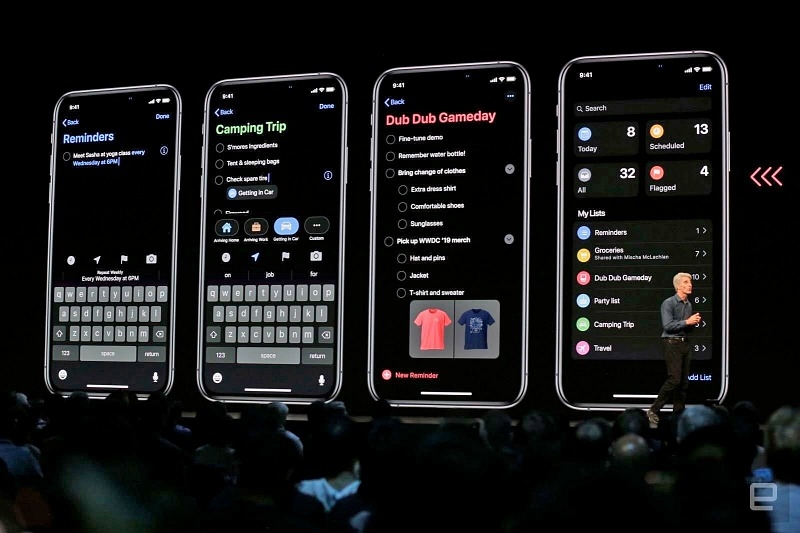
Four iPhones
By Grant Hardy
I’m a summer person, no doubt about that. So every year, fall hits me hard when I realize it’s an end to patio season, summer barbecues and fun in the sun.
But there’s a silver lining. For a tech guy like me, the fall is when some major software updates come out for the technology I rely on—among them, iOS and iPad OS, the software that powers our accessible iDevices. This year, the first big update dropped near the end of September, but it didn’t tell the whole story. Four updates have been released since then, expanding on the functionality of the initial release of iOS 13, and I’ve had time to play with the new features and discover which fit best into my life.
What follows is a brief overview of the things I’ve found to be the most useful as a totally blind iPhone user.
Over 100,000 radio stations available from Siri and the music app
I love radio—always have. And with Internet radio, one can listen to thousands of stations from all around the world. iOS 13 brings native support for radio stations from iHeart Radio and the TuneIn Radio directories, and you can ask Siri to play the station of your choice or search for it in the Music app. No more third-party apps required. And yes, AMI-Audio is available.
Shortcuts
The Shortcuts app, something which has been around since last year, has become my favourite feature on iOS. It lets you create multi-step tasks to quickly get information and get things done across your apps. It’s as cool as writing your own little app—except you don’t need any programming experience. Its drag-and-drop interface is as simple as putting together building blocks.
For example, a typical “morning routine” shortcut might look like this:
• Greet you.
• Read out your calendar events for the day.
• Get the ETA from your current location to where you need to be, and read it to you.
• If you’ll be on time, bring up transit directions in your favourite transit app.
• If you’re going to be late, offer to call a cab and text someone your ETA.
A morning routine has almost become a cliché example since there’s a ton more you can do with this app, with hundreds of actions across Apple’s apps and third-party apps. This year, Shortcuts gets some big updates, including one that I think will greatly benefit the blind and partially-sighted community.
In addition to the other ways you can launch Shortcuts (like by asking Siri or tapping an icon on the home screen), you can be offered up shortcuts based on conditions like time of day, before you’re predicted to commute, when you connect Bluetooth headphones to your phone, and when you shut off your alarm. You can also tap small tags called NFC tags against some of the latest iPhones to run shortcuts automatically. I’ve already set up prompts that pop up offering real time transit directions to work before my daily commute, which means they’re available without having to dig through menus and find them. But other options abound. For example, imagine attaching a tag to each one of your pill containers. When you tap your phone against one of those tags, it could pop up details about your medication to confirm you’ve picked up the right one, then make a note recording when you took your medication. The same applies to food containers and clothing for which you want an accessible label. There are lots of cool ideas.
Covering how to use the Shortcuts app is a bit beyond the scope of this article, but there are lots of great resources available. For example, check out the MacStories website and blog for many thorough guides on building shortcuts.
Maps: Real-time transit
Apple Maps now offers real-time reports for transit departures rather than relying on bus schedules. In my experience around metro Vancouver, these are extremely accurate—often down to the minute. I was also very impressed that when I reported an accessibility issue where bus stops weren’t including the side of the street where you needed to board, Apple fixed my issue and sent a response confirming that it was addressed.
VoiceOver: Making Photos More Accessible
If you’re blind or partially sighted, you know it’s just as important for you to have a collection of photos as it is for anyone else. Friends and colleagues love to see them, and with the right organization and captioning, they can bring back memories for everyone.
This year, if you’ve trained your Photos app to recognize specific faces, VoiceOver can announce the names of those people when navigating through photos, or even when taking pictures. It’s a brilliant addition that should help when sorting and sharing photos. VoiceOver can also give you additional guidance when lining up to take a photo. As well as announcing the number of faces in the frame, it can guide you if the camera needs to be tilted to get a better shot.
VoiceOver: Change what the touch screen gestures do
If you’re a VoiceOver user, you may have always wanted to customize what the various taps, swipes, and double-taps do when you use the touch screen. Now you can, by heading into Settings, Accessibility, VoiceOver, and choosing the Commands section.
There are some interesting possibilities, and I’m sure people will come out with lots of brilliant new command layouts. For now, I’ve done the following to customize how my phone works with VoiceOver:
• A two-finger swipe left and right moves between headings.
• A four-finger swipe up and down moves through controls on the web, like text boxes and buttons.
• A four-finger double-tap pastes text from the clipboard at my current location.
Conclusion
iOS 13 and later brings lots of worthwhile enhancements to your phone—many more than I can cover here. If your device supports it, it’s worth grabbing the update from Settings, General, Software Update when you have some time to play around.
Ringette for All
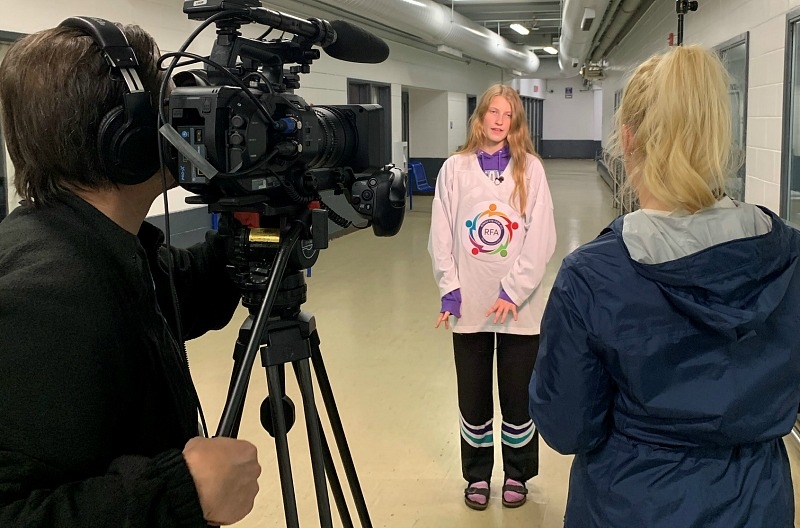
A girl stands in a hallway. A television camera is pointed at her.
By Shelby Travers
It’s always a pleasure to be able to meet people doing amazing things when filming for AMI This Week. The people from Ringette for All were no different!
Meeting a mother-daughter duo that were so inspired to share their love for ringette that they made an organization that opened the sport up to anyone–no matter age, disability, race or gender! This is something not often found.
I love athletics and being able to participate in sports. But after becoming disabled, I struggled with only being allowed to be involved in “blind sports.” I found myself feeling that by being included, I was also being segregated. It meant that my only friends were a part of the blind community. Don’t get me wrong, I love my blind friends, but I love being surrounded by a diverse group of people.
I am hoping one day more sports will open their door to everyone and we can all use Ringette for All as an example!
Watch Shelby's segment of Ringette for All.
All Hail Ride Hailing: Grant’s thoughts on third-party ride hailing companies coming to B.C.

A woman using Aira
By Grant Hardy
On a recent vacation to Seattle, I marveled at the ease and efficiency of navigating the city through ride hailing services. Service was prompt and friendly, and we could travel individually or as a pool with other customers. Prices were dirt cheap, too. Really, it just made sense.
Of course, this was with my tourist hat on. There’s no doubt that experiencing ride hailing during a personal vacation is much different than taking it regularly. And there are genuine issues to be worked out, such as making sure drivers are paid appropriately, meeting the needs of passengers with special needs, and balancing available cars with traffic congestion in cities. I know ride hailing is definitely not perfect, and I can understand there may be legitimate concerns. However, as a blind traveler, I’d like to talk about the one thing that makes me the most excited about getting access to ride hailing—something which I seldom see mentioned in any debates about it.
When you book a ride through a ride hailing company, you’re generally paired with a specific driver and the entire journey is tracked, including the route your driver takes. In fact, Aira—the service where trained agents describe the environment around you using your phone’s camera—has partnered with Uber and Lyft. Aira agents can access your booking details to help direct you to your pickup spot, and ensure you can locate your car.
This is a far cry from calling a cab, where often times my name isn’t even asked for unless I volunteer it, which I usually do if it’s a busy area or time of day. By the time I get a call or text saying my taxi is on the way, it’s usually minutes or even seconds from me. By the time I get outside and start walking towards where I think my cab may be waiting, perhaps two minutes later, the cab has often left with somebody else. This is perfectly possible because again, myself and that cab are not paired in the same way as with ride hailing services. I find there’s little point in complaining to the dispatchers—since realistically, there’s nothing they can do. But I have to think that there’s a better, more efficient way.
That’s why I’m hoping to give ride hailing a chance. I understand policy makers are being cautious in British Columbia, such as requiring that drivers carry a commercial license. But I hope they won’t water down ride hailing regulations too much. It’s not perfect, but it deserves a chance.
AMI This Week airs Mondays at 8 p.m. Eastern on AMI-tv. Watch full episodes and seasons of AMI This Week on demand at AMI.ca or on the AMI-tv App.
The Creation of Tell Tails
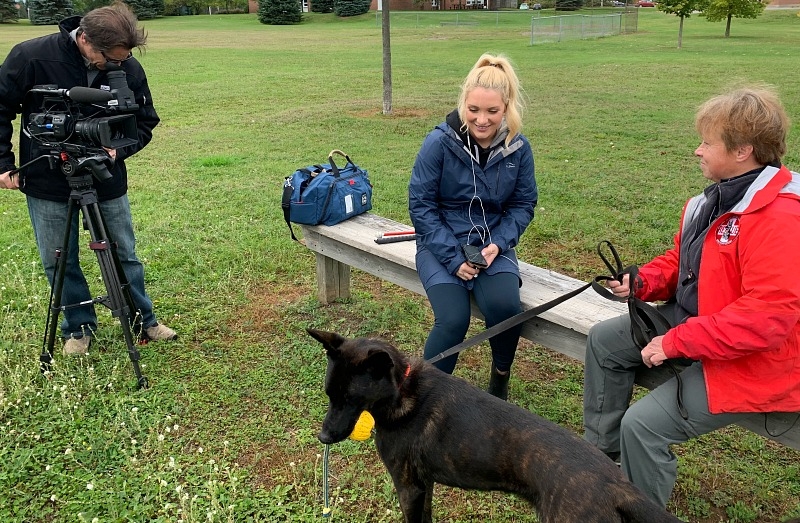
Two people sit, with a guide dog in the foreground.
By Shelby Travers
I always say that being a guide dog handler is one of the most amazing things I’ve ever experienced. It truly is the best part about being blind, in my opinion. Not only can I always have my sidekick with me, but I can experience a bond that is so unique. I’ve always grown up with dogs; I even got my first dog when I was only 10 years old. But when I got Frances, it didn’t take a long time to understand the bond is extremely different from a pet.
I have expectations of Frances. I rely on her. It’s not just a sentimentality when I say, “I need her.” It’s a raw and vulnerable testament of my dependence of her and the independence she truly gifts me.
With knowing firsthand what this bond is, I was curious to learn about other working dogs and the relationship the handler has with them. This is when the idea for Tell Tails came up. With a play on telling tales, it will take a deep dive into these unique bonds of handler and working dog to learn the similarities and differences from one working dog to the next.
Tell Tails will be a recurring segment on AMI This Week soon.
AMI This Week airs Mondays at 8 p.m. Eastern on AMI-tv. Watch full episodes and seasons of AMI This Week on demand at AMI.ca or on the AMI-tv App.
My Pole Journey

Four women in workout attire hold up certificates, smiling. A guide dog relaxes on the floor.
By Shelby Travers
Anyone who meets me knows how much I love to try new things, especially when that new thing involves physical activity in some sort of way. Not only do I just generally love physical activity, but I’ve struggled with my weight and body confidence. So, for the past year, I’ve started to do my research on pole fitness, thinking it would give me everything I’ve been looking for.
So, just over a month ago I signed up for my first “Intro to Pole” series at Iron X Fitness and I was in love from the very beginning.
You may be wondering, “what is pole fitness?” Well, it’s essentially pole dancing. With that title, comes a lot of—unnecessary—stigma. But, maybe that’s why I fell in love with it … along with many other reasons. We all know how much I love to break stigmas.
Pole is one of the most blind-friendly exercises I have ever tried simply because it is so tactile. You are generally always in contact with the pole, so you always have a point of reference for where you are. Then, the rest of it is just movement, and knowing how to position your body and transition in your choreography.
It is also a wonderful space that encourages body positivity, loving yourself, owning your sexuality, and giving you an amazing workout! Trust me, my arms, core, back, and glutes are always sore for about two days after—in the most wonderful way, of course.
AMI This Week airs Mondays at 8 p.m. Eastern on AMI-tv. Watch full episodes and seasons of AMI This Week on demand at AMI.ca or on the AMI-tv App.
Where I’ve been...
A woman and three men stand, wearing skiing outfits.
By Shelby Travers
Over the past few months, you may have noticed a little less Shelby and a little less Frances appearing on AMI. That’s because since March 2019, I have been on medical leave due to a concussion.
If you’ve seen the story, we did on the Ottawa Ski Hawks before, you know just how much I love skiing. However, taking part in the sport shouldn’t be taken lightly. It has risks for everyone, and when your blind, the chances of an accident are even higher. Even with one caller guide and one blocker guide, accidents can happen. And one did.
I was headed down the hill for one of my last runs of the night. I knew I was approaching the lift line-up, so as usual, I did a quick hard “hockey-style” stop. Only this time, there was a big thud and the next thing I knew I was on the ground. From here, it goes foggy.
I recall crying. Even though my leg, hip, and head hurt, the tears mostly came from shock. I have never gotten into a collision before – let alone with another person, which I later found out was what I hit. I recall my guides helping me stand and bringing me to the lodge but past that, I don’t remember the night.
The next morning, I woke up with a headache, nauseous and after calling my parents, we decided that it was the best decision for me to call 911. At the hospital, I was once again diagnosed with a concussion. The fourth concussion I have gotten in my lifetime. Add that onto my pre-existing brain injury, and I knew the recovery would take a long time.
I’m still on the mend, and as I have learned from all my encounters during the filming of My 10-Year-Old Brain, I know that not everything will be back to how it used to be. Everything from fatigue, to word-finding, to light sensitivity can have an impact on the day-to-day for me.
Thankfully, this is not my first rodeo, so I know I need to be gentle on myself during this long recovery process. But, as I now transition back into my regular workflow with life, and at AMI, I am looking forward to what’s next.
And of course, I will still be back on my skis once the snow hits.
AMI This Week airs Mondays at 8 p.m. Eastern on AMI-tv. Watch full episodes and seasons of AMI This Week on demand at AMI.ca or on the AMI-tv App.
Maple Smoked Pork Tenderloin and Beans Recipe
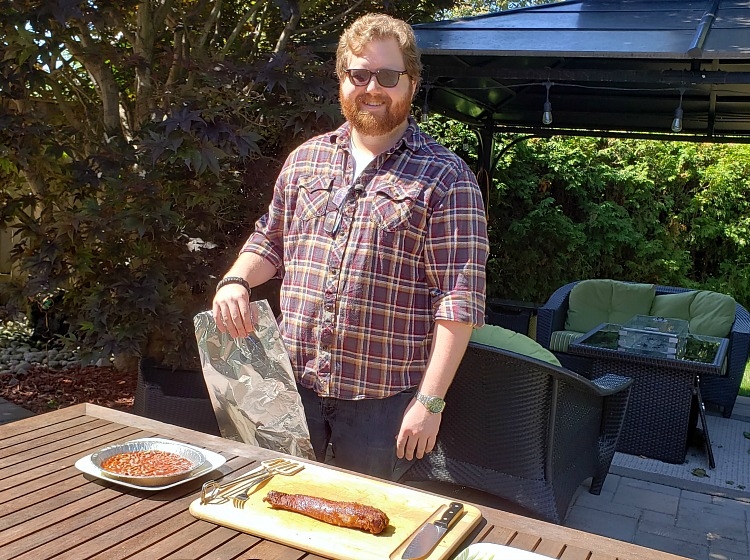
A man stands in front of a table. A smoked pork tenderloin sits on a cutting board.
By Alex Smyth
In the coming weeks, Alex Smyth shows you how to make a mouthwatering smoked pork tenderloin. We were so excited, we're sharing the recipe now. Stay tuned for cooking segment on AMI This Week.
Maple Smoked Pork Tenderloin and Beans
Ingredients
1 pork tenderloin
½ cup maple syrup
1 tablespoon chopped garlic
2 tablespoon Dijon mustard
1 tablespoon olive oil
Salt and Pepper to season
1 can baked beans
Directions
1. In a mixing bowl, combine maple syrup, Dijon mustard, chopped garlic and olive oil, along with the salt and pepper, to make the marinade.
2. Place the pork tenderloin in a resealable plastic bag and add the marinade.
3. Place the marinating pork in the fridge for at least four hours, overnight if possible.
4. Prep the smoker by setting the temperature at 225 degrees Fahrenheit and setting the timer for three hours.
5. Place the pork tenderloin in the smoker and let smoke for three hours, or until the internal temperature reaches 160 degrees Fahrenheit.
6. After two hours of smoking the pork, open the can of baked beans, pour into a tin foil cake tray and place in the smoker.
7. After three hours, or the pork reaches 160 degrees Fahrenheit, take out the beans and pork, wrapping the meat in foil for 5-10 minutes to seal the juices in.
8. Slice up the pork and serve!
AMI This Week airs Mondays at 8 p.m. Eastern on AMI-tv. Watch full episodes and seasons of AMI This Week on demand at AMI.ca or on the AMI-tv App.
Blonde hair, do care

A woman stands against a wall, running her hand through her blonde hair.
By Shelby Travers
The things no one talks about as a non-natural blonde…
The saying goes “Blondes have more fun.” So, after trying every hair colour known to humankind I figured that as of January 2019 I was ready to fully plunge into full platinum blonde territory.
Before doing so, I did my research. I knew it would take stages to get to the level of lightness I wanted. I spent days scrolling through Google and Instagram to find the right hair stylist. But none of that time spent prepared me for the true commitment being a non-natural blonde.
For example, I now spend around three hours every five weeks sitting in a salon chair as my stylist strategically bleaches grown-in roots section by section. Every five weeks probably seems crazy, right? Well, this is the only way in keeping a streamline colour and not getting banding. Banding is when you have a band around your head of a different colour which is caused due to hair closest to your head lightening faster than the rest of your hair because of heat.
You also have to think about what you’re putting your hair into and how the tones could change. Sun exposure? That blonde could turn brassy and yellow. Swimming in a chlorine pool? You might get the greeny blues. Dunking your locks in a lake with clay grounds? Peach may be headed your way.
So, you could say that blondes have more fun but for us “bleach blondes,” we work for the fun.
Happy Franniversary!
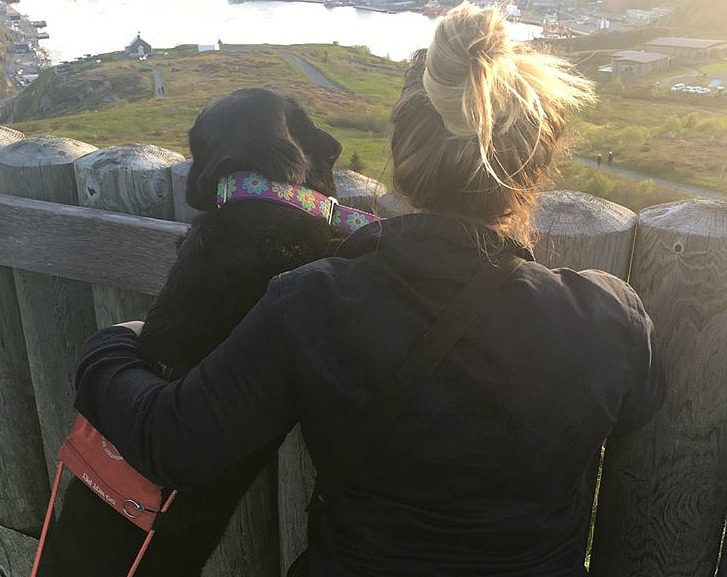
A woman and her guide dog look off into the distance
By Shelby Travers
As many of you know, I have a guide dog named Frances. She’s a black Labrador retriever, weighing in at 62 pounds and born on January 14th, 2013. September 8th, 2019 marks my five-year Franniversary.
I will never forget the day that Frances came into my life. All guide dog owners know the anxiety of sitting in your room at the training facility as you await meeting your new guide dog. You hear the trainers walk through the hallways with dogs full of excitement. You hear them walk past your room and the tension builds until finally…*knock knock*. “Shelby, we have someone we want you to meet” and the trainer walks in with an overly-excited dog.
The trainer Lucy said, “Now, we know you wanted a male dog, but this is Frances and she is a black lab.” I didn’t need her to say any more. I was in love and I knew my life had instantly changed. Frances isn’t the most “traditional” dog name, but it does happen to be my middle name. So, you could say when I heard this happy little girls’ name, I knew it was meant to be.
I won’t lie and say that these past five years have all been easy. They haven’t been. Frances and I have had hard times. She has failed me, and I have failed her. I have had moments of tears and doubt and I know she has too. I have had to understand her needs, and she has had to evaluate mine. But even though we have experienced the hard times, she has changed my life for the better.
I reflect every year since she has come into my life on the things I have done. I’ve moved across the country twice on my own. I have gotten my heart broken more than once. I have graduated from college. I have built my career. I have lost my pet dog Track. And through it all, she was there for me and I was there for her. It’s an amazing bond that a handler shares with a guide dog built with trust, love, and understanding.
As the time goes on, it is a bittersweet feeling. I know that I am now in the latter half of my working years with Frances, and it’s terrifying. I wish that in 10 years from now we will be celebrating our 15-year Franniversary. But I know that won’t be the case.
So, for now, I will build her a banana and bone cake (her favourite), let her lick my face (even though I hate it), squeeze her tight (even though she hates it) and say, "thank You for changing my life."
AMI This Week airs Mondays at 8 p.m. Eastern on AMI-tv. Watch full episodes and seasons of AMI This Week on demand at AMI.ca or on the AMI-tv App.
Interactive Fiction

A person plays a video game.
By Grant Hardy
If you’re blind or partially sighted, you know that you have a much narrower selection of accessible games than the mainstream market provides. An under-hyped type of computer game that happens to be accessible is called interactive fiction, also known as text adventure games. If you’ve ever read an adventure book where you’re told to flip to a certain page depending on what choice you make, then you’ll find interactive fiction to be very similar. You use text-based commands to move around from room to room, talk to—and interact with—characters, solve puzzles, and (hopefully) get through the story. And just like with books, every genre imaginable is available—from science fiction to crime-fighting to comedy.
These games have been around since the beginning of mainstream computers, but modern apps and websites open them up to everyone. In these text-based games, you’re a character in a story and the progression of the story is influenced by your actions.
One easy way to get started is to download a compatible gaming app for your device. For example, on an iPhone, the Frotz app comes with many free games and you can always add more. The annual Interactive Fiction Competition is another great resource for downloading free, text-based stories that can be played in apps like Frotz or online.
Everyone’s game preferences will be different, and there’s no point just playing the top reviewed games since you’re bound to find a personal favourite. Personally, I loved playing Gourmet, a comedy by Chad Barb and Aaron Reed where you’re the owner of a restaurant anticipating a visit from a famous restaurant critic, on a night where everything seems to be going comedically wrong. Another favourite is The Edifice by Lucian Smith, a game that takes you back to prehistoric times and presents three puzzles related to human evolution, including a really interesting language puzzle.
Whatever length, storyline or genre you prefer, you’re bound to stumble upon a game that keeps you playing until the very end.
AMI This Week airs Mondays at 8 p.m. Eastern on AMI-tv. Watch full episodes and seasons of AMI This Week on demand at AMI.ca or on the AMI-tv App.
Introducing Beth Deer, Part 2

A woman smiles into the camera. A guide dog is sitting in front of her.
By Beth Deer
My mind was racing. We were going to England for three weeks and returning with exactly two weeks to find a place that was pet friendly. We had to sell a lot of our junk in Lethbridge as I knew moving to a bigger city we were going to have to downsize massively. We still needed to pack our entire house. On top of that, my first day was on June 3 in Toronto. We would be moving into a new place on June 1. I started packing up rooms and rarely used items in my house that evening. I made a few phone calls to rental properties while sitting at the airport the next day. No luck.
We arrived back from the UK on May 17th and drove straight to Lethbridge, picking up our pet dog and cat on the way. Patronus had come to England and the poor guy was suffering a little from doggy jet lag. Seriously, it’s a thing. We took that evening to unwind and make a packing up the house plan.
We had officially arrived in Edmonton around noon and signed our lease. We were waiting for some family and friends to arrive to help us unload. I thought it would be a good idea to grab the first couple of things that we had crammed in the back of the truck in Lethbridge. We did this and placed most of it on the grass in front of our house. My boyfriend was moving his car and I was inside when some guy walked up the path to the house. “Excuse me, some lady just let her dog pee all over your stuff.” We hadn’t even been here 15 minutes. Welcome to Edmonton! Don’t worry though, it’s been all uphill from then on. But talk about a welcome gift from the neighbours.
That weekend flew by and before I knew it I was sat at a restaurant in the Edmonton airport awaiting my flight to Toronto. And of course, my flight was delayed by two hours. I would usually be frustrated by that but it was nice. It was the first two hours I’d had to collect my thoughts in what seemed like two months.
The next day I got a taxi from my hotel to the AMI office in Toronto. It was so refreshing meeting everyone in person after emailing back and forth since finding out I got the job. I had a packed schedule for the week with a lot of fun but useful stuff planned and I couldn’t wait. Integrated Described Video training, meetings with different people, learning my job and lots of really interesting things.
After a fun but exhausting week I arrived back to Edmonton late Friday night. The Edmonton team were in the middle of filming a documentary with Mary Mammoliti. I went to one of their shoots Sunday and another that week too but you’ll have to check out My Taste of the Prairies blog post to hear about that.
All in all, I have been loving my time with AMI. I never knew there was so much that went on behind the scenes of, well I guess, a scene. If you catch my drift. I’ve been learning a lot about production, script writing but most of all myself. My entire life I have had no clue of what interested me for a career. That was until my dream job came along without me even knowing it. I’ve always known I wanted to reach out, speak to and connect with people. I now get to do all of those things in a community that I love. How lucky AMI?!
Watch Beth on AMI This Week, Mondays at 8 p.m. Eastern on AMI-tv. Watch full episodes and seasons of AMI This Week on demand at AMI.ca or on the AMI-tv App.
Introducing Beth Deer, Part 1
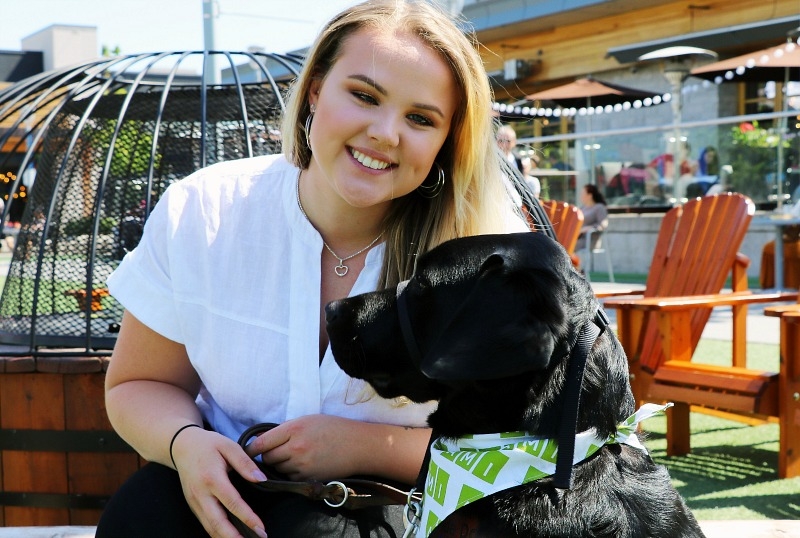
A woman smiles into the camera. A guide dog is sitting in front of her.
By Beth Deer
Hi! I’m Beth Deer, the new Bureau Reporter for AMI’s Edmonton team. You will be seeing me soon on AMI This Week. Now that I have introduced myself, let me tell you a little bit about me.
I am 21, 5-foot-2, with dark blue eyes, an English accent and I have the cutest black Labrador for a guide dog named Patronus. If you’re listening to this with a screen reader, it’s pronounced “pah-trone-us.” Harry Potter fans will know. It also means "protector" in Latin. I moved to Canada in March of 2017 to live with my boyfriend. We had met the summer before in Mexico as we were both on family holidays. I was there with my mum, dad and younger sister, Molly.
My family comes from a small town in England called Crowborough. Barely anyone in England has heard of Crowborough, but nearly everyone has heard of Sherlock Holmes, Sir Arthur Conan Doyle and my favourite, Winnie the Pooh. I grew up in the town where the writer of Sherlock Holmes lived and is Winnie the Pooh’s home, 100 Acre Woods. This is a real place called Ashdown Forest. Or as I call it, home.
If you hadn’t already guessed from me having a guide dog, I’m blind. I have always been visually impaired, but I lost my sight after a surgery at the age of 15. It’s still undetermined as to whether it was the surgery that caused it or if this would have happened to me anyway. Not much is known about the several conditions I have when they are combined. I like to think it would have happened anyway, so I try not to blame anyone. I’m a big believer in this happened to me because I’m strong enough to deal with it. Six months after losing my sight, I ended up going to a specialist school for the blind. This meant moving away from my family and friends. As much as it was hard, it was the best thing I could have done for my sight loss. I was surrounded with people who understood and didn’t make me feel different. We like to call it “The Braille Jail.” It wasn’t a jail; it was just a school for blind kids but that always makes me laugh. Circumstances are made a lot harder if you can’t add humour to them.
Fast forward three years, and at 18 years old I moved to Canada. Lethbridge, Alberta, to be exact. We lived there for just over two years. During those years I was unable to work since I was on a visitor visa. I had to apply for permanent residency (PR) and wait for it to be approved. I was in Canada for 23 months and five days before I finally had the same rights as a Canadian, except for voting. So, when I got my PR on March 5th, 2019, I went straight to the CNIB’s website. I wanted to find information on what blind people were entitled to in Canada. There, I came across an Employment Skills Bootcamp they were going to be running at the end of March in Calgary. I jumped at the chance and signed up.
Before I knew it, Patronus and I were off to Calgary on the Red Arrow coach. I was not too sure what to expect but was excited to meet some new people. That night, we were picked up from the bus station and settled into our hotel rooms. The next day, we met everyone and had a chat about what the week ahead would have to offer. Everyone kept talking about a TV channel called AMI. They filmed some of our sessions as well as an evening event where we all went bowling. Some of the participants and staff at the CNIB did interviews with AMI. After my interview, I ended up chatting with Rebecca who is one of the producers at AMI. She told me about a job posting for a new Bureau Reporter they had going at the Edmonton office. Even though I lived in Lethbridge (a five-hour drive from Edmonton) she said I should think about applying. So that was that — I applied before I left the bootcamp in Calgary. CNIB helped me put my resumé together as I had only ever had an English one from back home. They are done very differently, which was surprising to me.
I heard from AMI’s human resources team later that day and started the interview process the next week. I was so excited because when I had applied for my PR I didn’t even think I would have it by this time let alone be applying for a job. I had my interview within a week or two of the conversation I had with Rebecca. I felt like it went well, but I was eager to find out more as I was leaving for England to see my family at the end of April. Thankfully, I heard from AMI the day before my trip telling me I had the job! Woohoo! I was so excited. We agreed that I would start at the beginning of June.
I found my boyfriend and told him we would be moving to Edmonton. About an hour later we were outside on our deck having a celebratory drink. I looked at him and said, “What have I done?”
AMI This Week airs Mondays at 8 p.m. Eastern on AMI-tv. Watch full episodes and seasons of AMI This Week on demand at AMI.ca or on the AMI-tv App.
Grant’s Postcards from the Okanagan
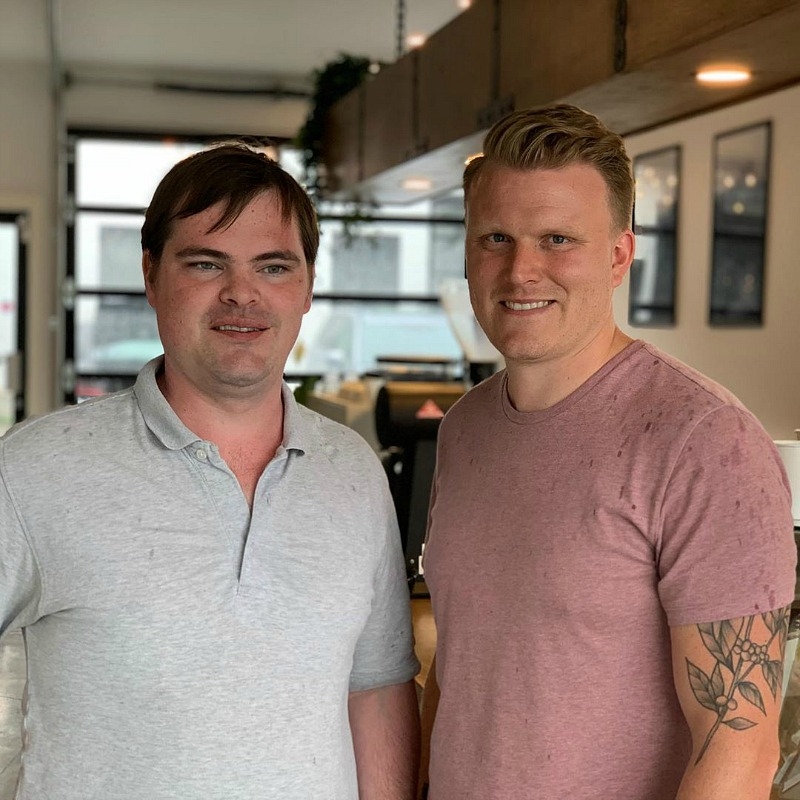
Two men stand next to one another, smiling.
By Grant Hardy
AMI’s Postcards specials are unique and interesting depictions of a region—whether it be Newfoundland, Quebec or the Yukon. While it’s an ongoing series, I haven’t had the opportunity to work on one since joining the Vancouver team full-time. So when I had the chance to travel to the Okanagan to host a one-hour Postcards special with Marco Pasqua, I was excited.
The Okanagan, located in B.C.’s interior, holds many great memories for me as I’ve visited there for pleasure. It’s also a highly unique place to travel to, known for friendly people, good local fruits and wines, and plenty to do. And there’s no better travel companion and co-host than accessibility advocate Marco Pasqua, whose openness and enthusiasm was contagious.
Postcards from the Okanagan debuts Friday, August 23, at 7 p.m. Eastern on AMI-tv, but if you can’t wait to learn why you should book your own trip to the Okanagan ASAP, stay tuned for some highlights below.
Our schedule, and hence our special, was jam-packed with interesting activities. Our first morning was spent riding a duet bike on the Myra Canyon Trail, a decommissioned railroad turned into a hiking and biking trail complete with tunnels and trestle railroad bridges. The object was to learn about People In Motion, an organization that, among other things, provides adaptive recreational opportunities for people in the disability community. Said duet bike has a similar concept to a tandem bike, except that only one person pedals and steers. In our case, Marco sat up front and gave me turn-by-turn directions while I provided the pedaling and steering power. Despite some initial bumpiness getting going, it was an exhilarating experience. I love biking and don’t get the opportunity to do it often, especially being actively involved in the steering and breaking. The trail itself was neat—I’m told the view was beautiful, but the trestles and tunnels were also interesting acoustically. I’m also impressed with People In Motion and the opportunities they provide. The stability of the duet bike makes it feasible for biking newbies or those with balancing issues. And the fact that individuals who can’t pedal can still enjoy the experience of riding a bike is spectacular.
Diving in the opposite direction entirely, another highlight was Frequency Winery in Kelowna, which combines wine with music. Their facility offers a free studio complete with drum kit and mixing board, where artists can jam and record music, podcasts and shows. The studio is filled with bottles of wine, and in return for getting free access to the studio, it is said that the vibrations from the audio enrich the wines with good vibes. For example, a certain variety of wine is only infused with the sounds of love songs. I can’t say I played any of those. But I will say I rocked out on the drum kit, while Marco jammed along with a musical synthesizer app. We had a blast, learned a lot, and who knows—maybe Marco and I left our musical mark on the wine.
The Kangaroo Creek Farm is another unique destination we visited. Located in Lake Country, I first learned about the farm last summer on vacation, and was happy to return there to share the story with our audience. It’s not a zoo; animals on the farm don’t perform tricks for guests, and aren’t caged. However, there is opportunity for guests to interact with animals on everyone’s terms. Animals included kangaroos, wallabies, birds, capybaras (a kind of large rodent) and more. The owners’ passion for the animals was great. I was also impressed with their efforts to make the farm accessible. For example, they are willing to arrange an encounter between a blind/partially sighted guest and a baby kangaroo whereby you get to hold the joey as I did. This was an incredible experience that is hard to describe.
Lots of other highlights stand out. We learned about the mysterious Ogopogo—a mythical lake monster that’s said to inhabit Okanagan Lake—and an accessible tour company that named their business after it: Ogopogo Tours. They provide a wheelchair-accessible tour bus, a neat motorbike with sidecar in which one can go for a tour, and accessible scenic and wine tours. We learned about the art and science behind making delicious cider at Creek & Gully Cider in Penticton—and the story of how this family-owned business got started. We explored the history of the Osoyoos indigenous people by visiting the Nk'Mip Desert Cultural Centre where we experienced, among other things, an underground Pit-House: a sustainable structure that provides warmth and shelter in the winter.
I’ve only scratched the surface here. If you go to the Okanagan and do only one-tenth of what you planned to do, you’ll still have a blast—just like Marco and I did. I can’t wait for you to watch our special.
Postcards from the Okanagan debuts Friday, August 23, at 7 p.m. Eastern on AMI-tv.
AMI This Week airs Mondays at 8 p.m. Eastern on AMI-tv. Watch full episodes and seasons of AMI This Week on demand at AMI.ca or on the AMI-tv App.
My Taste of the Prairies

A bull stares into the camera.
By Bethany Deer
Recently, I arrived back in Edmonton on a Friday from my training in Toronto after an exhausting but all the same exciting first week in my new position with AMI. I was aware that my new team was in the middle of shooting a documentary named A Taste of the Prairies, with the partially-sighted Toronto chef Mary Mammoliti.
On the Sunday of that weekend, I was headed to my first-ever film shoot. I arrived at the beautiful Stonepost Farms with our producer, videographer and my guide dog, Patronus. We were initially greeted by two very friendly dogs. One was a Great Pyrenees and the other was the same as Patronus, a black Labrador. We then met the owners of the farm, John and Becky, while also meeting Mary and her husband Frank for the first time. John and Becky were both amazing throughout the day, so hospitable and bending over backwards to help out the crew in any way they could.
Once all the introductions were out of the way, us ladies freshened up before we got into the swing of things. Farmer Becky’s sweet daughter, Cadence, stood in their kitchen waiting for the last of us to finish up. I asked if she had any questions about my dog. Her immediate response was, “Why is your dog allowed in the house?” I explained that he was a guide dog and made sure I didn’t walk into things. Then I realized it wasn’t the fact he was a guide dog she was interested in, she was just intrigued to see a dog in the house in the first place. This was so interesting to me. Just a quick disclaimer, I’m from England where we don’t really have farm dogs, so a dog not being allowed in the house was strange to me. This really was my first taste of the prairies and the closest I have ever come to being on a farm. I was ready to start shooting and learning more about Stonepost.
We had lots of exciting things planned for Mary to try that day. Collecting honey from bees, eggs from chickens and, of course, making Stonepost’s amazing sausage. We headed off to Mary’s first farming duty of the day, planting some kohlrabi. John and Becky explained to us how they grow most of their vegetables. They also shared a little of what they do differently to make their harvest extra tasty. After that, we moved along to the bee hives, which were nestled away behind some trees. Mary and the crew got dressed in bee suits and dove right into the swarm, collecting fresh honey and some honey comb. The honey was incredible, but the comb wasn’t like anything you would be given as part of a dessert, very chewy and almost flavourless.
Next, we moved on to some egg picking, where Mary was brave enough to hold a chicken. Some of the chickens were inside the barn and others out. Patronus was terrified of them but that was nothing compared to when he saw the massive bull that roamed around outside the chicken barn.
Mary was such a trouper and did everything she was asked to do no matter how uncomfortable. Once she had picked some eggs Mary got started with scooping some cow dung. I have to say I was very impressed with her poop scooping skills.
Mary's last task was to fill some sausage casings with Stonepost ground meat. To begin, Becky had all of the spices in little pots ready for Mary to mix with the meat. Once combined, Mary was able to squish the mixture into the sausage maker which filled the casing to make the sausage.
After a long day of shooting at Stonepost, everyone was ready to go home to leave the farm and farmers in peace. This was my first shoot, and I could not have asked for a better one. The crew and the farmers were so lovely and I learned so much about what goes on behind the scenes when filming a documentary.
The fun wasn’t over yet though. I was lucky enough to accompany the crew to Gruger Family Fungi and Rig Hand Craft Distillery. Both were in the town of Nisku, just outside of Edmonton. Gruger Family Fungi is a mushroom farm that supplies organic fungi to Albertans who are looking for a tasty vegan or vegetarian option. Rig Hand Craft Distillery is just down the street, making wonderful cream liquor, their very own brum and a variety of vodka and gin.
Gruger Family Fungi welcomed us at 8 a.m. and gave us a little tour so our cameramen could decide on the best spots to shoot. One of the owners, Rachel, introduced me to some mushroom creams. I know, mushroom creams? It's a real thing and some people swear by them! Lion’s Mane is one of their best sellers and it is meant to be brain food. I couldn’t get my head around all of the amazing things mushrooms are capable of doing. Seeing as there wasn’t "mushroom" left in my brain for any more mushroom knowledge, I took a step back while the team started shooting. Rachel showed us what they use to grow the mushrooms and then took us to the growing room. It was filled with bags of mulch hanging from the ceiling that the mushrooms grew out of. Mary was allowed to pick some, which I think everyone was very excited about because these aren’t normal mushrooms. These were red and yellow, so cool! I can’t wait for all of you to hear more about the process because, I’ll be honest, I never knew fungi could be so fun.
Next, we moved on to Rig Hand Craft Distillery where Mary did some bottling. When we first got there, we went to the tasting room. It is a bar inside the building where people can take a tour and sample different inventory. Here we met Mike, the general manager at Rig Hand. Mary got to taste some of their own gin, cream liquor and brum. Once taste testing was over, we watched the bottling process. After each bottle is sterilized and filled, they dip the top in a slow cooker of hot wax to give it a very creative look. This brought us to the end of another long day of filming.
I had a great time learning from Mary, the crew and our business participants. My first two shoot days were a massive success and I cannot wait to continue my adventure as AMI’s new Edmonton Bureau Reporter.
Watch A Taste of the Prairies on Friday, August 2, at 7 p.m. Eastern on AMI-tv.
AMI This Week airs Mondays at 8 p.m. Eastern on AMI-tv. Watch full episodes and seasons of AMI This Week on demand at AMI.ca or on the AMI-tv App.
AMI This Week: Upcoming On The Road trips
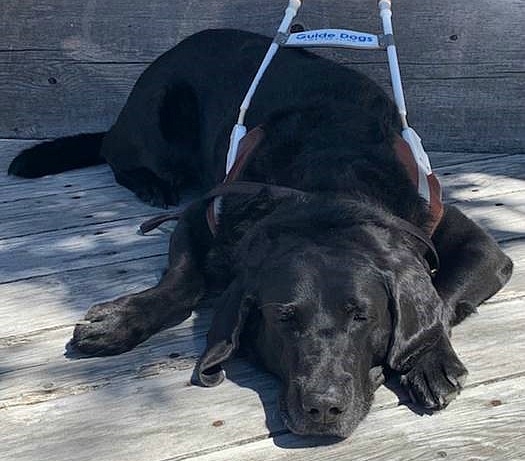
A black Labrador retriever guide dog lies in the sun.
By Grant Hardy
One of my favourite parts of AMI This Week is when we have the opportunity to take our show on the road, exploring all that this wonderful country has to offer beyond metro Vancouver.
Earlier this spring, we visited beautiful Tofino, B.C., a picturesque destination with friendly people, beautiful beaches and plenty of Canadian culture. If you haven’t had the opportunity to check out the July 8 episode of AMI This Week, I hope you’ll join Victoria and I as we explore the region together. Highlights include co-host Victoria Nolan’s accessible surfing lesson, where she does an incredible job picking up the nuts and bolts of surfing while I wait wistfully ashore with her lovely dog, Alan. They also include a tour of the fascinating Kwisitis Visitor Centre, where I learn how to distinguish subtle differences between animal tracks from dogs, wolves and cougars; and the Shorepine Bog Trail, an accessible hike on a level boardwalk that rests on the surface of a bog, where we learn more about this fascinating and delicate ecosystem. It was truly a treat exploring the region with Victoria and spending time with her. She is both a wonderful advocate for accessibility, and a heck of a lot of fun to co-host AMI This Week with. And the incredibly even-tempered Alan was the best production assistant ever.
Later this summer, you’ll be able to catch a couple of other pieces we filmed for AMI This Week while on the road. The first is an accessible rowboat invented by prolific inventor John Pimlott, based out of Nanaimo, B.C. I’ve met John in person more than once and he’s an absolutely incredible guy. His appetite for making water sports accessible for people with disabilities is insatiable. John’s latest invention is a rowboat that is incredibly stable for everyone but includes an attachable electric assist motor that can assist rowers with disabilities. For example, if you’re only able to row with the use of one arm, the electric assist motor can compensate by providing power on the other side of the boat. We interviewed a gentleman with multiple sclerosis who benefits from John’s boat, including, occasionally, the electric assist feature. I also got the opportunity to give the boat a try myself. Although I didn’t use the electric assist feature, I took directions from John via cell phone on the beautiful, calm lake near his home. The experience was very freeing, and I’d definitely love to try my hands at rowing again—literally.
Our other story, Soldier On, is an accessible recreation program for veterans of the Canadian Armed Forces who have PTSD or other disabilities. We joined them for interviews as well as an accessible yoga session followed by an intense afternoon of kayaking and hiking. What this group has accomplished is amazing, and I can’t wait to see how this story molds into an upcoming AMI This Week segment.
Every story we do on AMI This Week is both interesting unique. But I think our latest on the road segments are especially interesting. Be sure to tune in.
AMI This Week airs Mondays at 8 p.m. Eastern on AMI-tv. Watch full episodes and seasons of AMI This Week on demand at AMI.ca or on the AMI-tv App.
Touch Tour at the Art Gallery of Hamilton

Alex Smyth touches a sculpture.
By Andrea Hodgins
Everyone can delight in interacting with art pieces at the Art Gallery of Hamilton during their weekly Touch Tour, most recently explored by Toronto Bureau Reporter Alex Smyth on AMI This Week.
Tour guide/docent Marilyn Hollick describes the tour as "... a visual intimacy with art. By adding one more thing, touch, it’s one more way of describing art.” Marilyn says that by using the five elements of design—colour, line, texture, shape, form and touch—every guest can describe the art pieces in detail by the end of the tour.
Currently, only a few pieces are on the Touch Tour, and all are by Canadian artists. The bronze statue called “Woman Holding Skein,” by Elizabeth Wyn Wood, is a permanent piece at the gallery. The other exhibit on the tour is from the gallery’s first artist in residence, Reinhard Reitzenstein, who will be working at the gallery until early 2020.
Alex donned white touch tour gloves and went through each of the five elements of design with Marilyn on “Woman Holding Skein.” Marilyn has added touch when discussing texture, inviting visitors to compare skeins of real yarn to the yarn featured on the bronze bust. For a limited time, guests may take home a bookmark, created by Marilyn, with the five elements of design printed on it.
One of Reitzenstein's works in progress is a cut-up tree, which will eventually hang in the air and, with the touch tour in mind, will have felt added. Four bronze sculptures are presently part of the touch tour in the Reitzenstein exhibit, entitled “The Allegorical Minimalist.” At first, the pieces look like bare branches from a tree, but upon further inspection are actually sculptures made from bronze.
Visitors can learn more about Reitzenstein and his theme on one of the gallery's pillars. In black writing on a white background, allegorical minimalism is defined as “a paradoxical synthesis of the material and natural world, challenging the perceptions of the spectator (as critic) while denying not only a fixed interpretation, but the very possibility of interpretation itself.” If that definition is hard to interpret, so are his pieces. The description continues: “As an allegorical minimalist, Reitzenstein distills and combines forms to create works of art containing contradictory elements that unsettle the perceptions of the viewer. This process-oriented viewing experience frustrates reason and instead encourages the use of one’s intuition in the productions of meaning.”
The Touch Tours are located on the second floor of the gallery, surrounded by Hamilton designer Milli Gould’s fashion exhibit and the famous Kim Adams: Bruegel-Bosch Bus. Touch Tours can be booked from Tuesdays through Saturdays. For more information about booking tours call 1 (905) 527-6610 extension 272.
AMI This Week airs Mondays at 8 p.m. Eastern on AMI-tv. Watch full episodes and seasons of AMI This Week on demand at AMI.ca or on the AMI-tv App.
Grant’s Sea School Experience (Part 2)

A black and white image of a lake surrounded by trees.
By Grant Hardy
If you read Part 1 of my Sea School: Marine Science Camp experience, then you’ll know that the Vancouver team produced a half-hour documentary on a unique marine science camp held for blind and partially-sighted high school students on Vancouver Island.
With a camp as packed as this was with activities, I think everybody’s takeaway was different. For some, it was seeing grey whales up close for the first time. For others, it was being away from their homes and families in a new environment.
As someone who is passionate about the environment, my biggest takeaway was how delicate the ocean ecosystem is, and how much damage we as humans are causing to that ecosystem and, in turn, to ourselves. Whenever we visited a beach, we were instructed to leave it the way we found it—touch things carefully, but put everything back undisturbed, including rocks. Tempting as it is to find a nice smooth stone and hang onto it, it could be the shelter for a small animal.
But a lot of damage has already been done to the ocean ecosystem, primarily due to our insatiable appetite for plastics. Of course, plastic is a very versatile material and has many legitimate uses for health, safety, education and more. But as more than one Bamfield interpreter explained, the problem is our reckless use of single-use plastics, which make their way into our oceans and cause damage in a number of ways. Sea creatures can sometimes get entangled in them; but most worryingly, microplastics are often mistaken as food. These tiny plastics, and the toxic chemicals they contain, are devoured by small animals which causes the toxicity to work its way up through the food chain, through larger and larger predators, and eventually to us. I recall hearing that studies of sea birds have often found a significant portion of their body mass to be composed of plastic. On the news recently, I heard a tragic story of a sperm whale who washed up on a beach, with a stomach full of plastic.
This situation is terrible for the health of our ocean ecosystem, as well as our own health. I think many of us are aware that plastic isn’t great for the environment, but we figure that as long as we recycle our plastic, things will be fine. In reality, recycling alone won’t solve the problem, due largely to the energy inefficiency of recycling and the fact that many items never get recycled.
I, of course, can’t say I’ve given up all plastic, but I try to avoid single-use plastics like straws and plastic bags. Only by cutting back on our plastic appetite, and cleaning up the mess we’ve already made, can prevent the end of our ocean ecosystem as we know it.
Of course, raising awareness about these issues is why programs like the Bamfield Marine Science Camp are important to extend the reach of science to everyone. Along those lines, check out Sea School: Marine Science Camp on AMI.ca and the AMI-tv App to learn more about this fascinating camp.
Grant’s Sea School Experience (Part 1)

A sculpture of a whale.
By Grant Hardy
Our Vancouver team is currently busy working on a special called Sea School: Marine Science Camp, about a unique week-long camp at Bamfield Marine Sciences Centre on Vancouver Island where eight blind and partially-sighted high school students were immersed in the world of marine biology. This included whale watching, hands-on explorations on beaches and in wet labs, a beach cleanup, a rain forest walk and lectures from experts.
You can watch the special on May 24, but if you can’t wait to dive in (sorry, couldn’t resist), I’ll be sharing some behind-the-scenes perspective before it airs.
For me personally, this was a neat experience. I’ve always been passionate about the environment and am definitely interested in the ocean and how important—and fragile—it is. So having the opportunity to explore lovely, sandy beaches, interact with some of the sea creatures who call the ocean home, and learn about the perils they face, was great. It’s one thing to stick your hand into a tank at an aquarium and feel a sea cucumber, one who is used to being handled. It’s another thing to touch a sea cucumber on a sandy beach, have it curl up and start shooting water out of its end as a defence mechanism; or to find myself with a crab attached lovingly to my finger with its tiny pincers. All the while, knowledgeable staff are there to provide info about the beaches and the animals. And the beaches were less busy than the touristy ones found in metro Vancouver, so they were easier to explore independently.
As mentioned, we also did some whale watching. I loved being out on the boat, and it was great to see everyone’s excitement upon seeing the whales. But as one of only two totally blind participants, I would have loved for a more sensory whale watching experience. The organizers mentioned going on whale watching tours in Mexico where they were allowed to physically reach out and touch the whales. Realistically, I could only hear the small sound of water shooting out of the whales’ blowholes, which sounded like distant waves. But the description from others at least gave me an idea of what was happening.
Meeting the students, learning about their motivations for attending, and seeing them grow throughout the week, was really interesting as well. One blind student was used to having most things done for her by the adults around her but began to gain confidence and independence throughout the week. Another student plans on becoming a marine biologist herself, and totally immersed herself into the academics. While there were a couple “big city” folks like me, I found that most of the students came from smaller communities in B.C. In many cases, services for these students are much scarcer, so experiences like Marine Science Camp are more critical than ever. Even in the big cities, visual and attitudinal barriers make science in school less accessible than it should be. Yet access to science is critical in this time of increased environmental sensitivity. It’s also needed for almost all of the jobs these students will be applying to.
Speaking of the environment, stay tuned to the AMI This Week Blog for Part 2 of this reflection, where I’ll talk about the environmental lessons I took away from Marine Science Week.
Sea School: Marine Science Camp airs Friday, May 24, at 7:30 p.m. ET on AMI-tv.
AMI This Week airs Mondays at 8 p.m. Eastern on AMI-tv. Watch full episodes and seasons of AMI This Week on demand at AMI.ca or on the AMI-tv App.
March of Progress: Assistive technology updates for March 2019
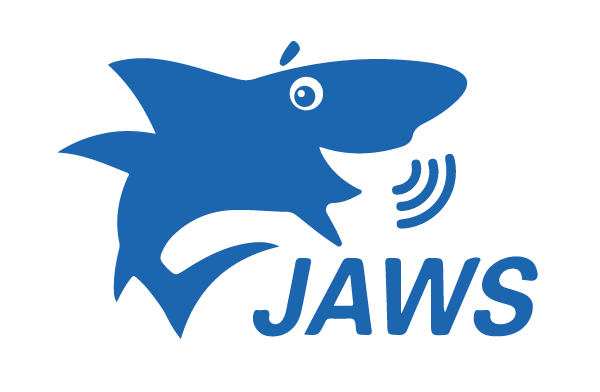
The Jaws screen reader logo.
By Grant Hardy
A Word Is Worth a Thousand Pictures
The last couple of years have seen the proliferation of apps and services that want to describe the world to us. Microsoft’s excellent Seeing AI app for iOS, for example, uses artificial intelligence to describe faces and facial expressions, objects, text, and even handwriting that it sees in photos. This app has recently gained support for the iPad. It has also been enhanced with support for photo exploration by touch. Selecting the “explore photo” button wherever it’s available, such as the scene channel, enters a mode where you can slide your finger around the touch screen to examine the relationships of objects to one another in the photo. You’ll hear soft music when you’re touching a place on the screen where Seeing AI doesn’t detect anything. But when you put your finger over a person, object or text, you’ll hear a “ding” sound followed by a description of the object you’re touching. For example, you might hear “30-year-old woman with brown hair looking neutral.”
In this way, you can gain some sense of where objects are positioned, such as whether everyone is standing side-by-side or if two people are standing in front of a car. Truth be told, it still doesn’t replace a human describer, and if you have an organized photo library with clear descriptions of each photo, you’ll greatly enhance your experience maintaining your photo collection. But this is still a neat application of artificial intelligence, and an evolution of a great app that can describe a surprising amount of content with no sighted assistance required.
This month, another player has entered this space: JAWS, the popular screen reader for Windows. With their latest Picture Smart feature included with the March 2019 update for JAWS, customers can submit photos that they’d like described. JAWS will submit these to many of the major third-party players, like Microsoft and Google, to give you the best description possible. It can also recognize objects, text, landmarks, landscape details and text.
While this feature isn’t unique, it will be great because of its availability. Its integration with JAWS means you’ll be able to recognize just about anything—controls in inaccessible apps, images you find on web pages, and even the contents of the clipboard. In fact, JAWS creates a special Picture Smart folder within your Pictures folder. Copy any photo to this folder, and it’s automatically submitted for analysis.
The following hotkeys are available when using this feature. They all begin with the JAWSKey+SPACEBAR followed by P, for “picture”:
• A: acquire an image from a scanner
• C: describe the image associated with the current control, like an image on a webpage or in an Email message.
• F: describe the photo you’re focussed on in File Explorer.
• B: describe the image on the clipboard.
• Question mark: get help with these keystrokes.
Results are shown in the JAWS Results Viewer, which you can navigate using standard navigation commands including arrow keys. When you’re done reviewing the description, press ESCAPE to close the window.
Conclusion
We’re probably years away from our computers behaving like little humans, dutifully describing every detail of our photos with the accuracy of a sighted assistant. But you can still get some pretty accurate photo descriptions using these services. If nothing else, you should be able to tell whether you’re posting the cute nature shot you took to social media, or the scanned copy of your ID card. That’s a big deal!
Grant Hardy gives Powerchair Soccer a try
Grant Hardy sits in a powerchair, ready to play soccer
By Grant Hardy
Recently, I took part in a story for AMI This Week about the Vancouver Power Soccer team. Power soccer is a bit like mainstream soccer, only you kick, block, and otherwise interact with the ball using a special power wheelchair.
I was struck by how dedicated, diverse and talented this team is. And, with a leap of faith, the coach and the organizers let me try something I wouldn’t normally have the opportunity to do: drive the powerchair. Normally, my experience with sports involves sitting on the sidelines and cheering from afar, so it was really interesting to get a hands-on experience that I don’t normally have.
A powerchair operates a little like a videogame. You have a joystick that can go in all directions, and by applying whatever amount of pressure you want to the joystick, you can opt to barely move at all or to zoom down the court at a breakneck pace. This was a lesson I quickly learned, as I covered the gymnasium in seconds, heading towards our videographer at an alarming pace. Slow and subtle movements with the chair are perfect for sending the ball in the exact direction you want it to go. Zooming down the court as fast as you can go is an incredibly exhilarating feeling. Hitting the ball with the chair is also fun. In my case, the coach lined me up, so I did it in a very controlled manner, but professional powerchair soccer players have to use that same joystick to operate their chair and mobilize around the court, plus send the ball where they want it to go.
I was left with a sense of gratitude for the coach and organizers, who let me try something unique and interesting that I wouldn’t normally get to do. And I’m intrigued by the sport of Powerchair Soccer, which is fast-paced and interesting.
If you’re keen to learn more, keep an eye—or an ear—on AMI This Week for our upcoming piece on Powerchair Soccer.
AMI This Week airs Mondays at 8 p.m. Eastern on AMI-tv. Watch full episodes and seasons of AMI This Week on demand at AMI.ca or on the AMI-tv App.
Alex Smyth encourages an AMI adventure in Edmonton
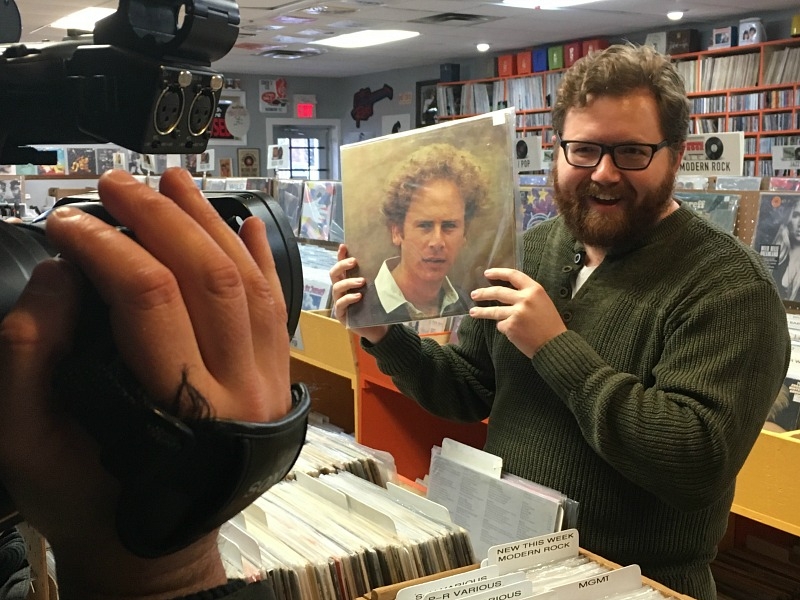
Alex Smyth smiles, holding an Art Garfunkel record in his hands.
By Alex Smyth
Twenty months ago, I began my journey with AMI and accepted the position of Bureau Reporter (then called Broadcast Presenter) with the Edmonton team. It was a big leap for me as I had always lived in Ontario and hadn’t even visited Alberta before my move.
I can easily say that it was one of the best decisions that I ever made. I was able to step into a position that opened a world of opportunities for me, and I joined an amazing team that offered lasting support during my entire stay in Edmonton.
Not only is the team fantastic, but in the role of reporter, I was able to try some once-in-a-lifetime experiences. I panned for gold in the North Saskatchewan River, interviewed hockey legend Lanny MacDonald at centre ice in the Saddledome, interviewed Grammy-winning musicians, met gold-winning Canadian Paralympians, drove an autonomous vehicle, covered the Canada Deaf Games, and so much more. There is the freedom to travel outside the city to film segments for both AMI This Week and original documentaries. I was also fortunate to visit Northern Alberta, Calgary, Winnipeg, Ontario, Quebec and many more places covering stories for AMI.
However, the best part of the job is being able to share the stories of the community we serve and learn about the amazing work people are doing to improve the lives of others. These have been the stories that leave the biggest impact. I still vividly remember meeting young Zach Abdalla, Calgary’s Honorary Sight Night Chair. There was Super Fly, a clothing line designed for people with mobility issues, which started because the founder saw her husband struggle to dress himself and wanted to do something about it. I visited The Lending Cupboard, a non-profit organization that rents medical equipment for people who needed it, because medical costs can be so high.
These are only a small sample size of the stories I covered in my role, and you could have the opportunity to do the same.
I recently accepted the open position in Toronto and have taken the opportunity to continue to share amazing stories back in my home town. It was bittersweet to accept the position as I was excited for the chance to work in Toronto, but sad to say goodbye to my amazing team in Edmonton.
I am so happy, however, to share the opportunity to work in Edmonton for another lucky person because the city is fantastic, with so many kind and friendly people, as well as an amazing group that feels more like a family than work colleagues.
As a Bureau Reporter, you play a major role in the production of television segments for AMI by participating in research, conducting interviews, hosting documentaries, and being the face of the bureau. The job is a truly rewarding experience as you share stories from the disability community that will help inform, inspire and entertain audiences.
Working in Edmonton, you become part of a small but amazing group of people. The four-member team works closely together, and you couldn’t ask for better people to spend your time with.
If you want a career that allows you to travel throughout the country and beyond, participate in amazing experiences, meet interesting people and share their stories, the Bureau Reporter position in Edmonton may be the opportunity you’ve been waiting for. Jobs in television are extremely competitive, so the chance to join a fantastic team in a rewarding career is an opportunity you can’t miss.
To learn more about the Edmonton Bureau position, go to the Careers page and follow the instructions to apply.
Grant Hardy: Blindfolds

A woman sits in a boat with a blindfold over her eyes.
By Grant Hardy
Recently my colleague Dave Brown wrote a post on the Bird Box Challenge, discussing the bizarre series of videos where sighted people try to carry out activities blindfolded. I’d like to offer my own perspective on the issue, since blindfolds are routinely used in education, fundraising and for entertainment.
In the midst of learning about the eye in my Grade 8 science class, our teacher asked to borrow my cane so she could blindfold the class and give them a taste of what walking around without sight was like. Happy to be in the spotlight, I handed it over and the kids spent the next half hour contentedly bumping into the furniture, laughing at themselves and each other, and generally enjoying a rare opportunity away from their desks.
Though, at the time, the activity seemed harmless, looking back on it now, years later, I wish I had questioned it. I have to wonder what message my class gained from this activity. While I’m not personally offended by sighted people blindfolding themselves, my concern is that it perpetuates harmful stereotypes about blindness.
Many people who have had similar experiences talk about how panicked, disoriented, and even sad they felt losing their sight for a few moments, and how relieved they were to get it back. Yet this is not at all the experience that a normal blind person has on a daily basis. The reasons are simple: skills and familiarity. Sighted people who blindfold themselves lack the skills to travel with a cane, recognize people by their voices, use technology without seeing it, and carry out other everyday activities. But someone who has been blind all of his or her life knows how to do all these things. And because they’ve been practicing for years and years, they have experience that blindfold-wearers don’t. More importantly, a blind person with the right skills and opportunity can live a normal, happy life. While blindness presents some inconveniences, it doesn’t define who you are. It’s not all-consuming, and a “professional” blind person doesn’t have the same panic, sadness, or cluelessness that a blindfolded sighted person does.
I think there are legitimate reasons to wear blindfolds and practice non-visual techniques, mainly for people working in the field. Instructors who teach cane and guide dog skills need to do this to become familiar with the techniques they teach. But in most cases, a better way is simply to get to know folks who can’t see. Instead of blindfolding the class, invite a blind student to speak to the class and answer questions. I have done this through opportunities such as the Rick Hansen Foundation Ambassador Program, and I believe it’s a worthwhile experience for everyone. Kids usually ask lots of great questions, and are really engaged in the conversation. They learn that there are challenges, but that I’m still a normal person and can still lead a happy life. At the end of the day, I think that’s a more worthwhile message than letting a class of eighth graders loose with a cane for a half-hour.
AMI This Week airs Mondays at 8 p.m. Eastern on AMI-tv. Watch full episodes and seasons of AMI This Week on demand at AMI.ca or on the AMI-tv App.
Grant Hardy on No Vacancy: Vancouver’s Housing Crisis
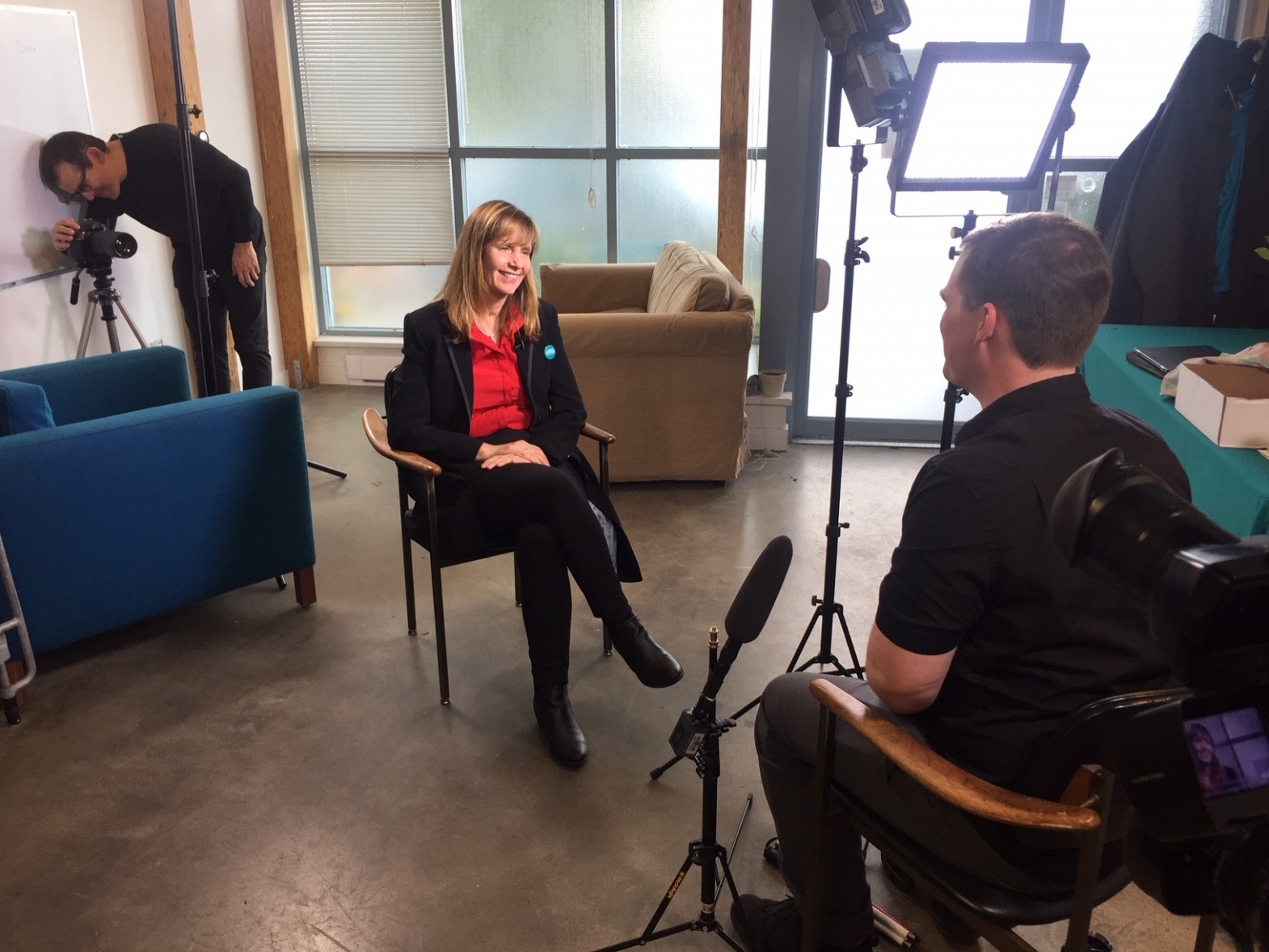
Two people sit facing each other, surrounded by television equipment
By Grant Hardy
If you’ve ever experienced an essential appliance failure, a water leak, a power outage, or any other temporary inconvenience at home, then you know how awful it feels when your sanctuary doesn’t work or feel as it should.
Now multiply that feeling by imagining your home isn’t accessible, you know your home is temporary, or you lack a home at all. No Vacancy: Vancouver’s Housing Crisis explores the housing crisis in our beautiful city from the perspective of some of the most vulnerable people in the region.
While working on this documentary, one thing that has become fascinating is the precarious position tenants have in the rental market. For starters, there’s the fact that we don’t, in fact, have the right to a home. Of course, most people do have homes—but despite the rights we do have in today’s society, housing isn’t one of them. Ironically, our laws surrounding rental control can be just as detrimental to tenants. Since landlords can charge new tenants exponentially more rent than existing tenants, it means there is an economic advantage to evict loyal, existing tenants. While they cannot do this directly without cause, many landlords try to do so with the pretext of needing to renovate the suite. This practice, known as renoviction, sometimes results in small, cosmetic changes to the suite. Meanwhile, the landlord can prepare to rent to a new tenant—at a higher rate. Luckily, there are advocates out there, and we hear from an incredible lawyer who has spent her career dedicated to poverty law, including helping tenants facing eviction.
It was humbling to see how many people were willing to open up to us about their most private struggles. In one case, Ria, a single mom struggling to find an accessible unit for herself and her daughter who uses a wheelchair, agreed to open up to us despite her discomfort because she knew it was such an important topic. Johnny, a vulnerable tenant living in a poorly maintained suite in Richmond, B.C., revealed the deficiencies in his home to demonstrate how powerless many renters feel. Heather, a senior who traded pet sitting for shelter after losing her home to a fire, relived her story for us with the dog she was looking after close by for emotional support. Her story proves how vulnerable we all are to sudden changes in our living situations. In every case, our interviewees’ openness and earnestness are the foundation of our documentary.
Despite blaming the housing crisis on popular scapegoats like foreign ownership, it’s often our own attitudes and resistance to inevitable change which lead to a lack of affordable housing. Change is tough, especially when building accessible, affordable housing means months of construction, or re-zoning and restructuring one’s neighbourhood. Yet the alternative is abandoning the diverse city that Vancouver is, which would be very unfortunate.
There’s something in No Vacancy: Vancouver's Housing Crisis for everyone, and no matter what your housing requirements or current housing situation is, you’ll learn something from this one-hour special.
Stream No Vacancy: Vancouver's Housing Crisis on AMI.ca or the free AMI-tv App.
Grant Hardy's Dot Watch Review
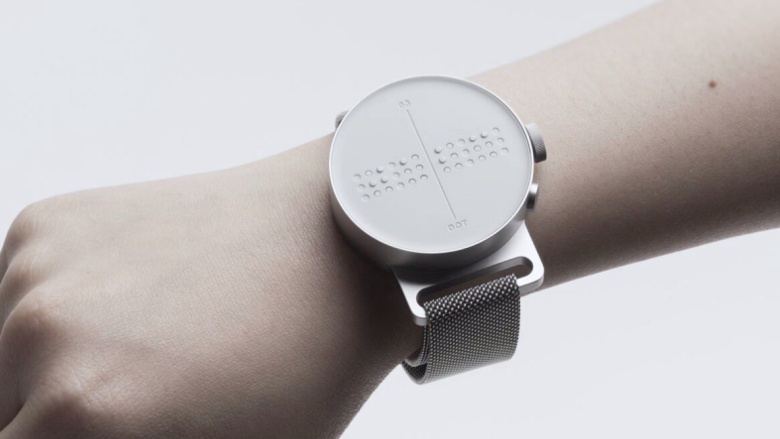
A Dot Watch on an arm
Introduction
The Dot Watch is an impressive Braille smart watch designed for blind users and features four Braille cells on its face. These offer privacy as you check the time down to the second, review notifications from your smartphone and access other watch functions like timers, alarms and a stopwatch. You can use the watch on its own as a basic Braille timepiece, but you’ll get the most out of the Dot Watch if you pair it with your smartphone. You can do so using the free Dot Watch smartphone app, which can be downloaded from the Apple App Store or Google Play store.
Look, feel and usage
I wouldn’t normally delve into packaging, but in the case of the Dot Watch I was particularly impressed. Firstly, the box is compact and durable, so you can save it in case you need to store or service the watch. Markings such as the product name and logos were included in Braille on the packaging. And Braille materials in the packaging include tactile diagrams of the Dot Watch and even a primer on the Braille symbols, if you want to study up. The smartphone app also includes a guided tutorial, and the company provides an online manual and FAQ pages to help get you up to speed with the Dot Watch.
The watch comes with a metallic band that’s easy to attach with a magnet. On its face, the four Braille cells are in the centre and there’s a raised lip around the perimeter. I’d want to treat this watch fairly carefully, but I imagine the lip could save the Braille cells in the event of a fall or hard bump.
It’s surprising how much information can be crammed into just four cells of Braille. For example, the time is displayed using two digits for the hour and two for the minute. A second view shows two digits for the seconds, plus A.M. or P.M.
Below the second and third Braille cells there are tiny touch sensors. When tapped with your finger, these advance the Braille display forwards or backwards through content. Once you become used to reading on the Dot Watch, you can enter a mode where the display scrolls automatically at your preferred reading speed so you don’t have to use the touch sensors at all.
There are three controls on the right side of the watch. The select button, located towards the back of the watch, toggles between displaying the time in hours and minutes, seconds, and the current date. And when using a menu or function, it acts like an enter key. The digital crown is a wheel that’s used for scrolling through menus and, where appropriate, setting hours and minutes.
To set a timer, for example, you’d first press the select button to wake up the watch. Then you’d use the crown to scroll to the timer function in the main menu—abbreviated as “timr”—and press select. Finally, you’d use the crown to set how long you want the timer to run in minutes and seconds, pressing the select button after each. This interface is surprisingly simple and should be very easy to learn.
Likewise, to review recent notifications from your smartphone, you’d wake the watch up and scroll to the notifications section, abbreviated as “noti.” Press select to enter the list of notifications. Each is labelled with a number—1, 2, 3 and so on. Scroll through the list and “select” the alert you want to read. You’ll be able to use the Braille display and touch sensors to read the notification.
The final button, called home, puts the braille cells to sleep when you’re done reading to save battery power. The watch will also vibrate to acknowledge alarms and timers, plus an optional hourly alert.
The watch charges through USB and should be able to last for several days.
Advanced Features and Conclusion
The Dot Watch app includes many more features to play with. A Braille study mode lets you send whatever text you want to the Braille display, so if you’re trying to learn Braille, you have a great way of testing your knowledge. A memos function lets you save short snippets of text to the watch’s memory, possibly an account number that you’re trying to give someone over the phone and want a quick way of retrieving. Pressing the home and select buttons at the same time causes an alert to play on your smartphone, so you can locate it by listening. And there are many settings you can adjust to customize how the watch behaves.
Overall, I’m very impressed with the Dot Watch. I’ve wanted to review this product for a long time, and it’s clear the team has really pushed it to the limit. There are obvious constraints with only having four cells of Braille, but the advantage is you can literally take Braille anywhere. Whether you want to check the time under the table at a gathering so you don’t draw attention to yourself, or glance at notifications in a noisy restaurant, the Dot Watch is an interesting product that’s worth a look, or feel.
For more info about the Dot Watch, visit the website.
AMI This Week airs Mondays at 8 p.m. Eastern on AMI-tv. Watch full episodes and seasons of AMI This Week on demand at AMI.ca or on the AMI-tv App.
My Big Alone New York Adventure
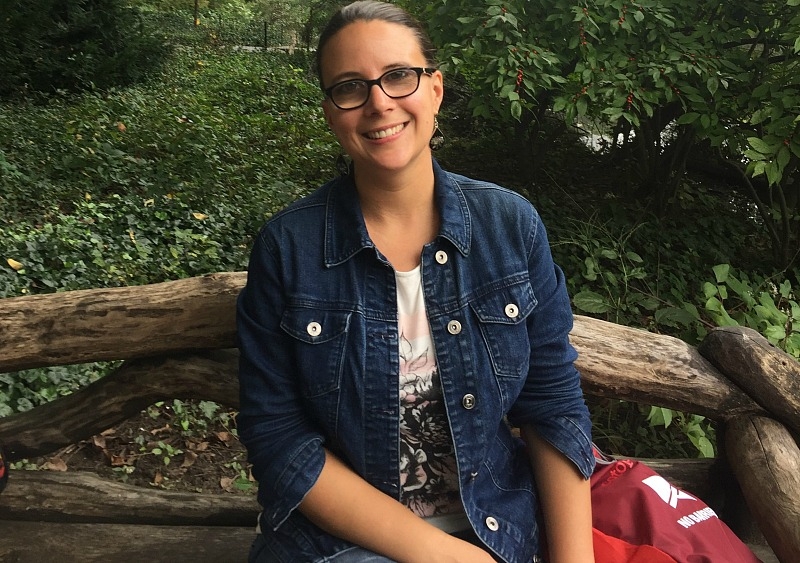
Laura Bain smiles as she sits in Central Park.
By Laura Bain
I had always wanted to go to New York City. Perhaps an odd desire since I don’t care about shopping and am easily overwhelmed by crowds. Still, something about the city called to me. So, when I heard about the 2018 No Barriers Summit New York City it seemed like the perfect reason to go.
I’d learned about No Barriers a few years earlier while randomly Googling “blind adventurer.” I was looking for a role model. I was looking for someone with sight loss who had done the things I wanted to do like travel and have outdoor adventures. One of the first people to come up in my search was Erik Weihenmayer, a blind adventurer who had climbed the highest peak on every continent, written several books, and helped co-found No Barriers, an organization which describes its mission as “to unleash the potential of the human spirit.” Lacking a totally clear picture of what the organization actually does, I felt drawn to it in a similar way I was drawn to the Big Apple.
Attending the two-day summit this past October was the scariest thing I have done in my entire life. Way scarier than my recent skydive. Jumping out of a plane strapped to an instructor, there was no way I could get lost. Not the case in New York City. I had no fears about the city itself. Perhaps only another blind person will understand, but my biggest anxiety was that I would be standing on the sidewalk in front of my hotel, and not be able to find my way inside.
I knew that my fears were somewhat irrational. If I ended up unable to find a building, or an entrance, I could ask one of the hundreds of people on the sidewalk around me for help. After all, this was New York City! Knowing that the regret of missing out is generally worse than the regret of a bad experience, I booked my flight and hotels. I tacked three extra days onto my stay so I could explore the city after the summit.
Feeling like I was exploding with excitement and anxiety, I flew into Newark, New Jersey, where I had arranged to travel in a shuttle van to my hotel in midtown Manhattan. With three New York area airports, thousands of people, and hundreds of shuttles, I couldn’t believe my luck that one of the other shuttle passengers was also attending the No Barriers Summit and staying at my hotel. It was dark and rainy by the time we were dropped off, and I would have likely hidden in my room for the night, but with my new friend (and sighted guide) Krissy from Virginia by my side I was able to venture out.
 The first day of the summit consisted of dozens of workshops that participants could choose from. The first workshop I had chosen was called “Dancing for Everybody No BS.” I’ve always found dancing awkward, partly because I can’t see what others around me are doing to follow along, so I thought it would be a good way to step out of my comfort zone. However, standing with the other participants while the instructor demonstrated moves and gave directions like “move your arms like this,” I felt my face burning with embarrassment. I had no idea what “like this” meant. After a few minutes, and in what I felt to be the spirit of the summit, I put my hand up and yelled out, “Excuse me, my name is Laura and I’m visually impaired and I don’t know what you’re doing!” Across the crowd a voice yelled back, “Hey Laura, it’s Erik and the team. Come join us!” That’s right, it was the very man who had inspired this whole trip for me! Together with Erik, and two sighted No Barriers staff, we laughed, struggled to learn the moves, and danced totally out of step with the group.
The first day of the summit consisted of dozens of workshops that participants could choose from. The first workshop I had chosen was called “Dancing for Everybody No BS.” I’ve always found dancing awkward, partly because I can’t see what others around me are doing to follow along, so I thought it would be a good way to step out of my comfort zone. However, standing with the other participants while the instructor demonstrated moves and gave directions like “move your arms like this,” I felt my face burning with embarrassment. I had no idea what “like this” meant. After a few minutes, and in what I felt to be the spirit of the summit, I put my hand up and yelled out, “Excuse me, my name is Laura and I’m visually impaired and I don’t know what you’re doing!” Across the crowd a voice yelled back, “Hey Laura, it’s Erik and the team. Come join us!” That’s right, it was the very man who had inspired this whole trip for me! Together with Erik, and two sighted No Barriers staff, we laughed, struggled to learn the moves, and danced totally out of step with the group.
The remainder of the summit, and my time in New York, unfolded in a similarly serendipitous fashion. The city-wide scavenger hunt on the second day of the summit took me and my five other teammates from Wall Street, to Brooklyn, and to the base of the Empire State Building where our task was to hug the building and take a photo! That day ended with a huge celebration in Central Park, with all of us dancing and wearing our No Barriers T-shirts which were printed with the phrase, “What’s within you is stronger than what’s in your way.”
New York City has many options for accessible visitor experiences. I would highly recommend Big Apple Greeter, a non-profit organization that pairs visitors with a “real New Yorker” to show them around the city. There was a space on the visit request form where I could indicate that I am partially sighted and wanted sighted guide from my greeter. My greeter Jo was amazing. She met me at my hotel and together we explored Central Park, Chinatown, Greenwich Village and more. She was an excellent guide and made a point of describing our surroundings and bringing me over to anything I might want to touch, like the iconic concrete steps of a brownstone or the highly-photographed “LOVE” sculpture at the corner of 6th Avenue and W 55th Street.
Speaking of art and touching, I would also recommend booking a “Touch Tour” at the Museum of Modern Art (MOMA). An experience which is only available to us blind and partially-sighted folks, I was given latex gloves and allowed to touch many of the sculptures. My MOMA guide also described in detail any paintings I was interested in.
My excitement around this trip was so big that I tried to keep my expectations reasonable. I hoped only to walk around a bit, eat something classically New York and feel the energy of the city. By the end of my six-day trip I had walked over 76 kilometres, used up a $20 transit pass, filled up on hot dogs, pizza and overpriced martinis, seen live music, and lazed around Central Park. I’d also made countless friends and met one of my personal heroes.
My take away from this trip, aside from the cheap I “heart” NY tee I bought in Times Square, is to lean into anything that makes me feel like I’m exploding with excitement and anxiety; to not limit myself. My big “alone” trip to New York turned out to be nothing but. It was filled with all the right people at the right times … and maybe a little New York magic?
AMI This Week airs Mondays at 8 p.m. Eastern on AMI-tv. Watch full episodes and seasons of AMI This Week on demand at AMI.ca or on the AMI-tv App.
Grant’s Smart Home Diary: Even Easier with Eve

An image of the Eve Energy plug
By Grant Hardy
Introduction
Setting up a smart home is both empowering and intimidating. It’s empowering because you can automate tasks which are tedious or simply hard to remember, like shutting off your lights when you leave the house. For people with certain disabilities, this could provide increased independence like giving someone without the use of their hands a means of switching on the lights via voice. But it can be intimidating because, just like picking out blinds, furniture, or china, there’s a vast array of devices and platforms to pick from, all of which operate differently.
Of course, there’s also a financial investment, but you can start with a smart gadget or two and grow your smart home as resources permit. Since I have an iPhone, I’ve gone with Apple’s smart home platform called HomeKit, which I think offers a great user experience. Keep in mind that in order for automations to work properly, you need a compatible iPad, HomePod or Apple TV that’s always at home.
I’m going to take a look at two smart home products: the Eve Motion and Eve Energy. Eve Motion is a motion sensor that can control your accessories, or simply notify you, based on whether there’s motion in a room. Eve Energy, on the other hand, is a smart plug that turns appliances you already own—like lamps, kettles and radios—into smart appliances. Plug your appliance into Eve Energy; plug Eve Energy into the wall; and keep your appliance switched on. Eve Energy will decide when it should get power or not based on rules you set.
Both devices are small enough to fit in one hand, and require no hard wiring or special installation beyond simply pairing them with one of your iOS devices through the Home App.
I’ll focus on the very basics, with three cool automations you can use to tech out your home using one or both of these devices. These are configured in the Home App on an iOS device.

Get notified when there’s movement
When no one’s home, there obviously shouldn’t be any motion activity. So if Eve Motion detects movement, it can notify you right away. At that point you could, for instance, contact one of your neighbours to ask if there’s something strange going on.
To set this up, do the following on your iPhone:
1. In the Home app, tap (double-tap for VoiceOver users) the “add/edit homes” button in the top-left.
2. Tap on “sensors” under the “notifications” section.
3. Tap on “Eve Motion.”
4. Set the “notifications “switch to on, tap “people”, then tap “when I am not home.”
5. Tap “back” twice, then tap “done” to back out to the main screen.
From now on, if there’s motion in the room with Eve Motion when you aren’t home, you’ll be notified on your phone. When you’re at home, you won’t be bothered with constant alerts as you move around.
Turn the kettle or coffee maker on in the morning
If you get up at a consistent time in the morning and want your favourite hot drink right away, set up an automation so Eve Energy turns your kettle or coffee maker on at the right time. Here’s how:
1. In the Home app, select the “automation” tab in the bottom-right, then the “add” button in the top-right.
2. Choose “a time of day occurs.”
3. You’ll land on a screen where you can pick the time you want your automation to occur, and on what days. Use standard gestures to adjust these settings, then tap next.
4. The next screen asks what exactly you want to automate. Tap your Eve Energy that’s connected to the kettle or coffee maker, then tap “next.”
5. Tap on your Eve Energy to toggle it on, then tap “done.”
Now you can wake up to the soothing sound—or smell—of your favourite hot drink.
Making Eve Energy and Eve Motion work together
For a final example, let’s say you want to have your lamp automatically turn off when you leave the room. For example, I own an extremely bright light which I use to help regulate my sleep cycle. But since it takes up a lot of energy, I might want to use Eve Motion to turn the light off when I’m no longer nearby. Here’s how to do it:
1. Connect the light to Eve Energy.
2. In the Home App, tap on “automations,” then tap “add.”
3. On the next screen, tap on “a sensor detects something.”
4. Tap your Eve Motion, then tap “next.”
5. On the next screen, tap on “stops detecting motion,” and then tap “next.”
6. The next screen asks what should happen when no motion is detected. Tap on the Eve Energy connected to your light, and then tap “next.”
7. On the next screen, make sure Eve Energy is set to off, and then tap “done.”
Now you’ll have peace of mind knowing your lamp won’t waste energy when you’ve left the room—even if you forgot to switch it off.
Conclusion
I’ve only scratched the surface here, but it’s clear smart home devices like the Eve Motion and Eve Energy have the potential to make your home more efficient, accessible, and maybe even fun.
AMI This Week airs Mondays at 8 p.m. Eastern on AMI-tv. Watch full episodes and seasons of AMI This Week on demand at AMI.ca or on the AMI-tv App.
A special effects transformation in Ottawa
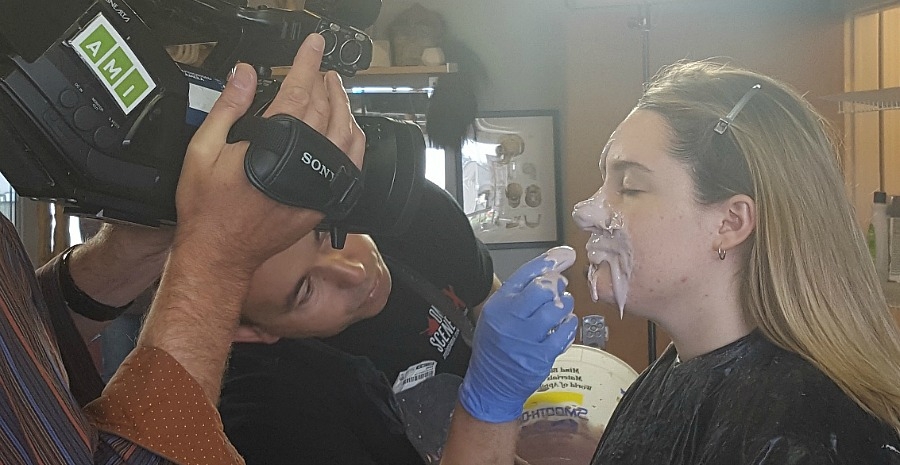
AMI This Week bureau reporter Shelby Travers
By Shelby Travers
Makeup has been a passion of mine for a decade now. It’s not because I find it makes things pretty, but more due to the transformation abilities it possesses. For example, every day I wear makeup I contour my nose to transform the appearance to make it less bulbous-looking. Since a Halloween story was needed, I figured a different type of nose makeup transformation was required.
There were so many steps involved in transforming me into the gross, old, witch that you experience on AMI This Week. With our stories only being so long we weren’t able to fit everything in, so this is the behind-the-scenes scoop.
We had talked about the life cast process but let me tell you that was an experience all in its own. It could probably even be a full story. I was nervous going into it. I knew a little bit about the process before it happened so knew I would be completely covered in a silicone substance, and then have plaster put overtop, making me completely restricted from sight and speech. I think this would make most people a little nervous – and I was no exception.
It wasn’t that I was nervous or afraid of not being able to see or talk, but about how breathing would be and for how long I would truly be restricted. The special effects artist, Michel, made me comfortable and assured me the whole time. While he was putting on the first layer of silicone, he paid close attention to my nose to make sure my only source of breath was still exposed. Every once in a while, my nostrils would get covered and I would go into a quick state of panic, but Michel would quickly clear the airway.
The whole process took about 20 minutes of being completely covered; 10 minutes for the silicone and 10 for the plaster. This is where the blind perks come in handy. Being able to use my phone without sight is something that I’ve gotten used to over my decade of limited vision. So, naturally, I was still able to do all my texting and selfie-taking during the whole process, making it actually quite relaxing.
Once the plaster had completely hardened, it was time to take the mould of my face off. I could touch the inside of it, but it didn’t really feel like much. Only once I came back to the On Scene FX studio one week later was I truly able to experience my face from a whole new perspective. Full disclosure, I did do one of the biggest blind misconceptions – I touched a face. I think we all know that – as much as movies like to think that blind people touch faces to see what they look like – we don’t. Unless it’s a life cast, apparently.
Touching your own face doesn’t really feel weird because it’s attached to your body. So, your brain makes the connection and its no big deal. However, when you’re touching your face and it isn’t attached to you – well, it was weird.
The whole experience was amazing, and I learned so much about a field of makeup I always wanted to. I’ve now developed that relationship with Michel and he has invited me back anytime I want to learn more. And if you are to know anything about me, it’s that I love trying new things, so I’ll definitely be taking him up on that offer.
AMI This Week airs Mondays at 8 p.m. Eastern on AMI-tv. Watch full episodes and seasons of AMI This Week on demand at AMI.ca or on the AMI-tv App.


